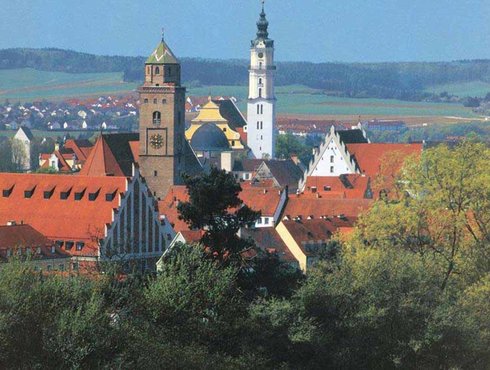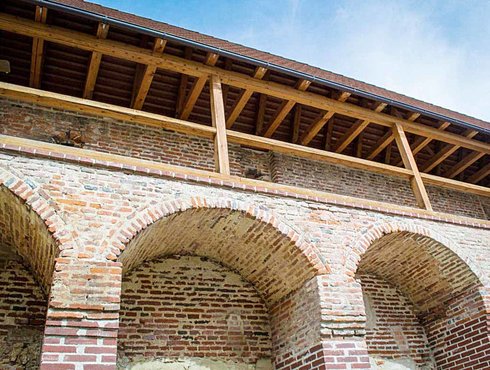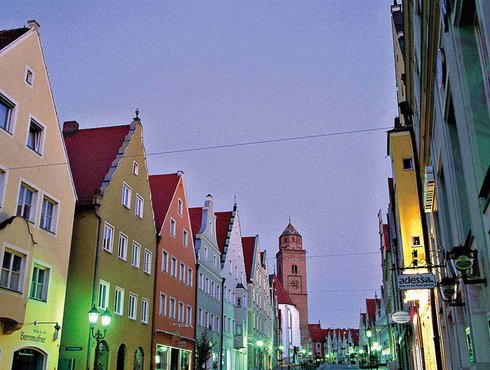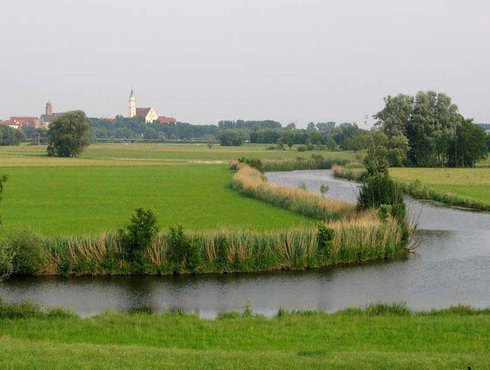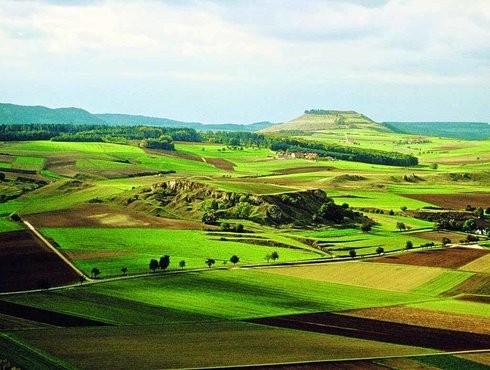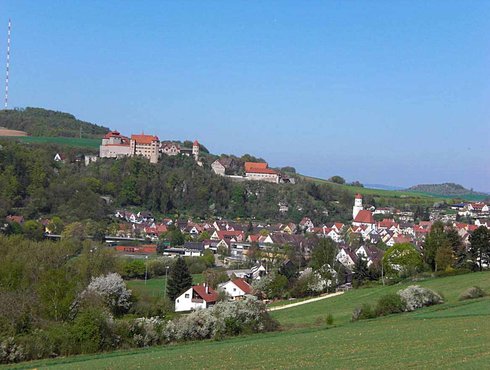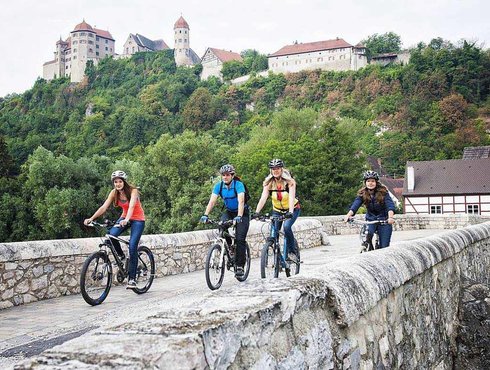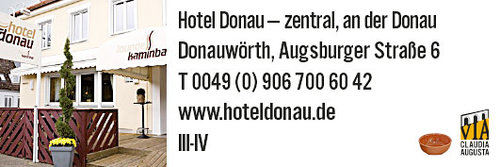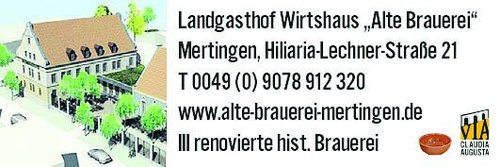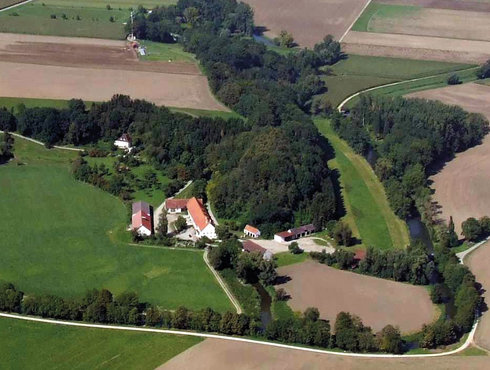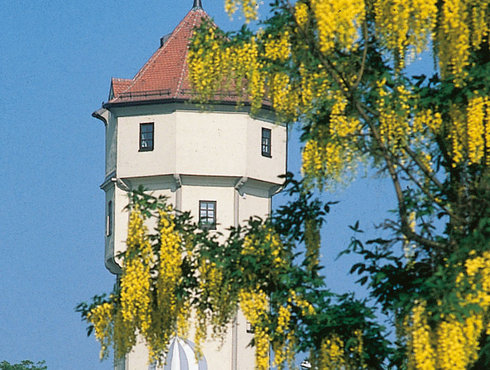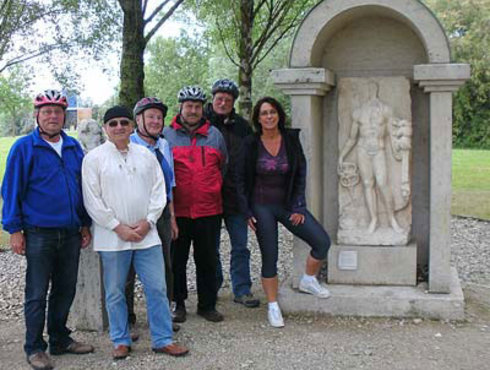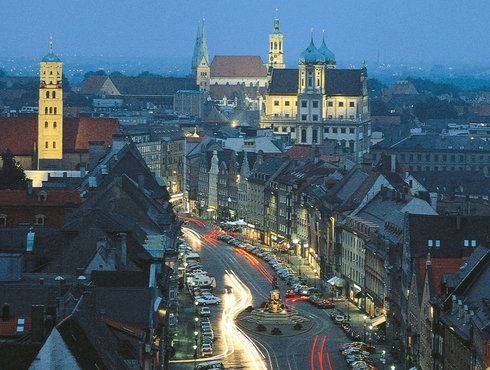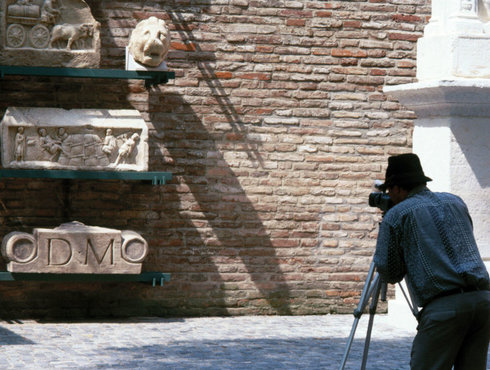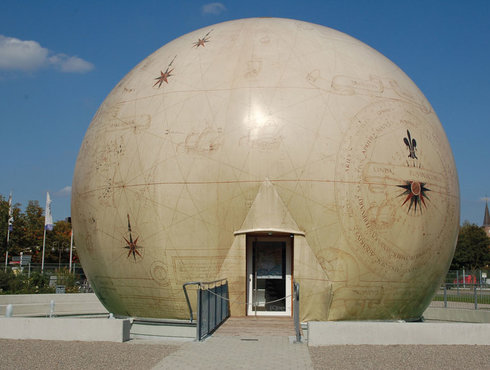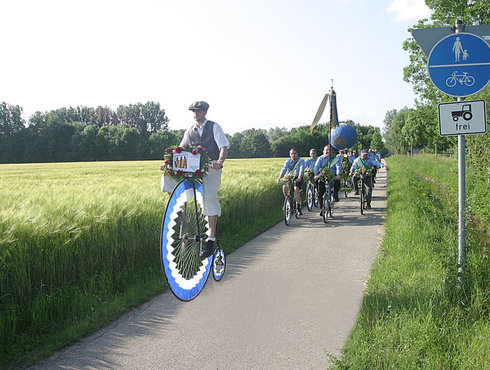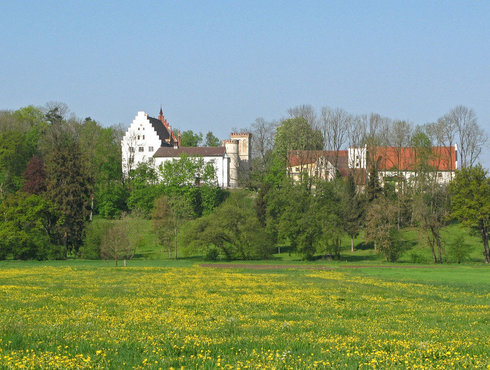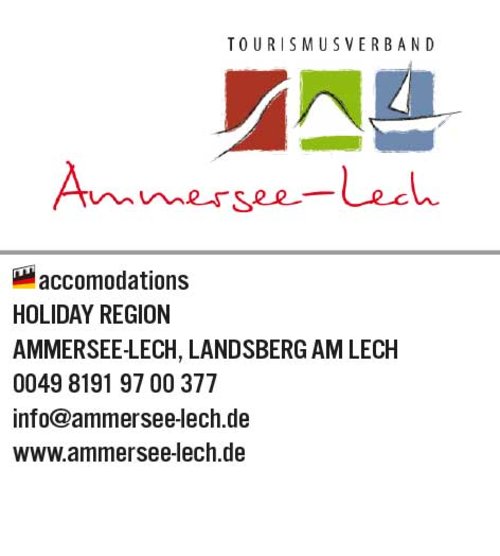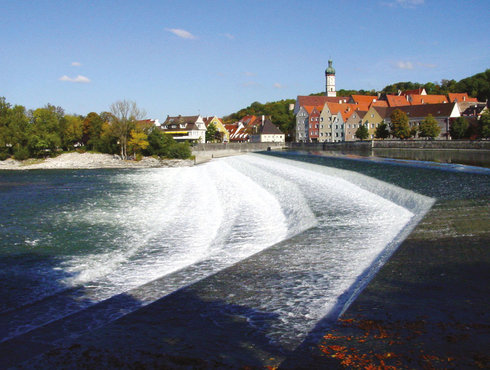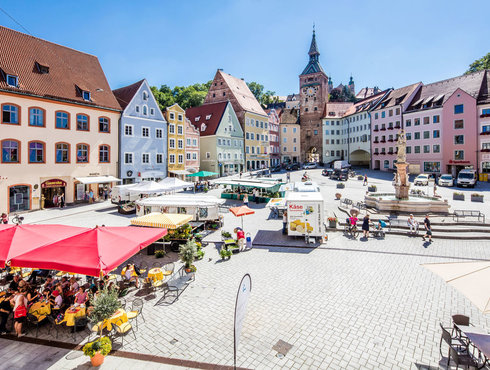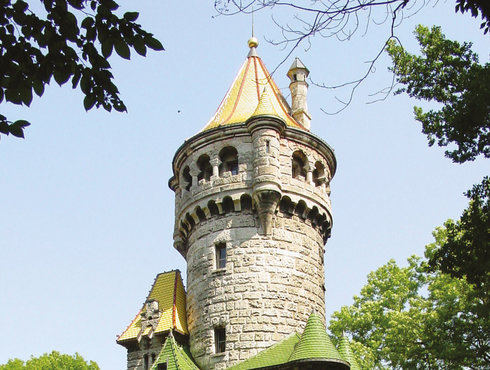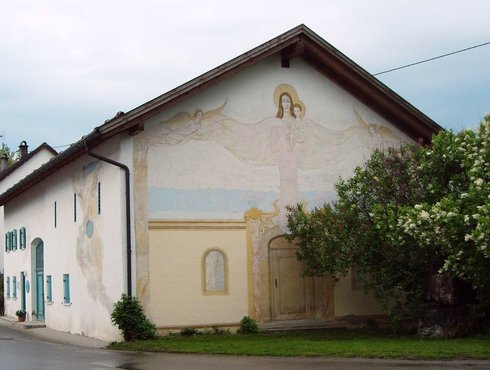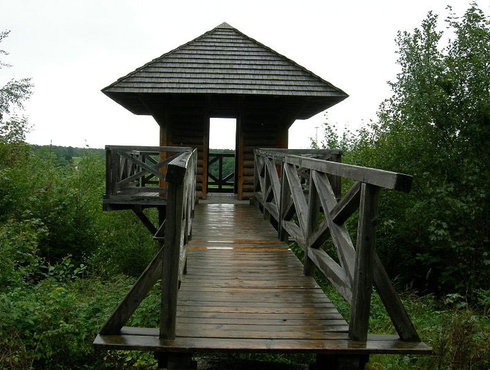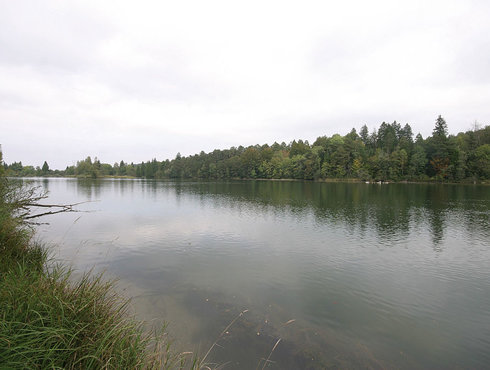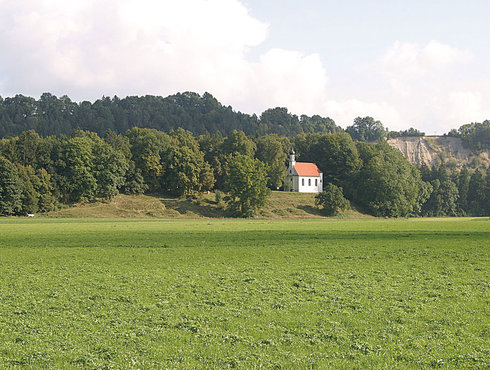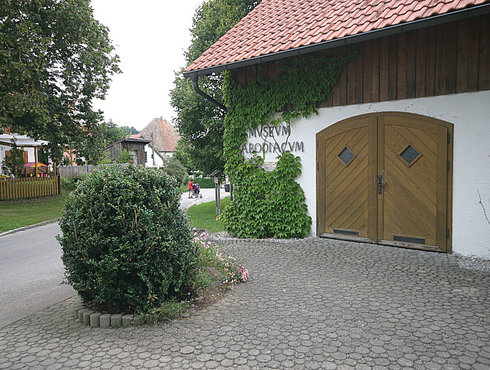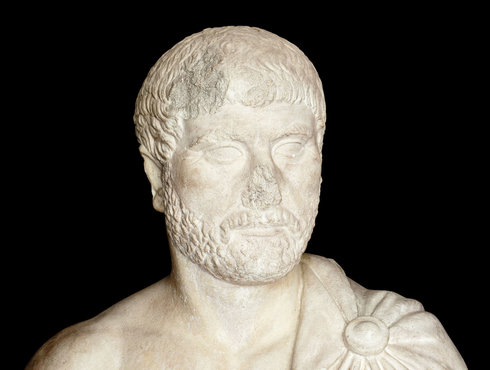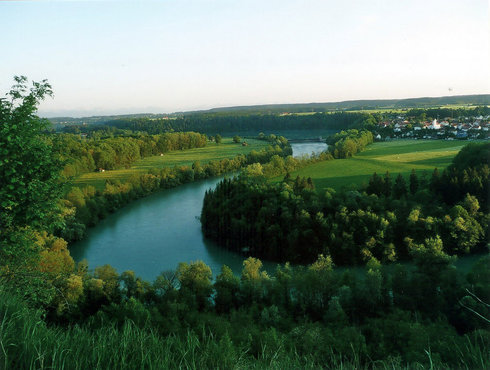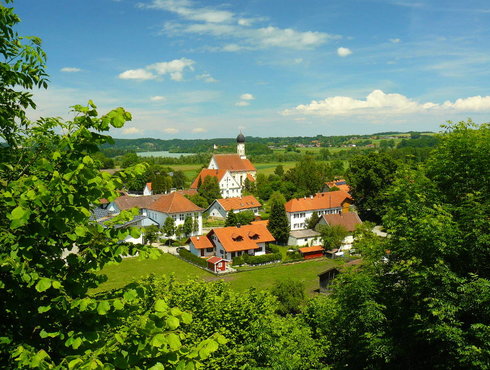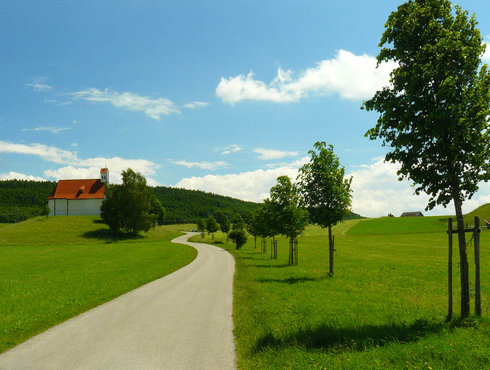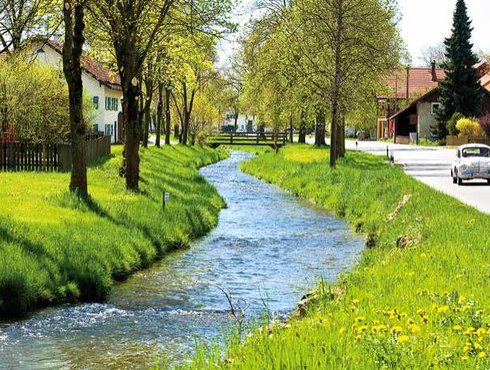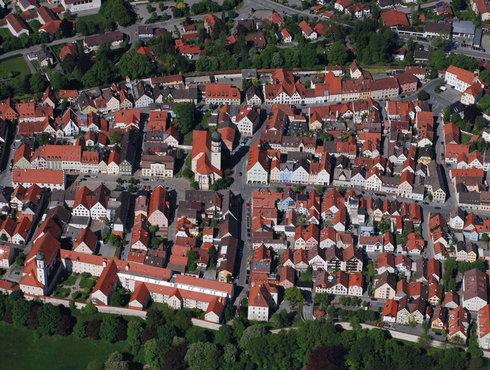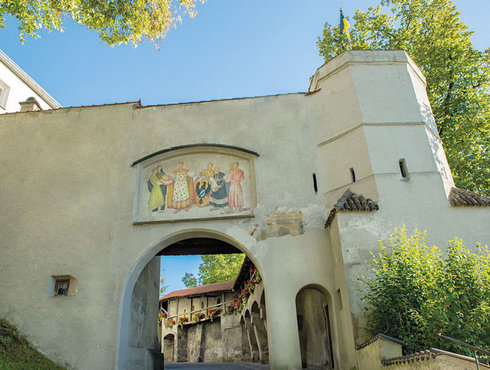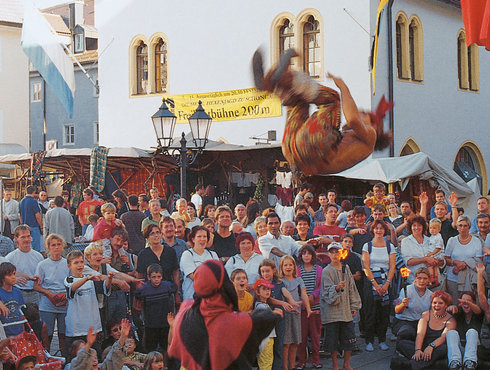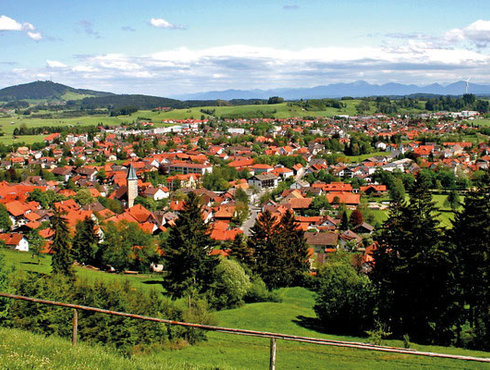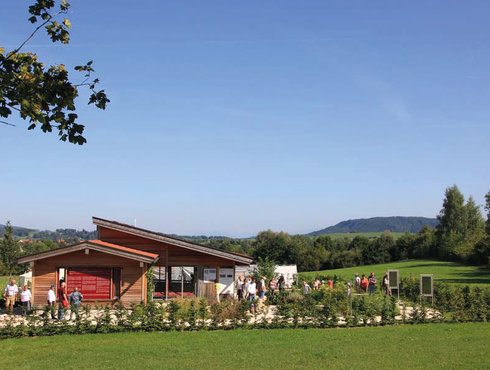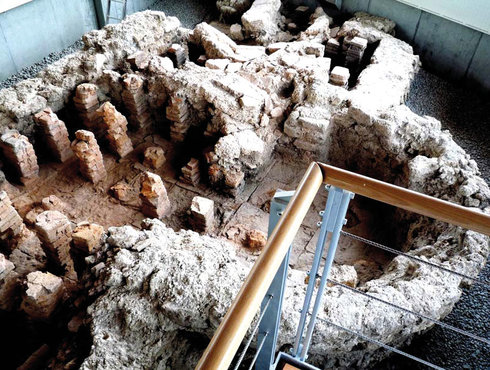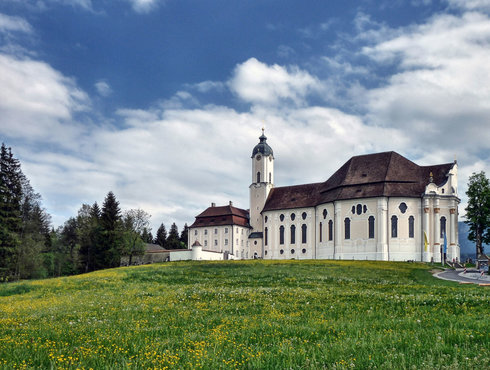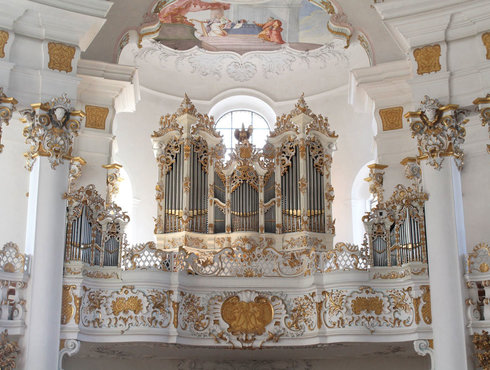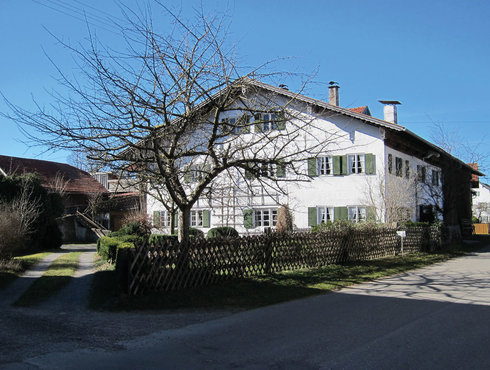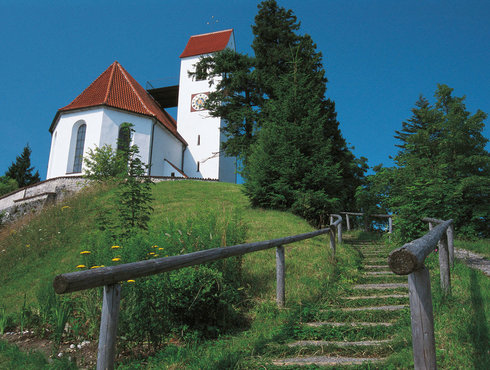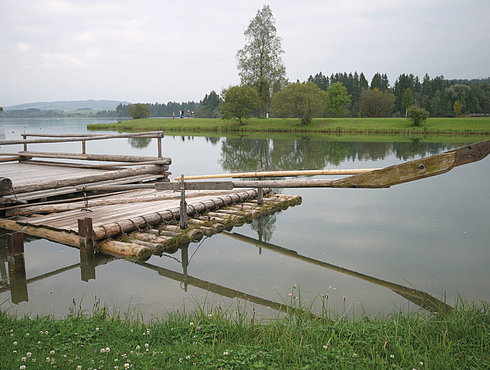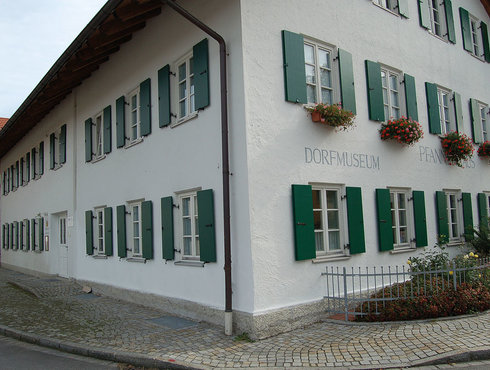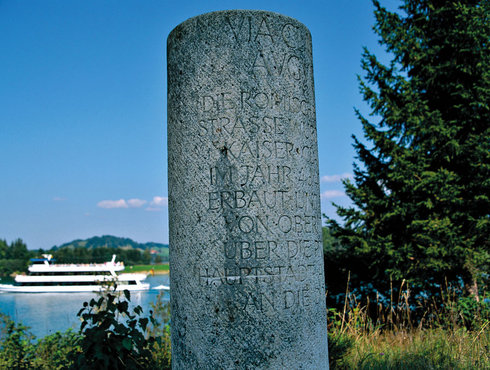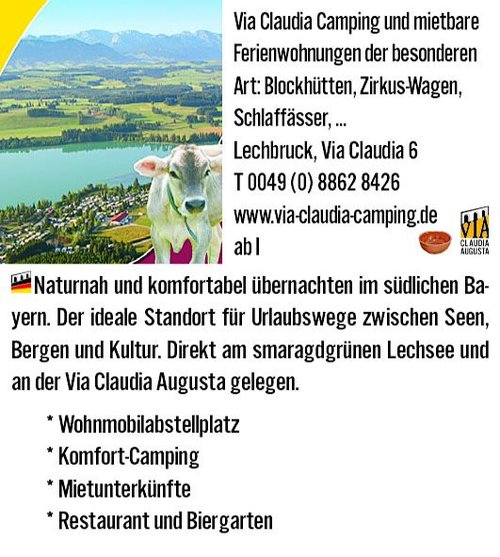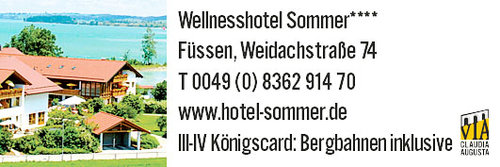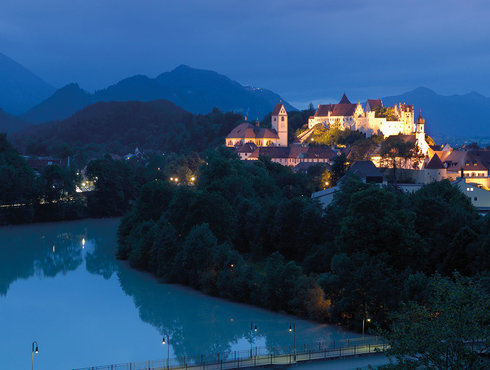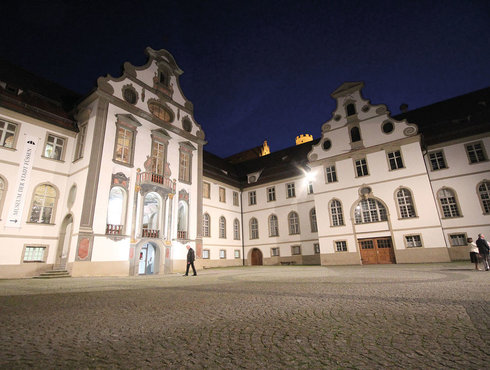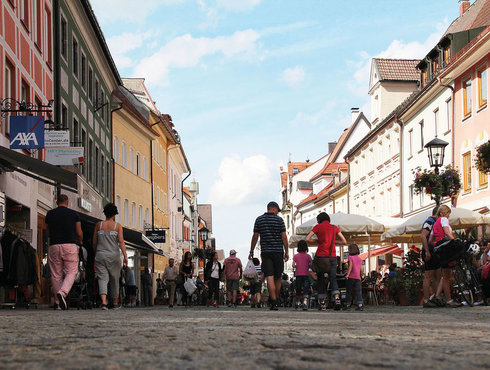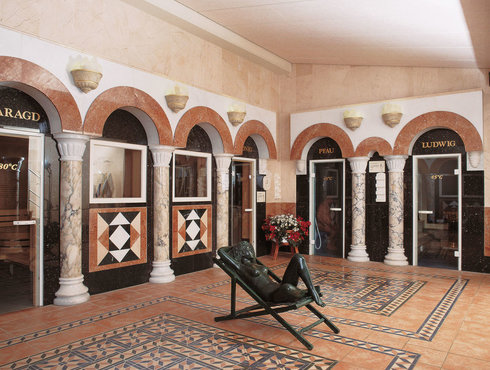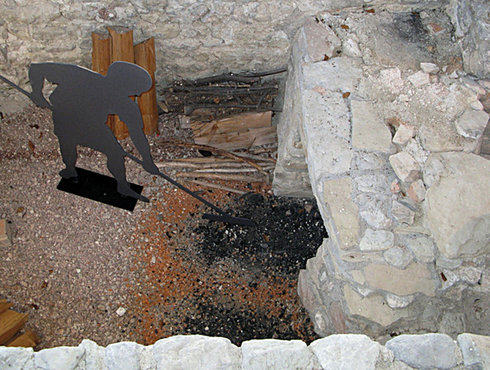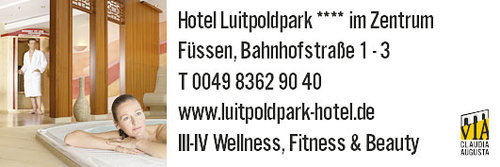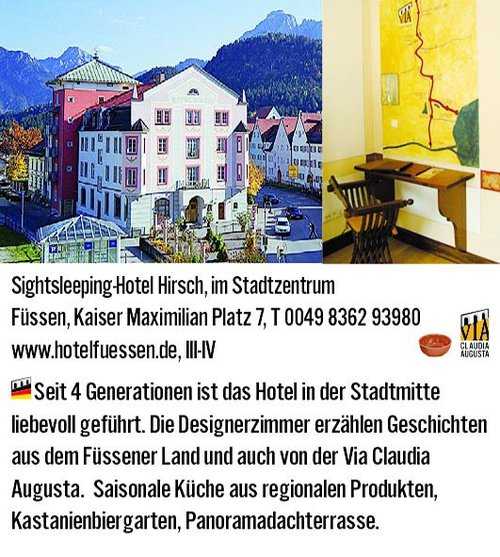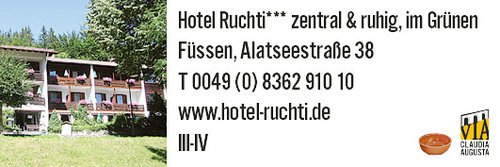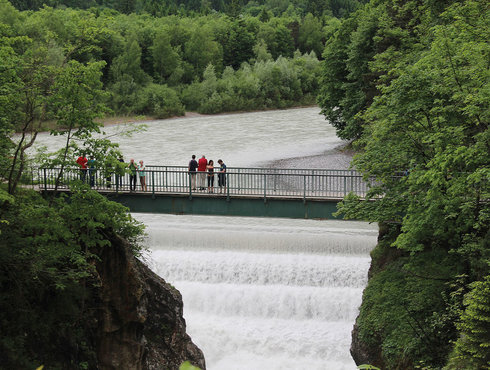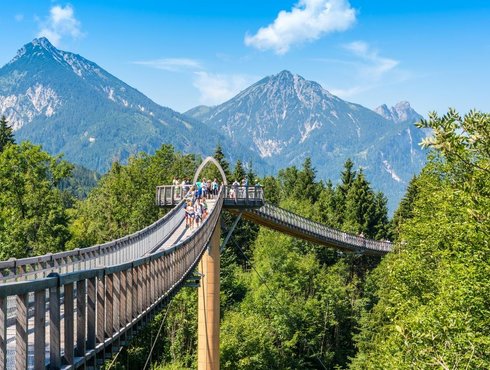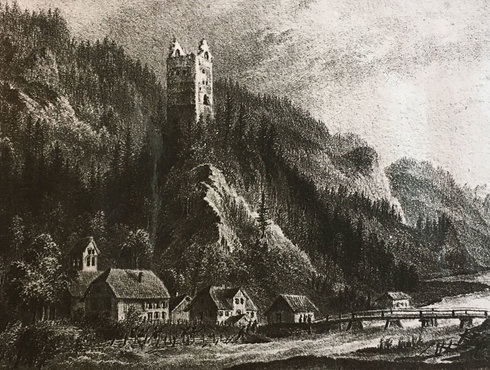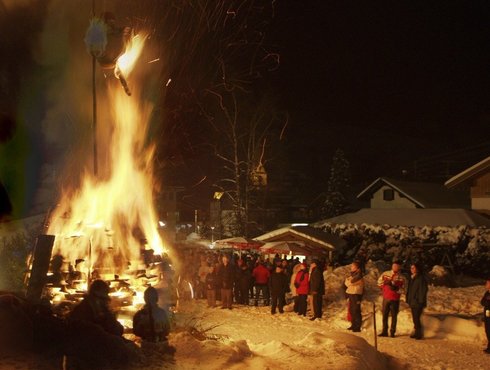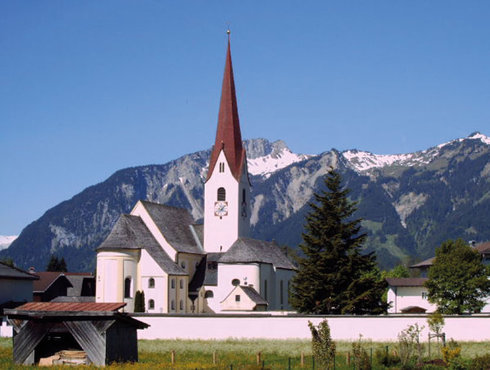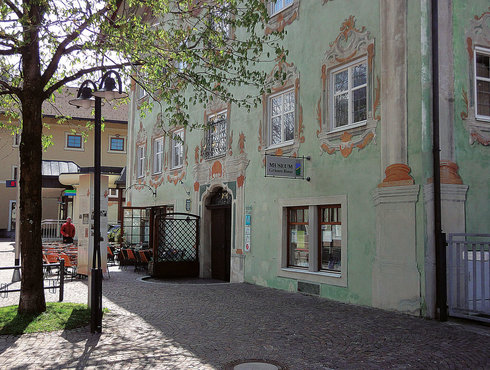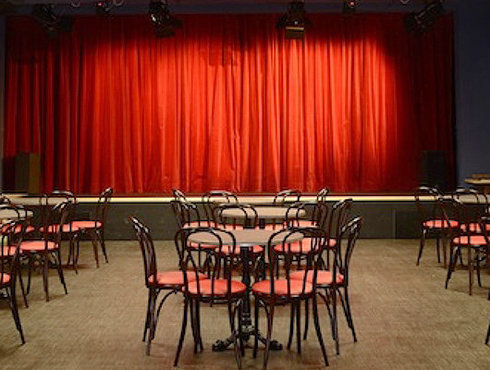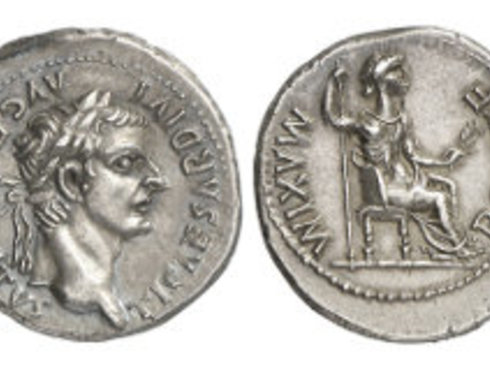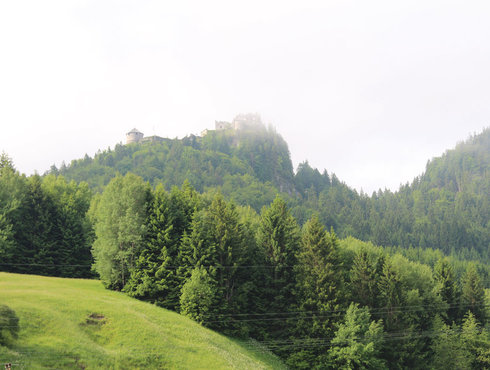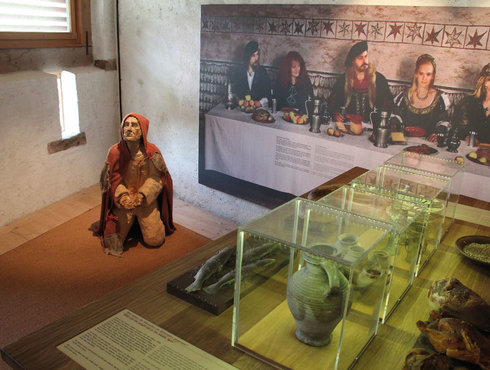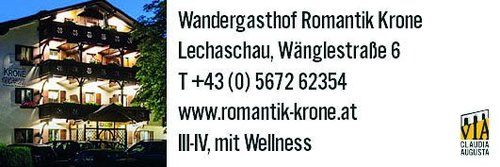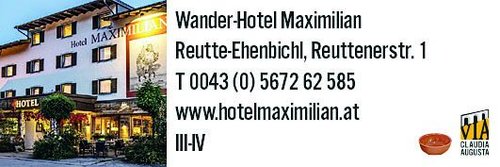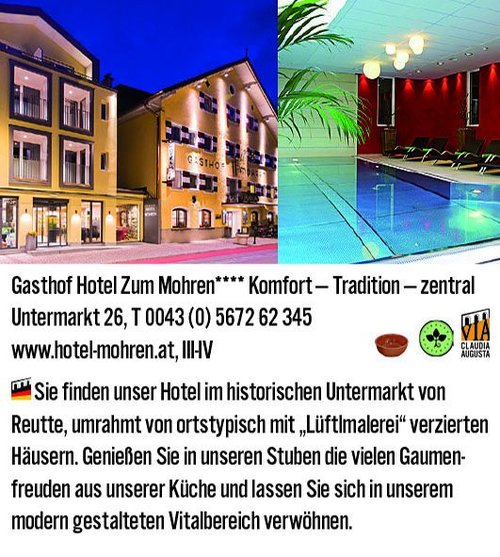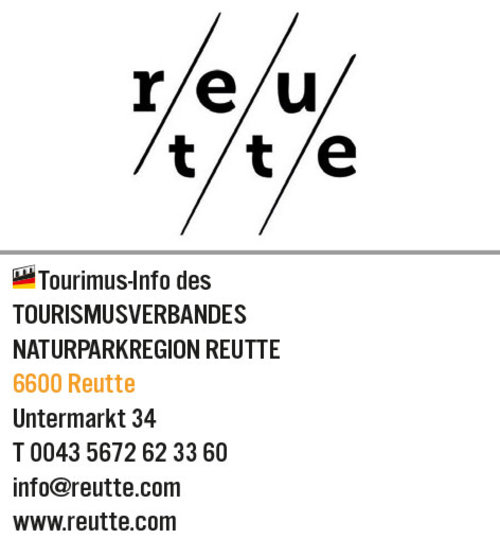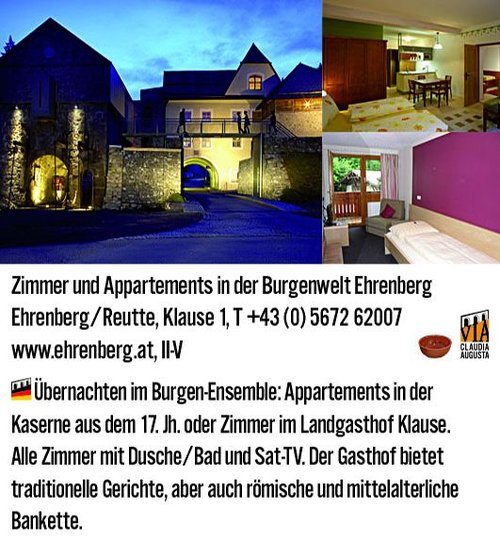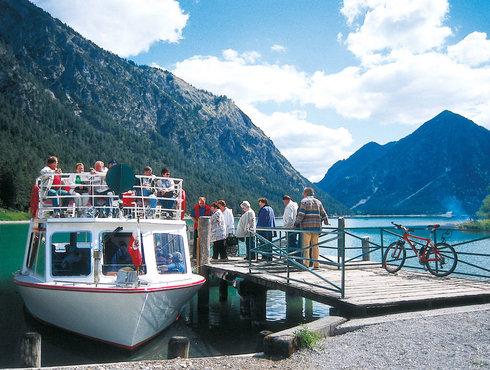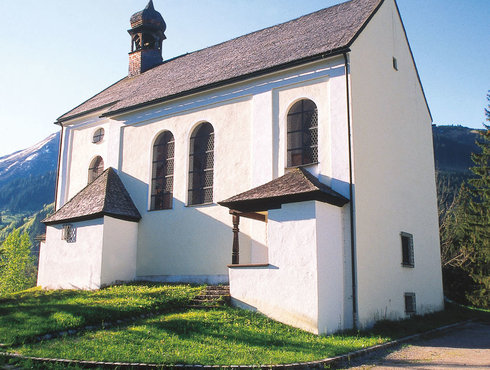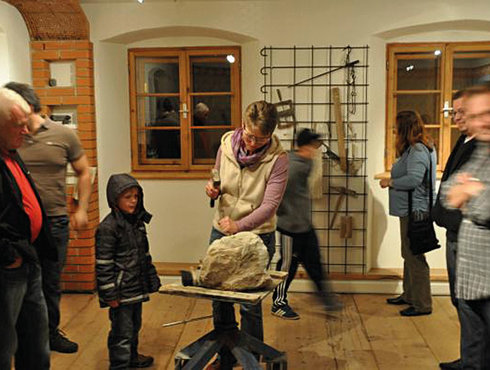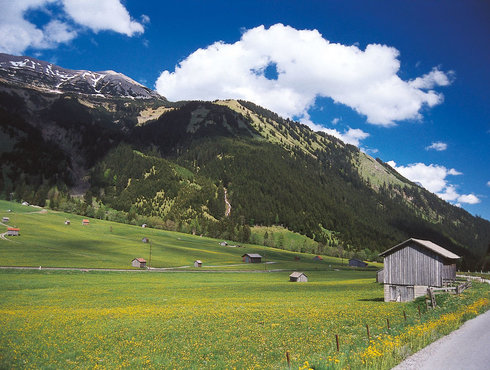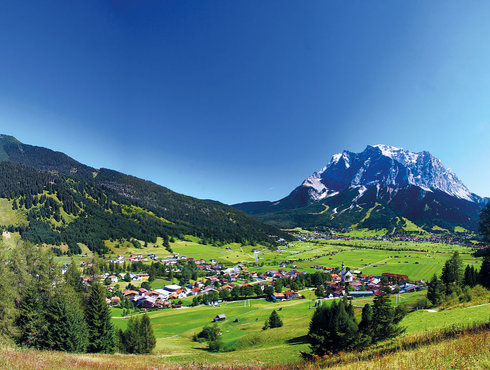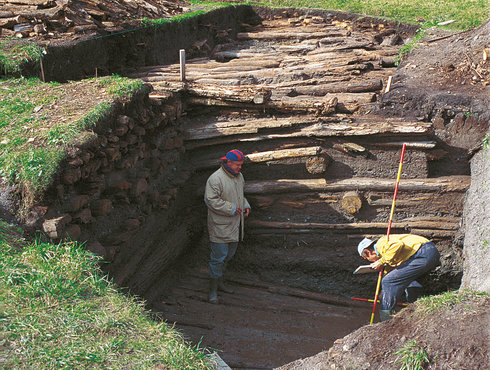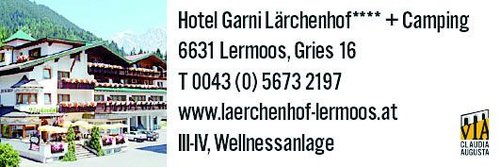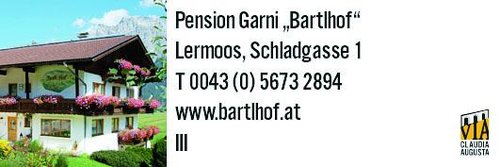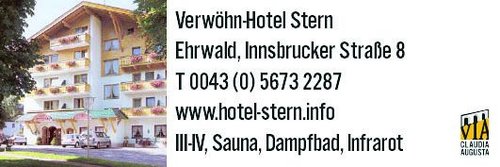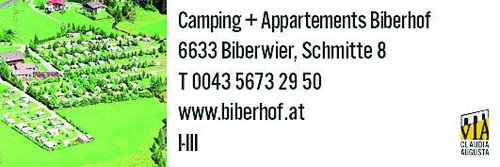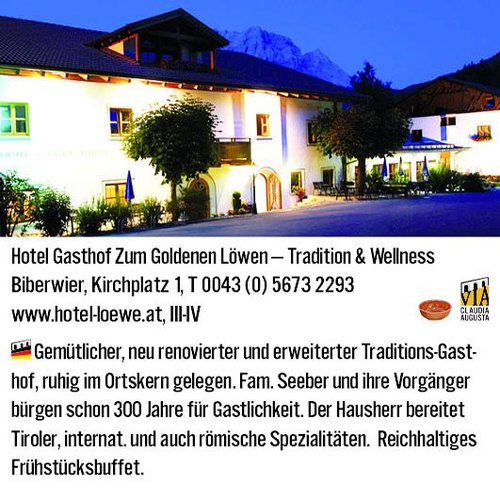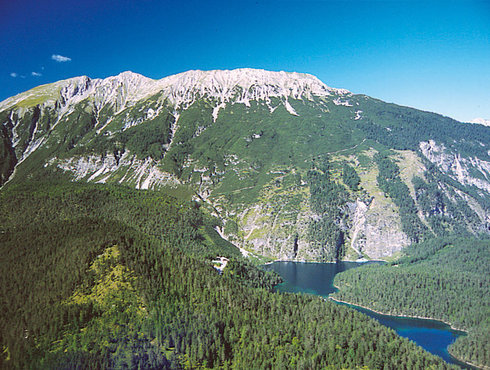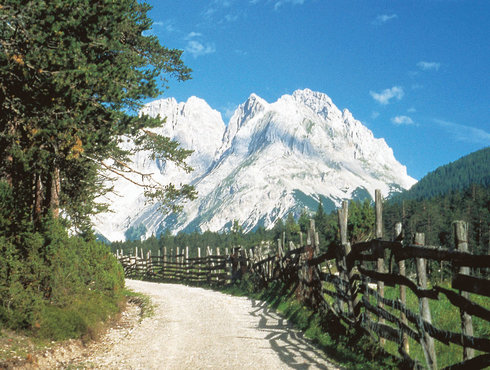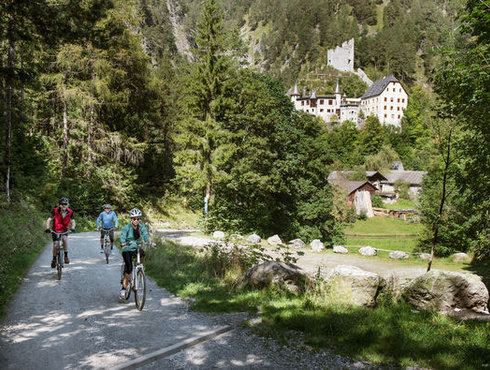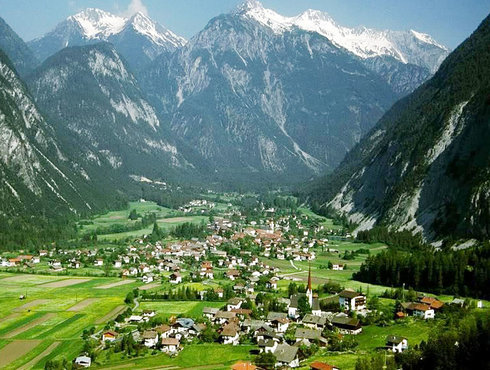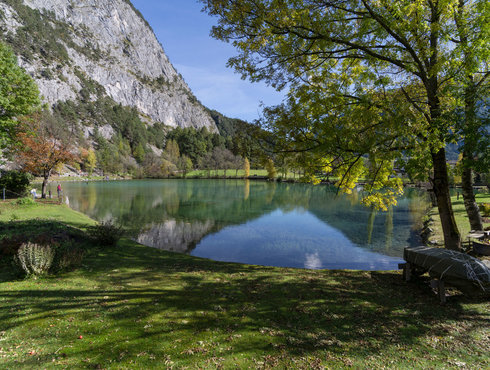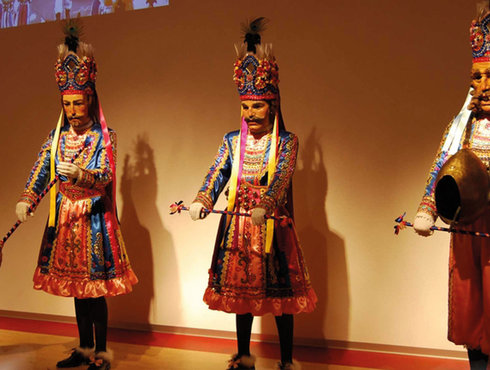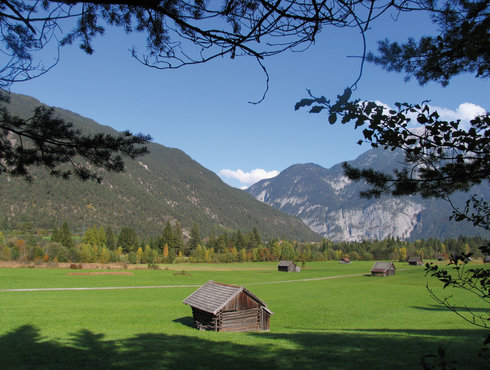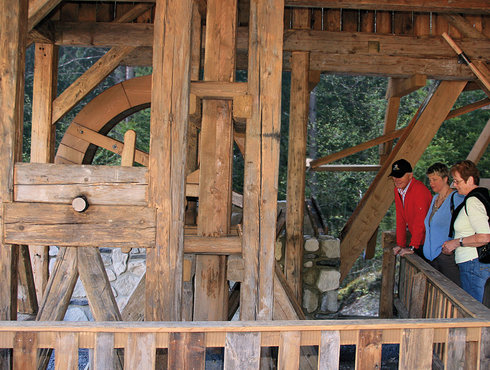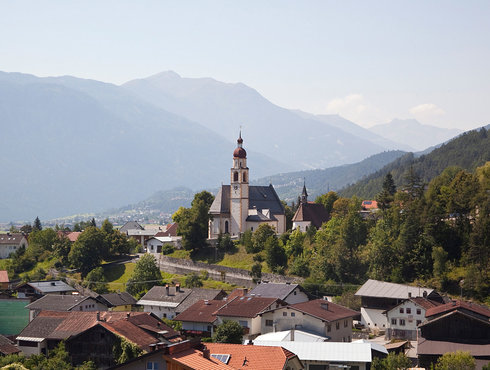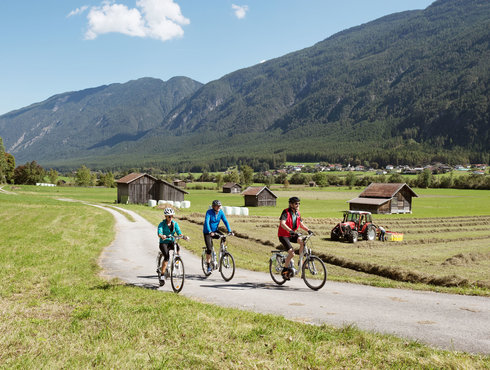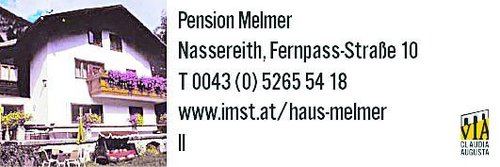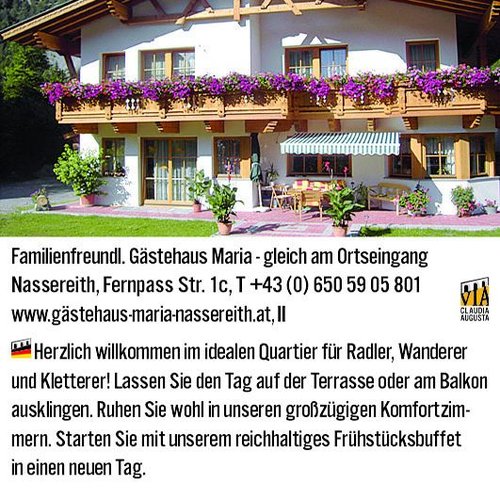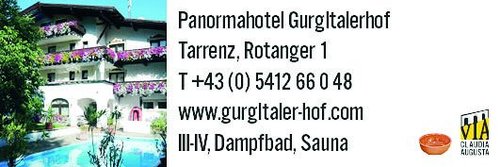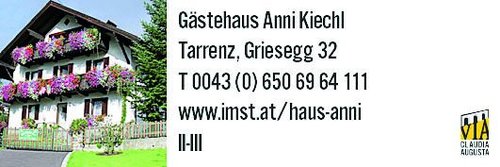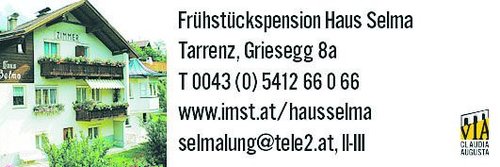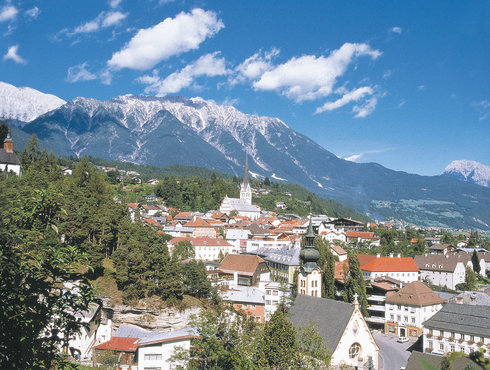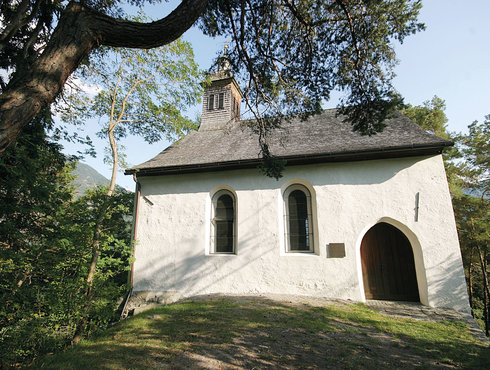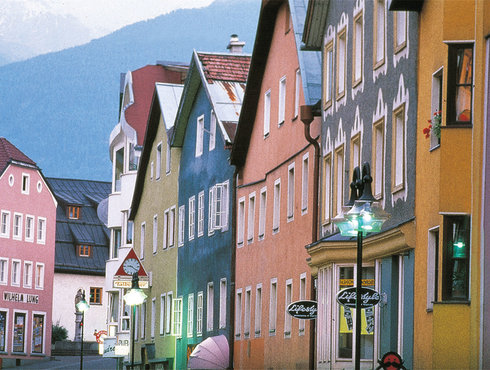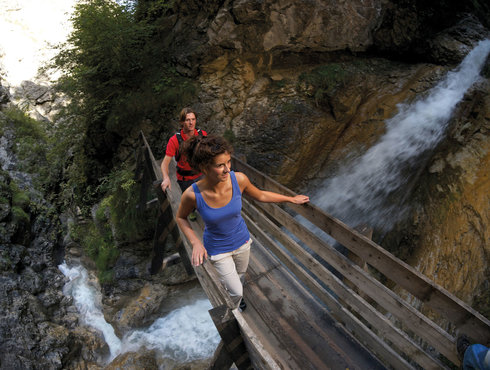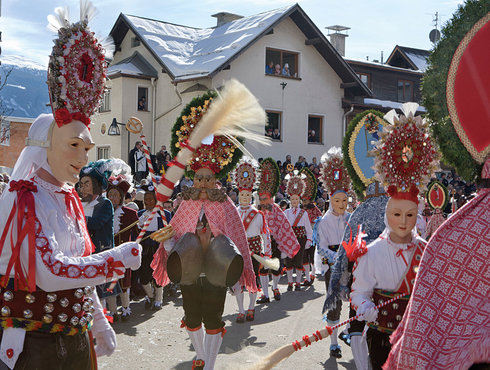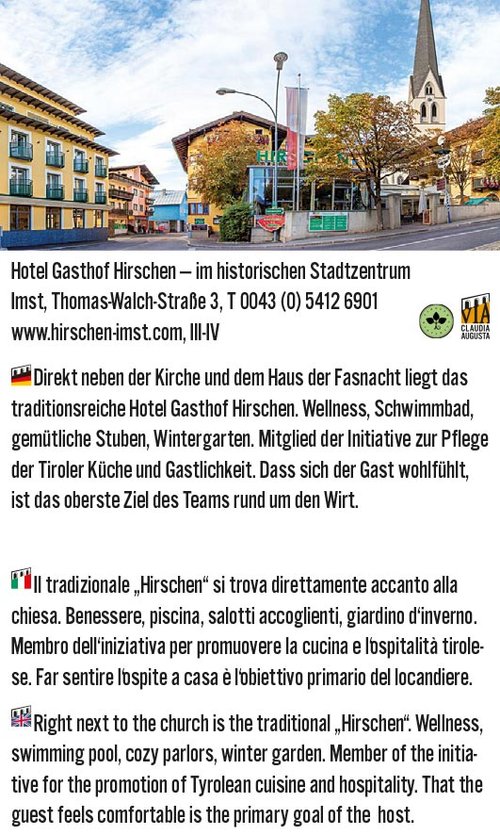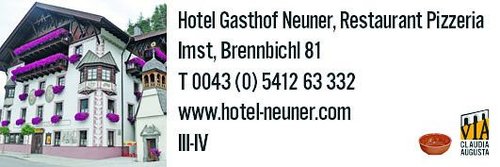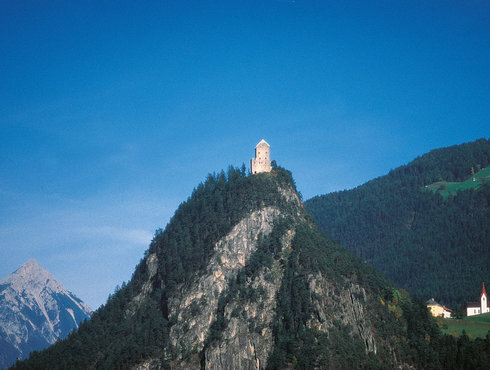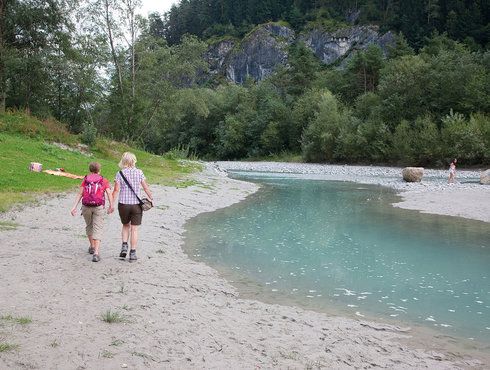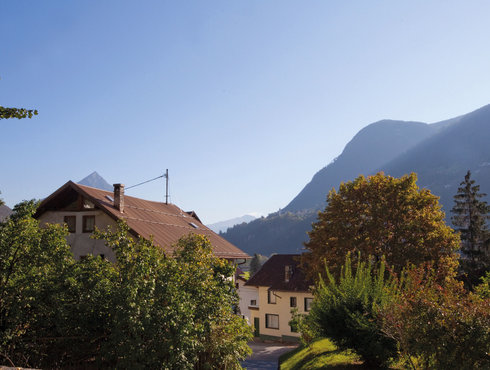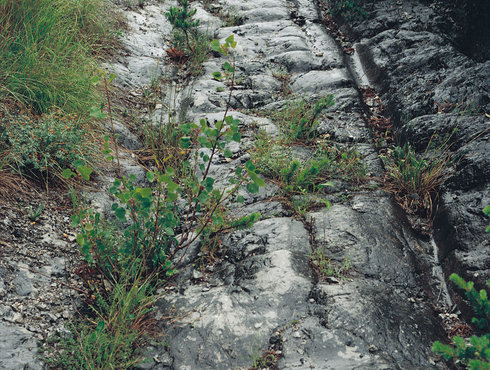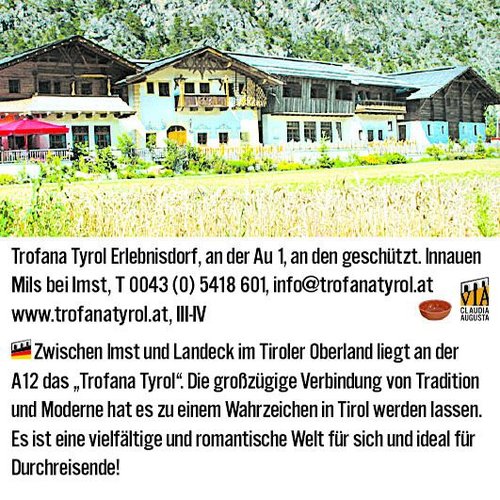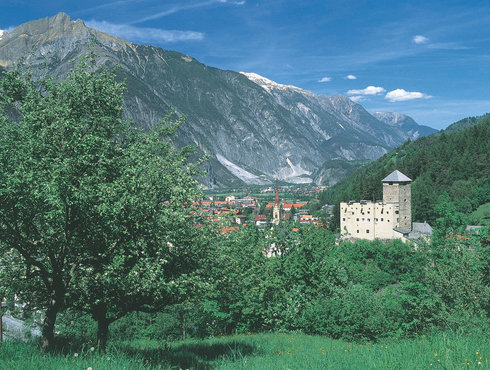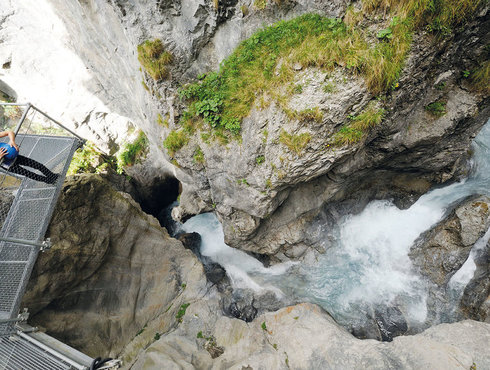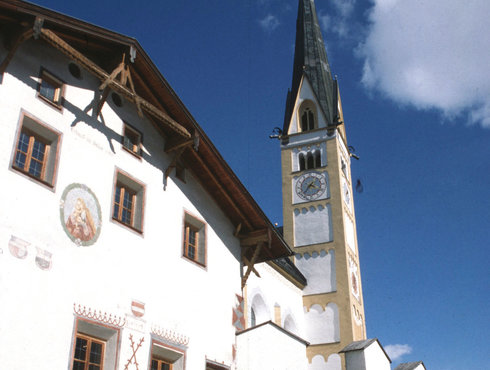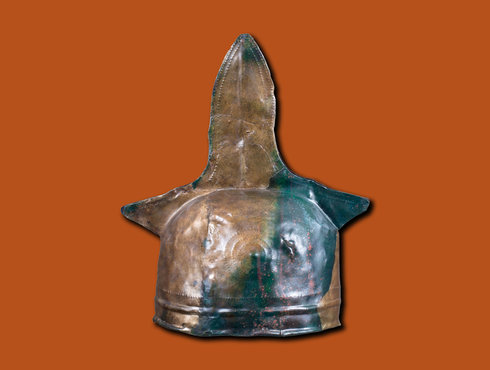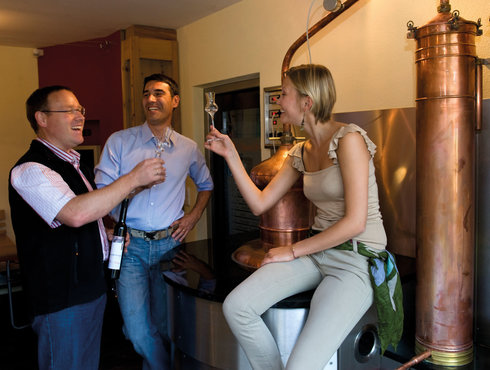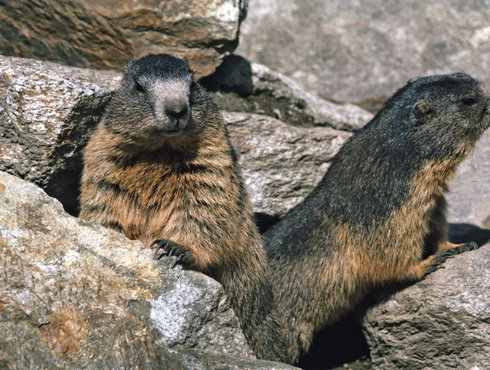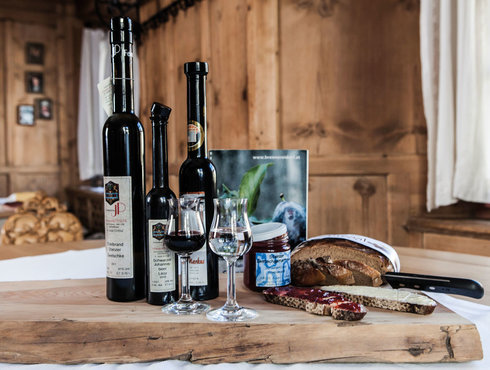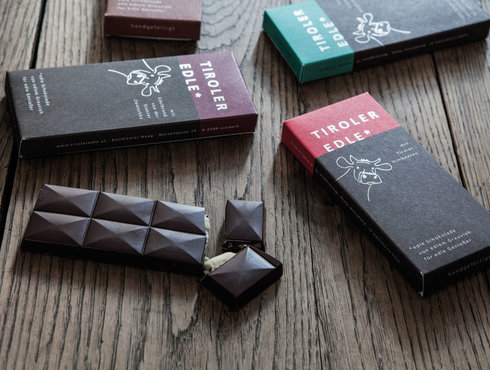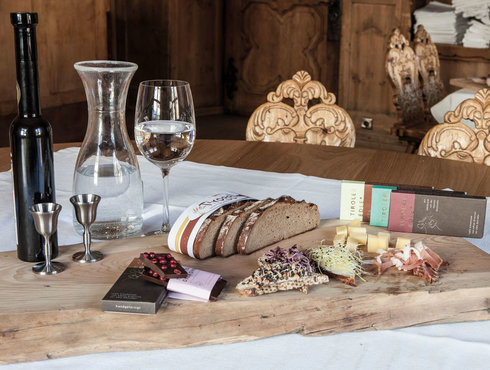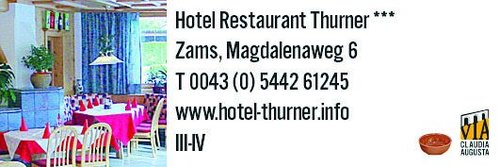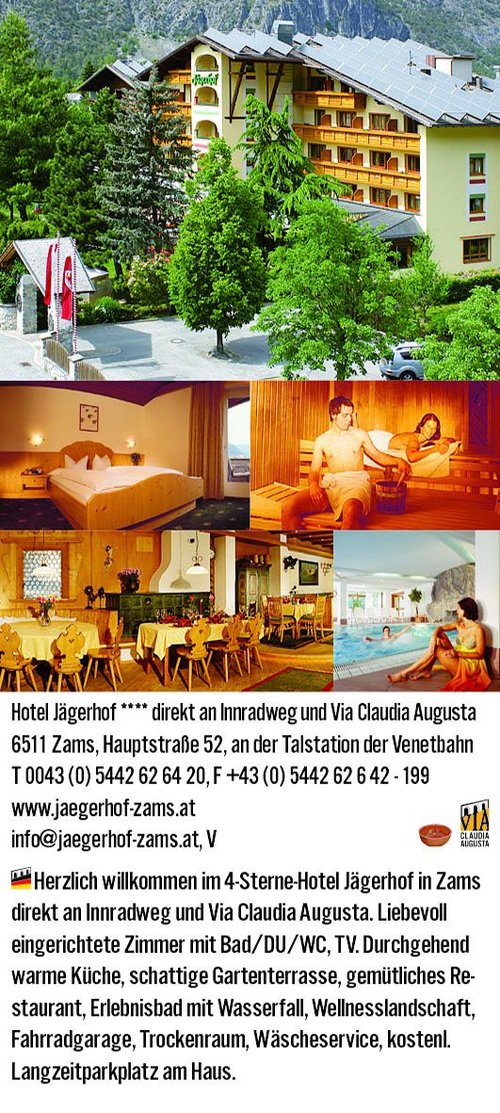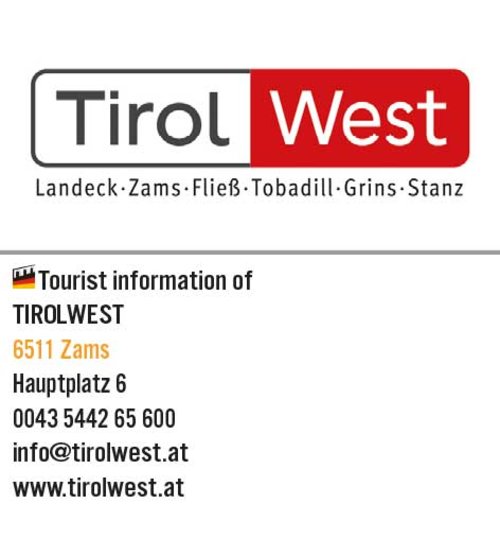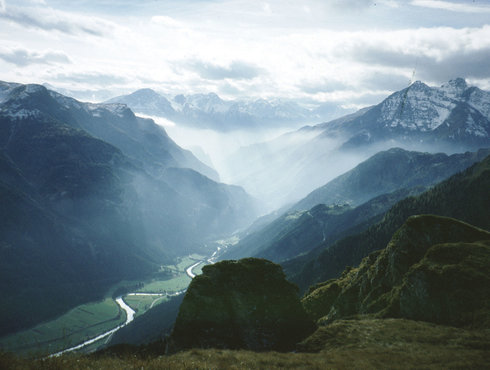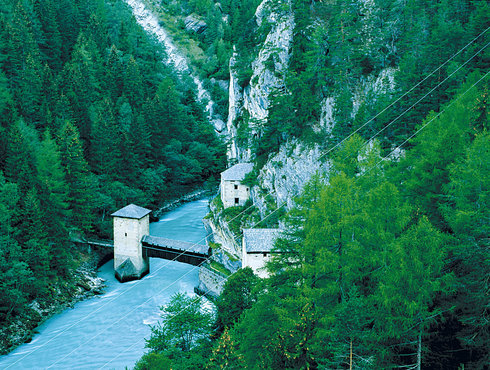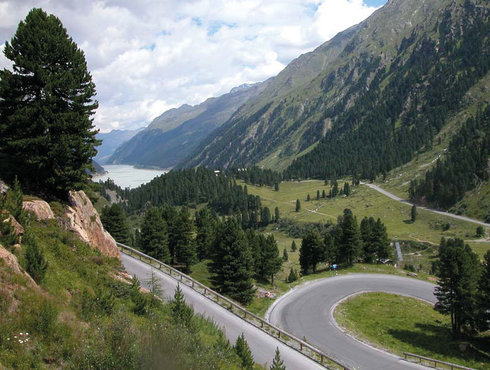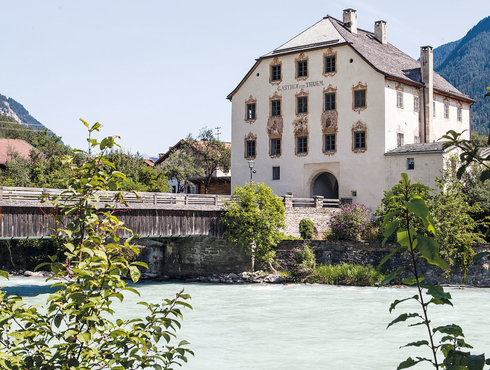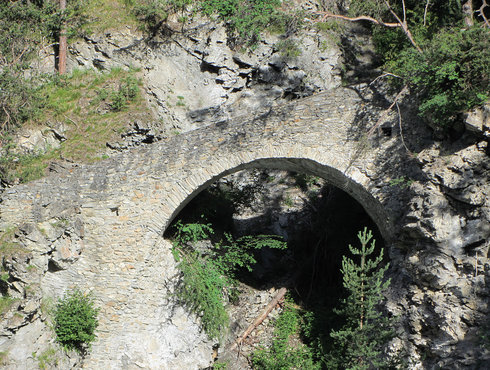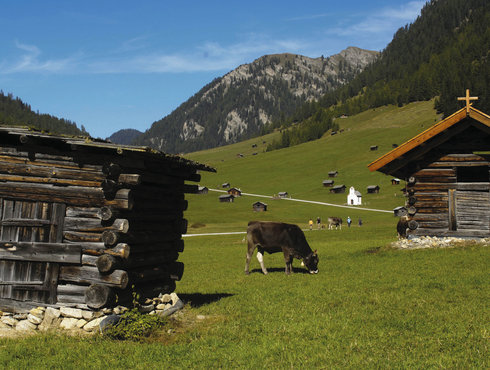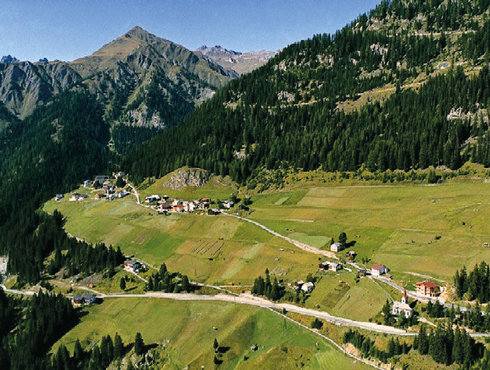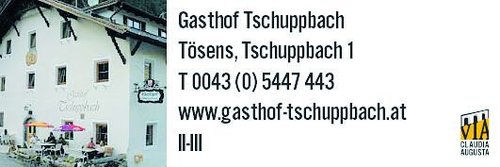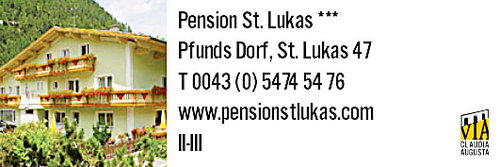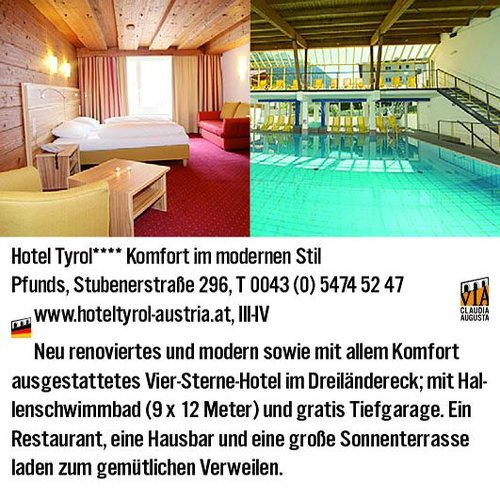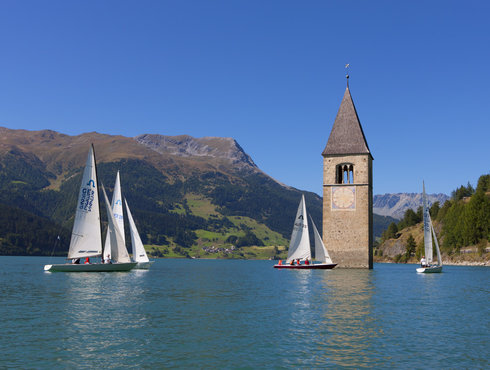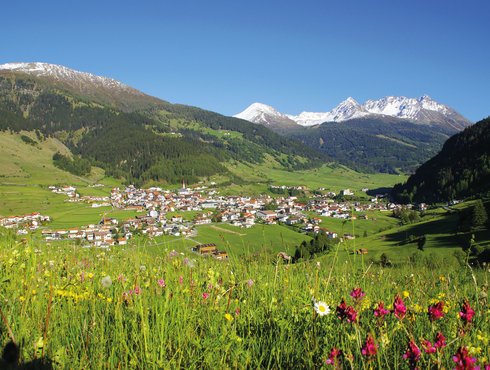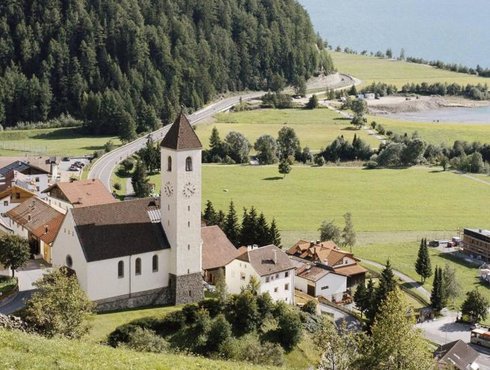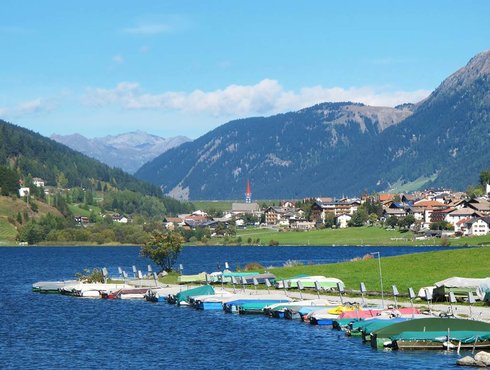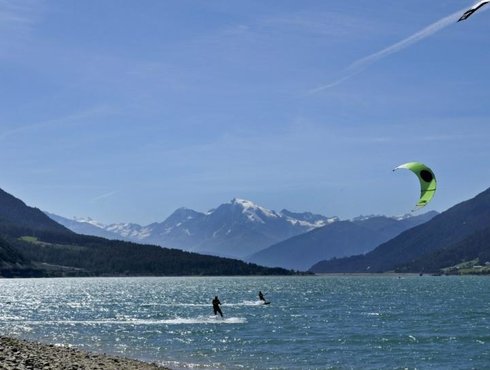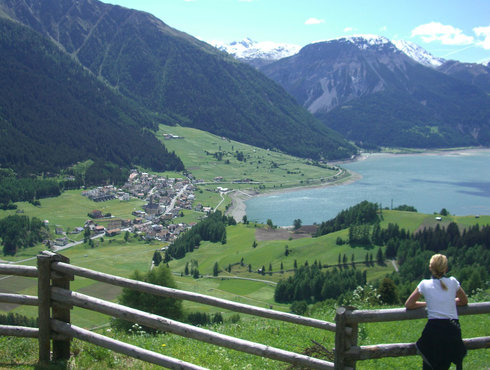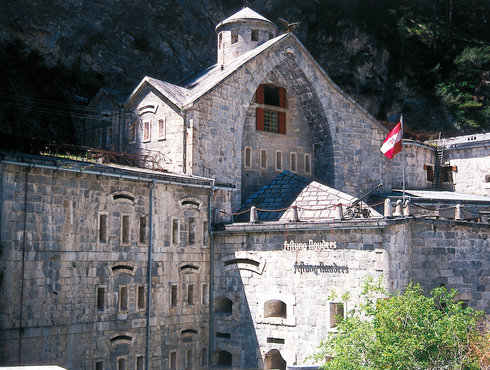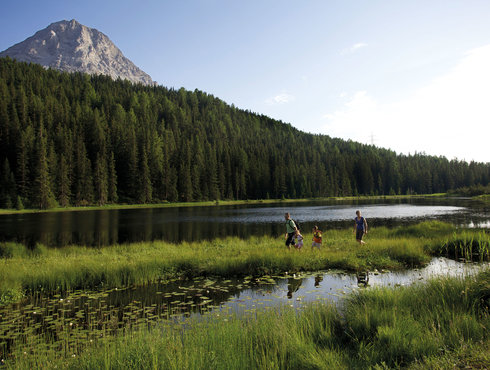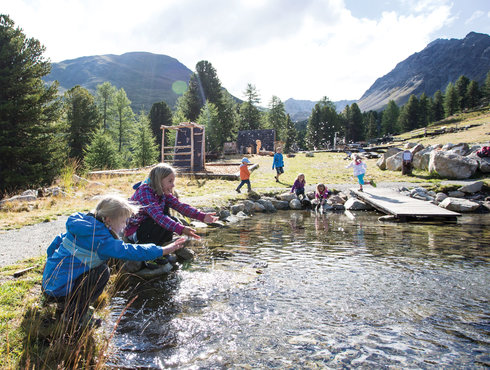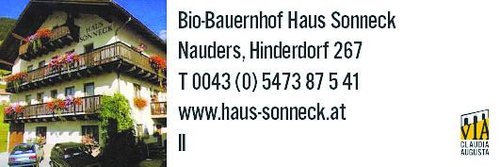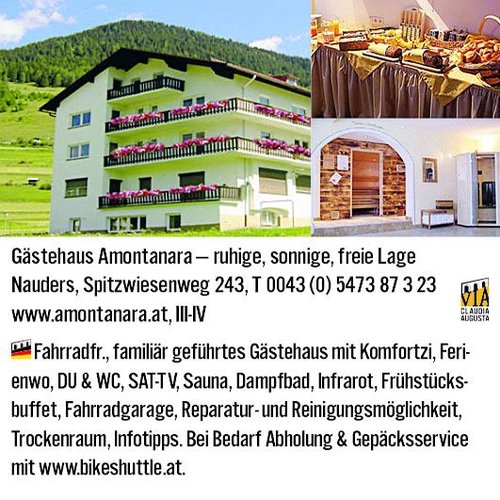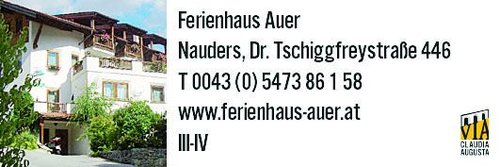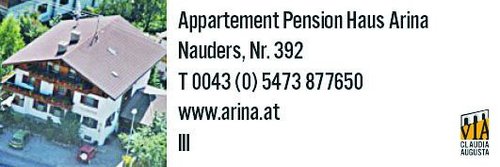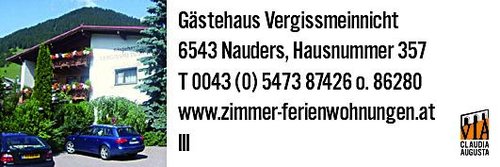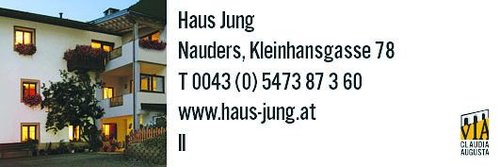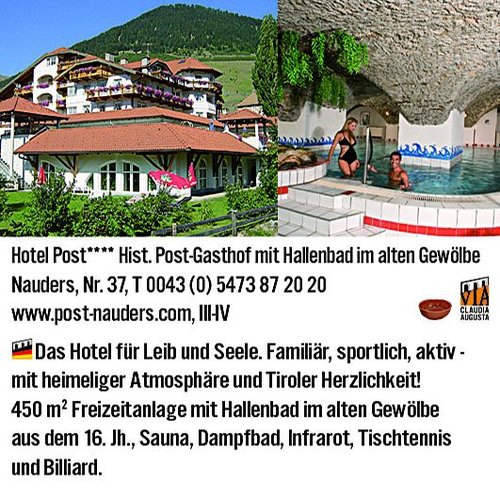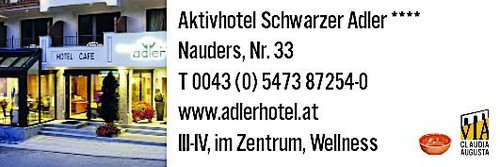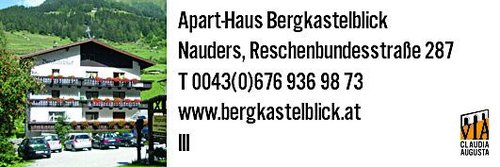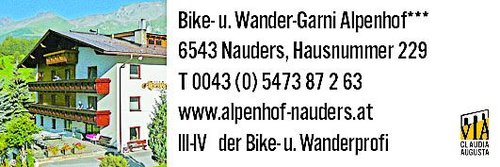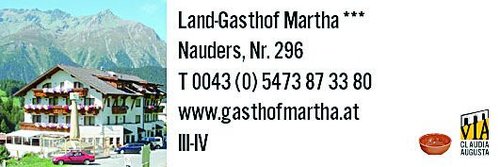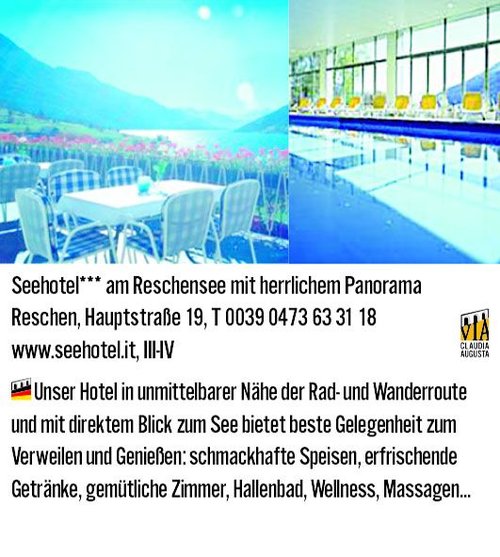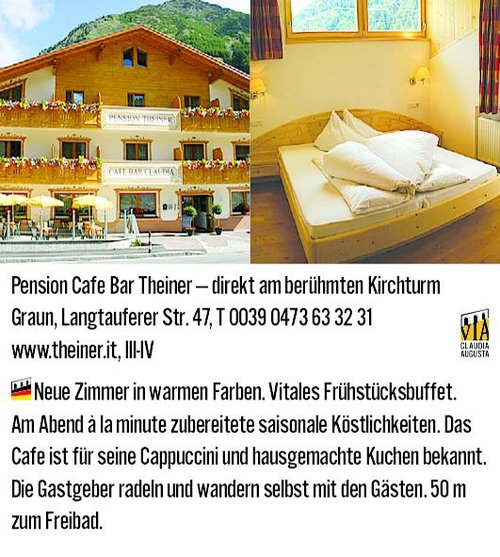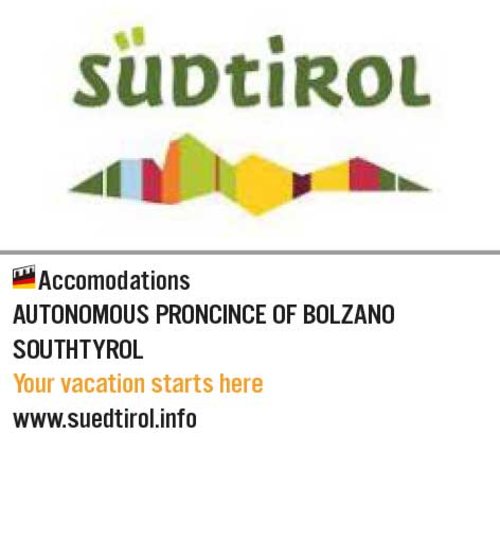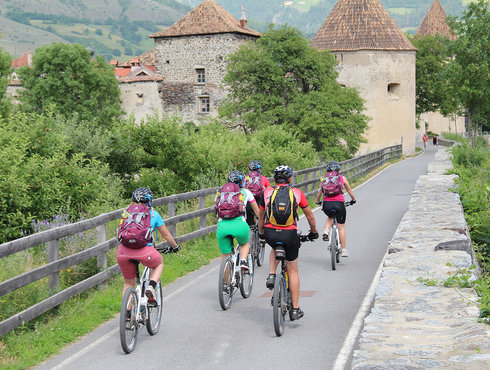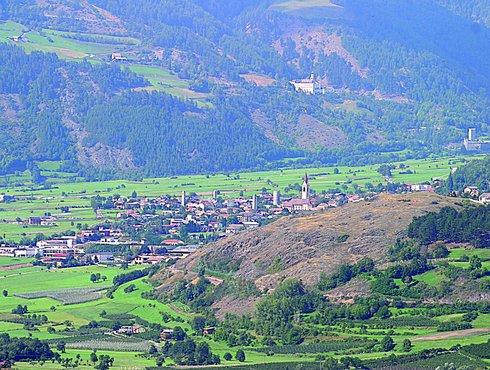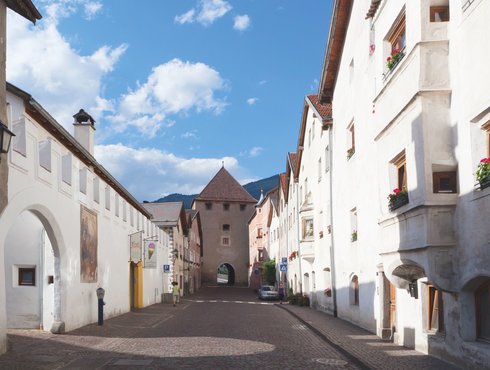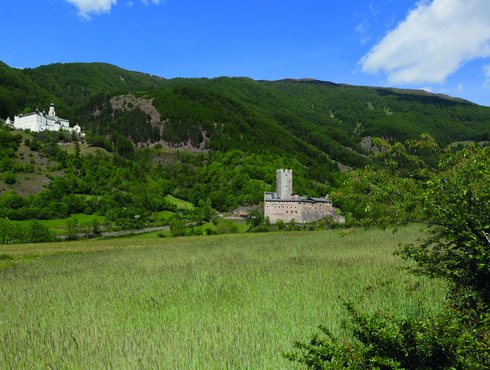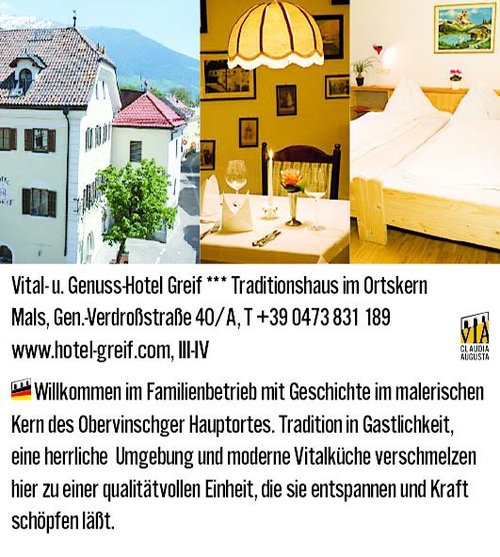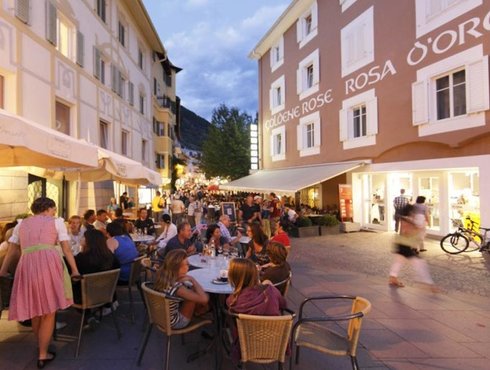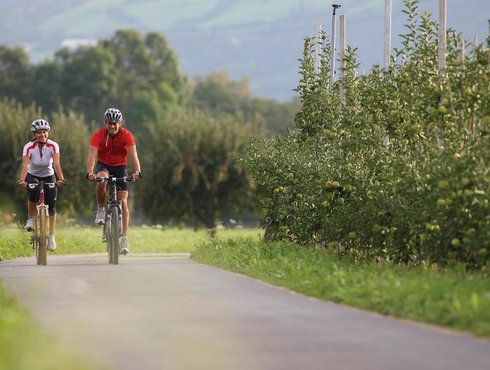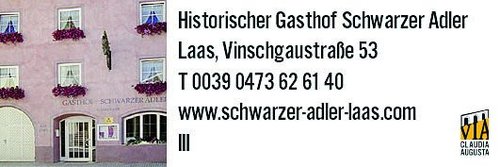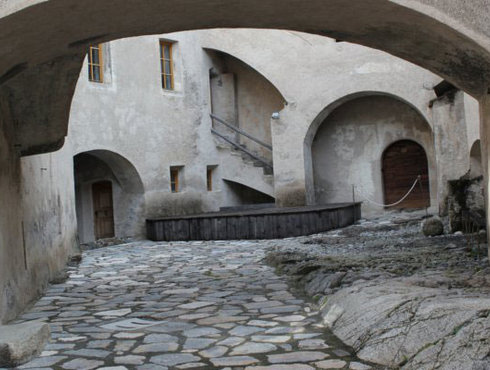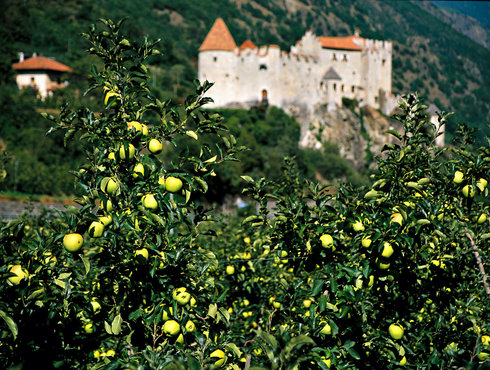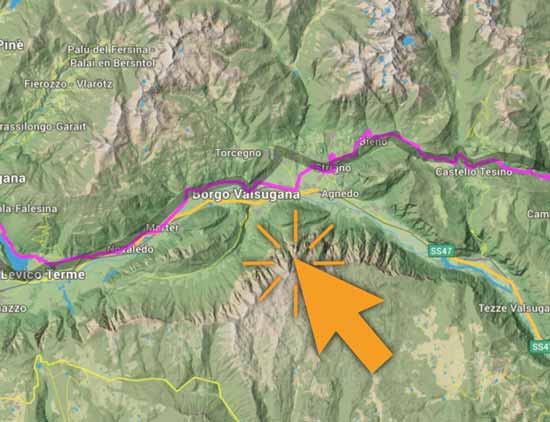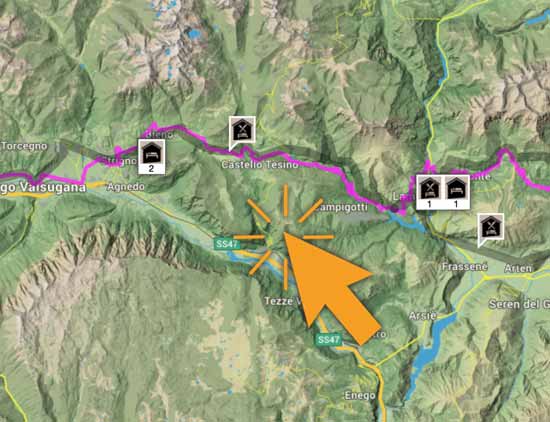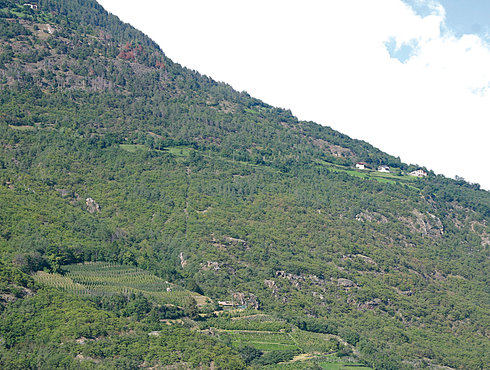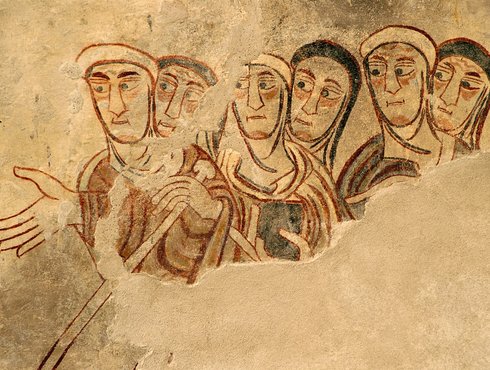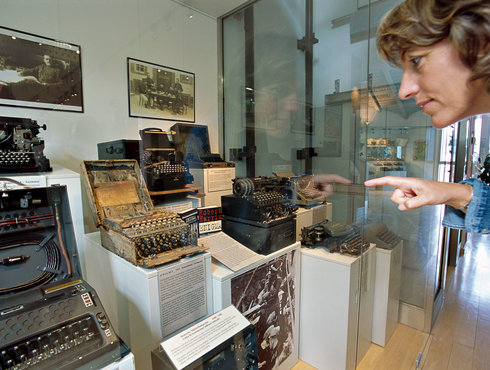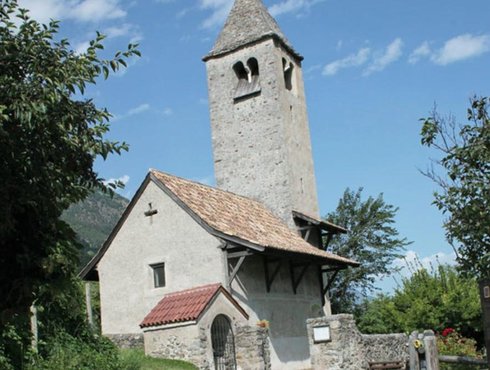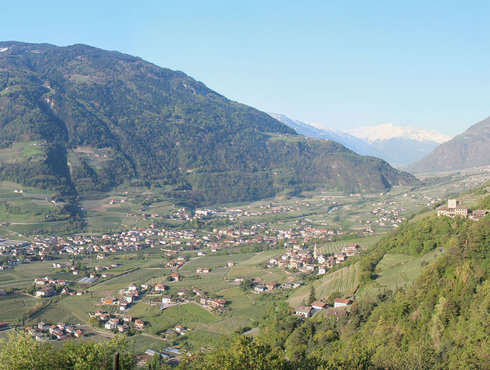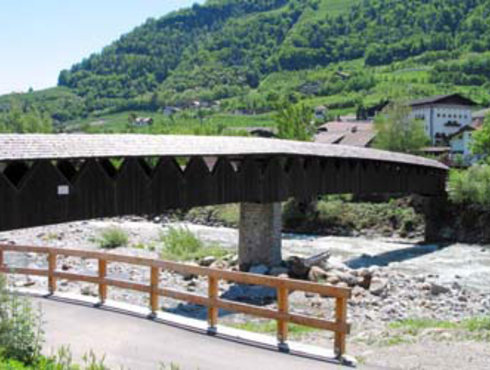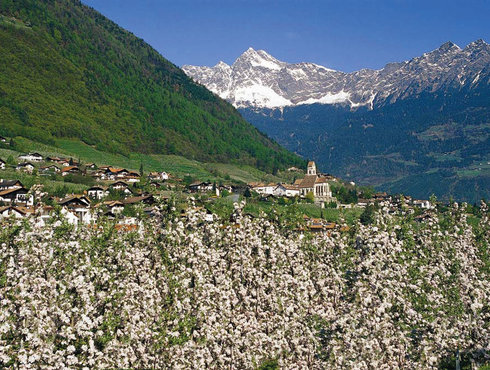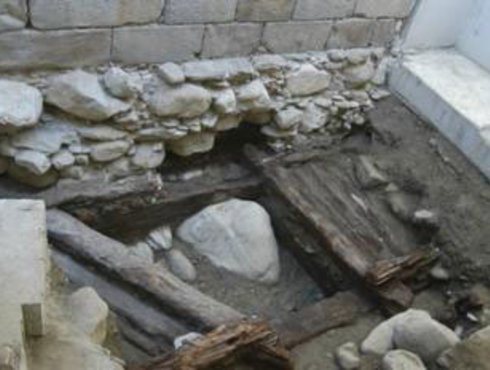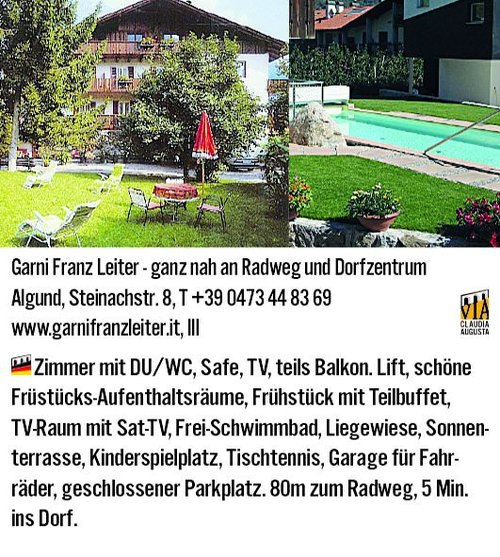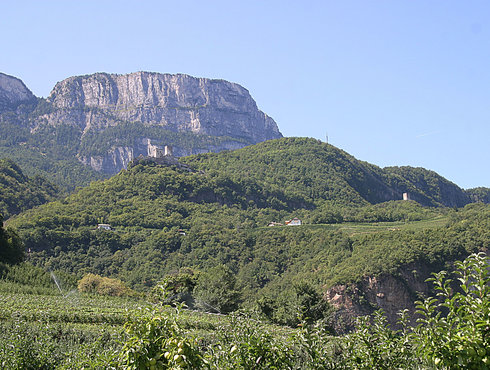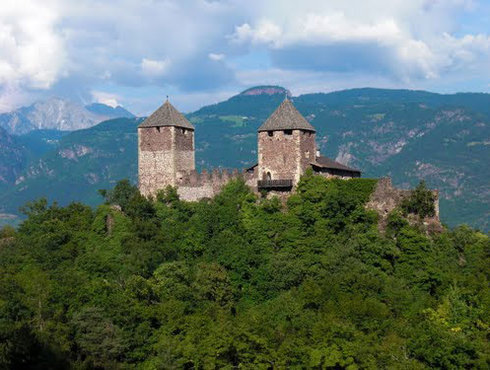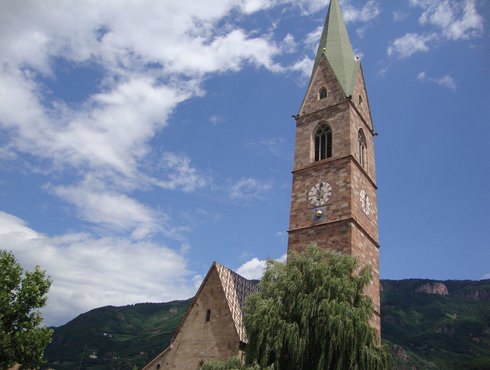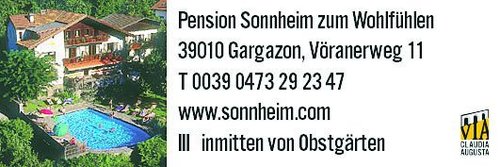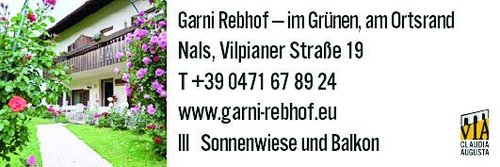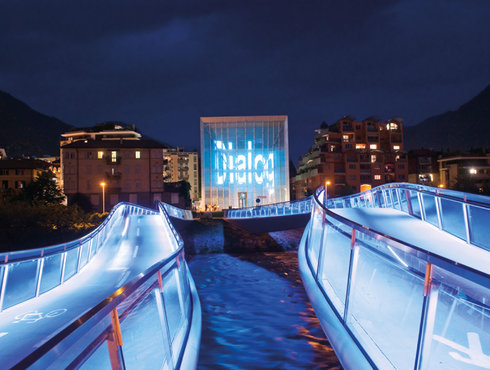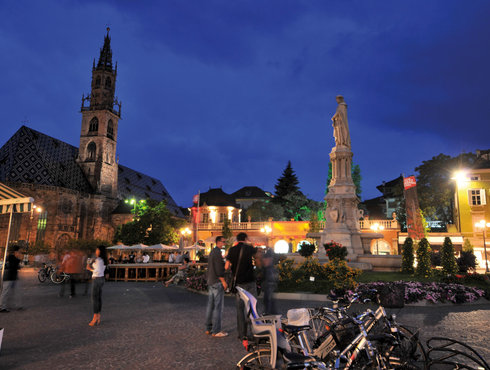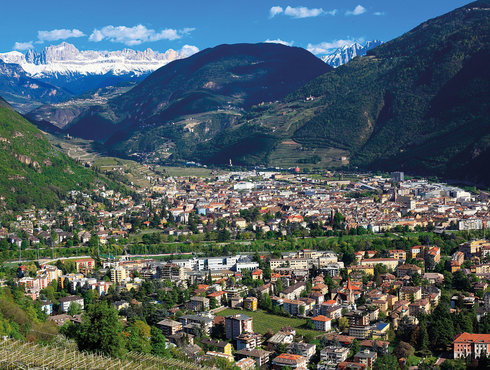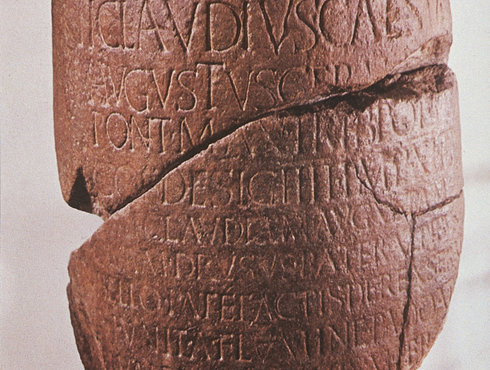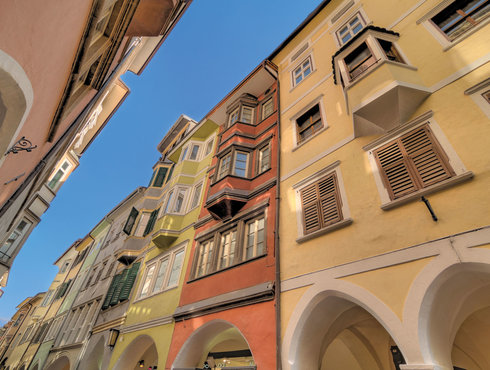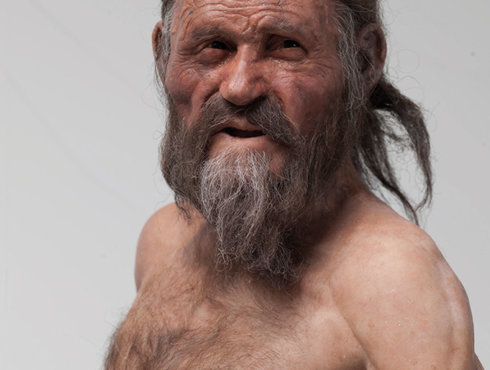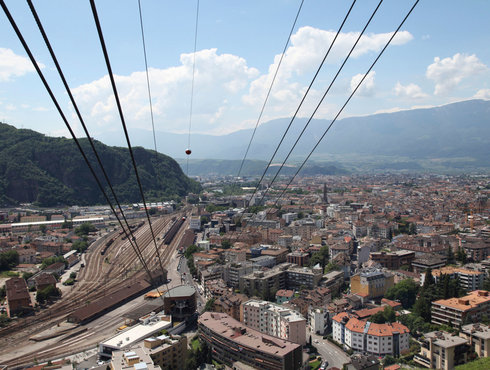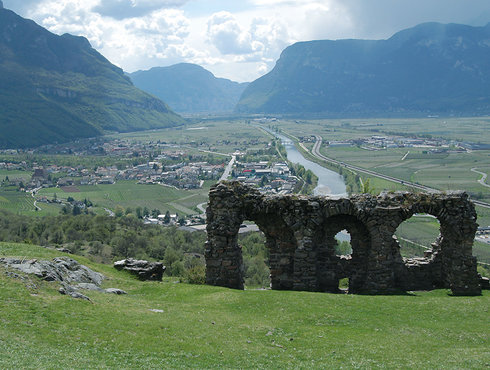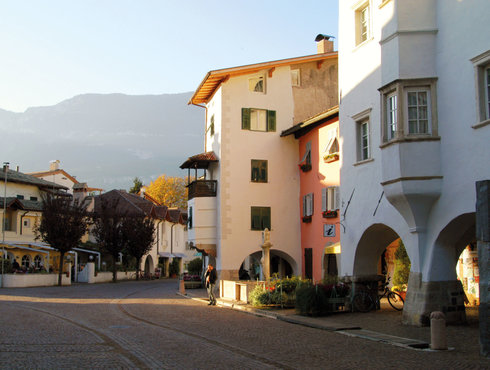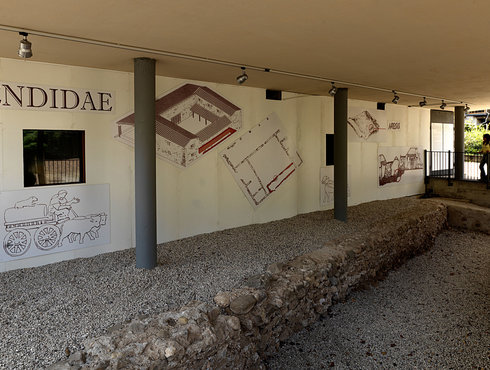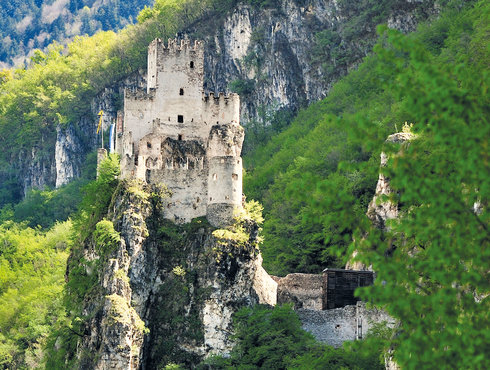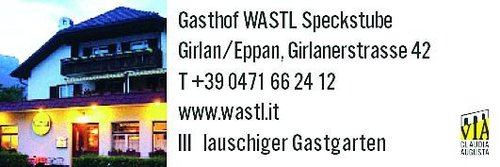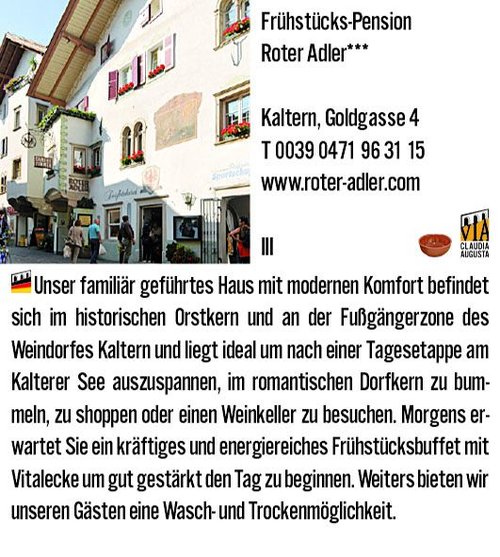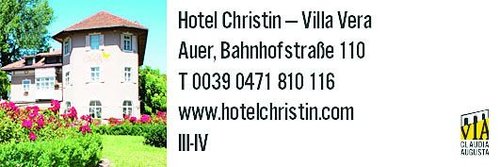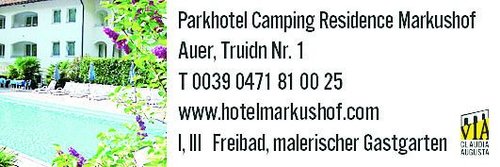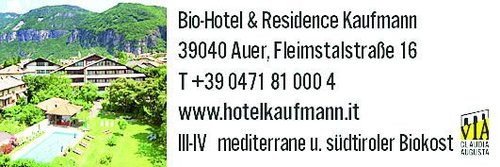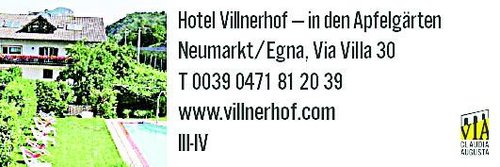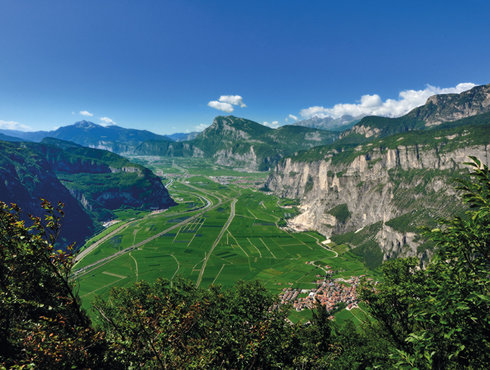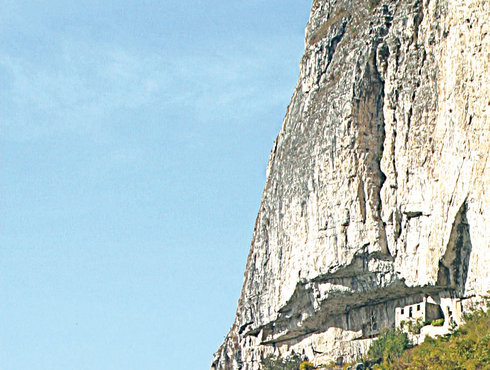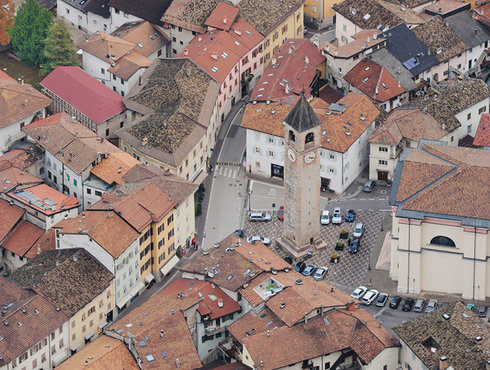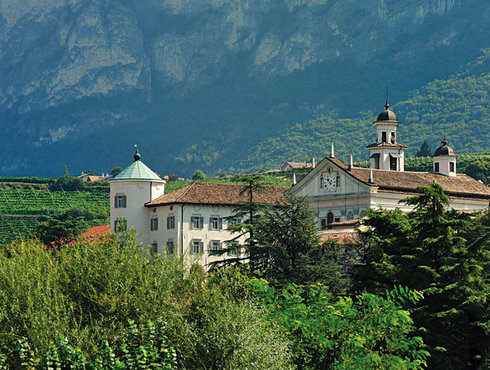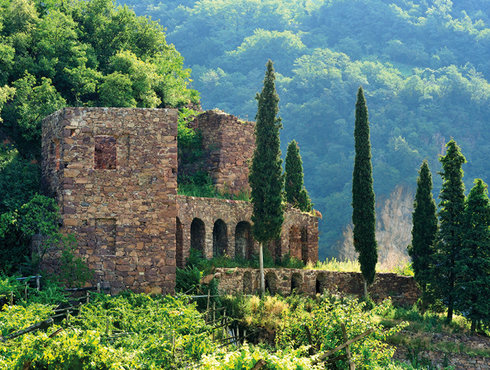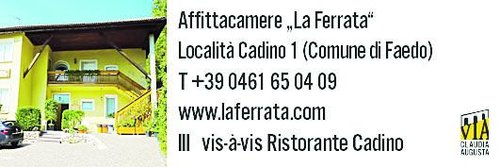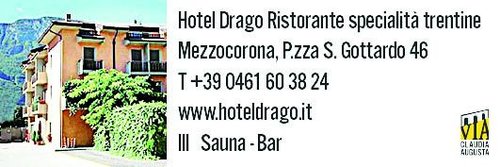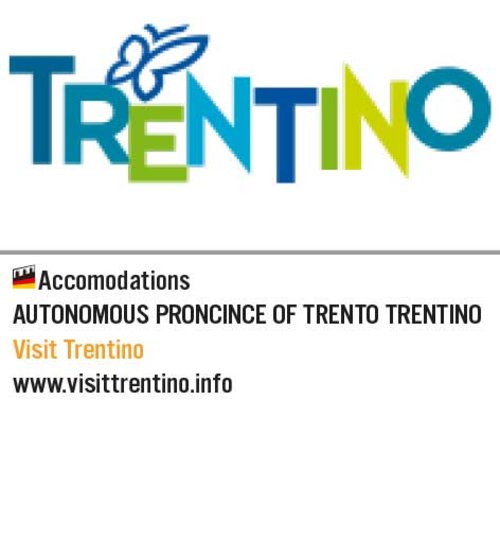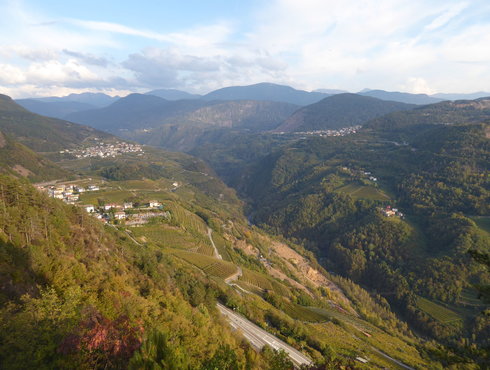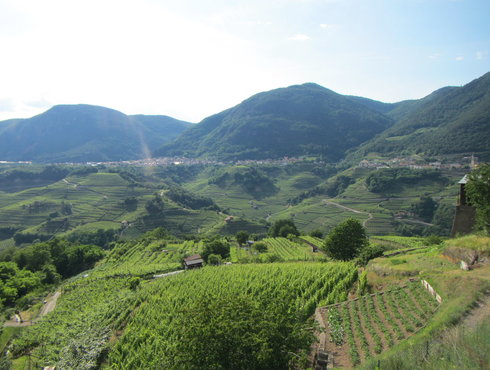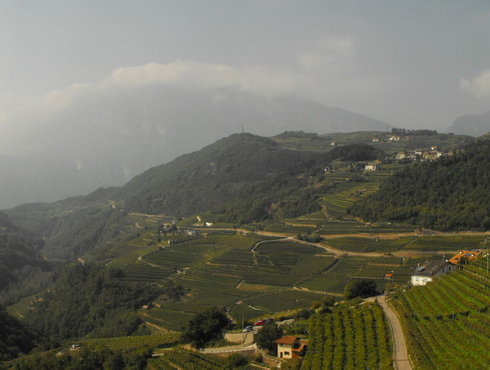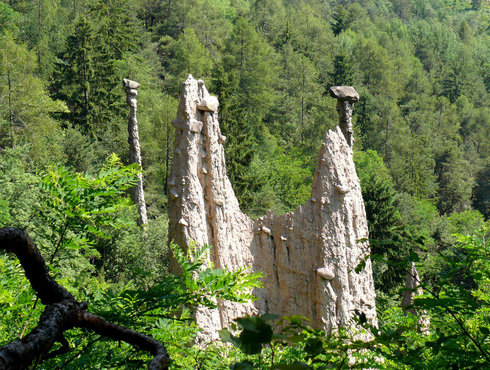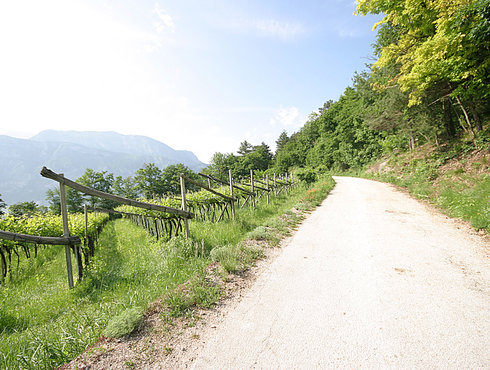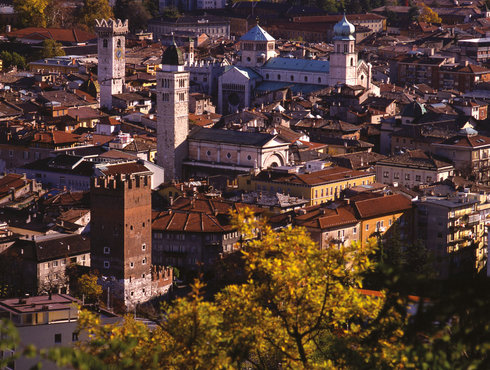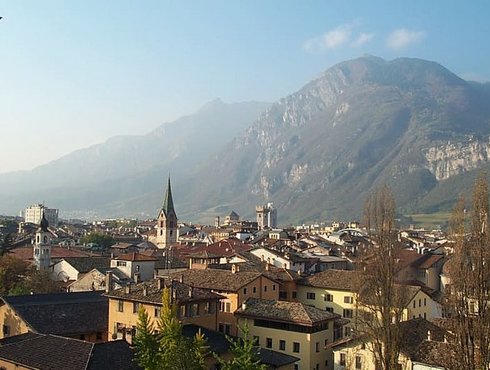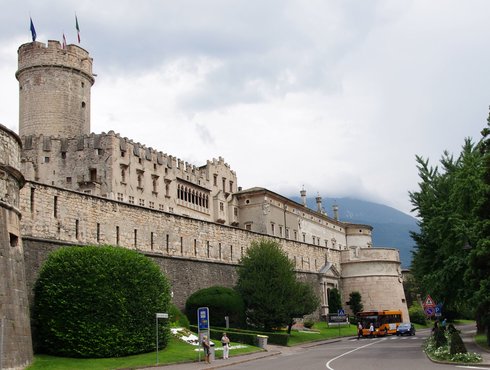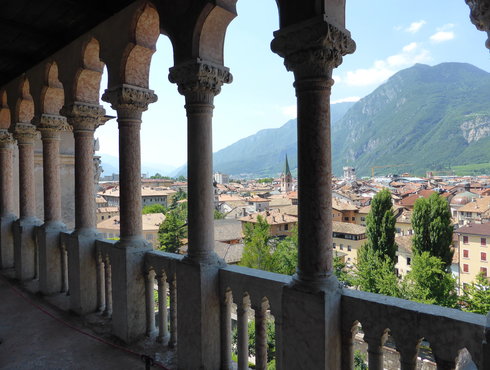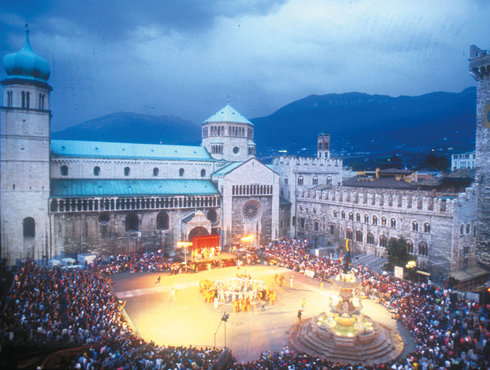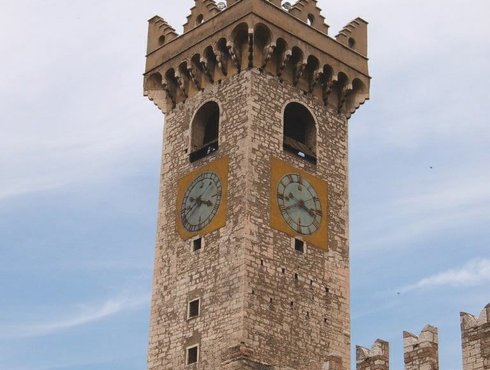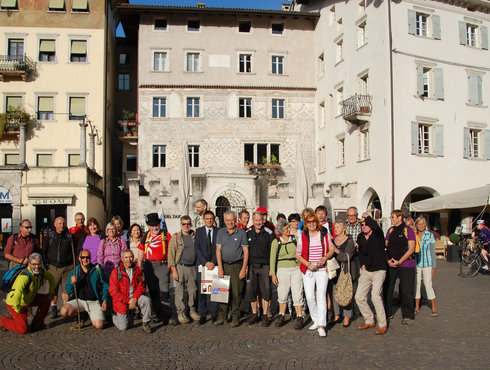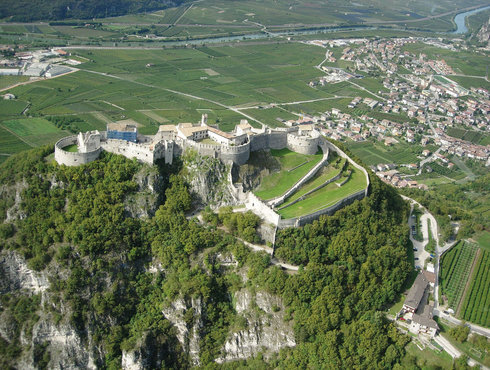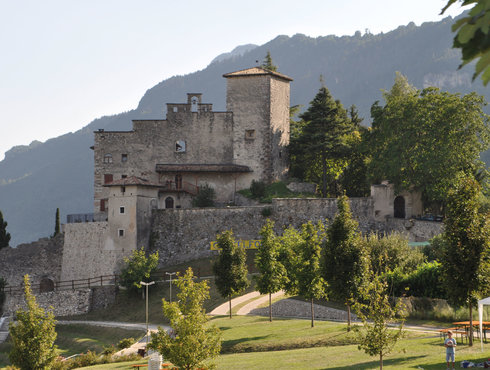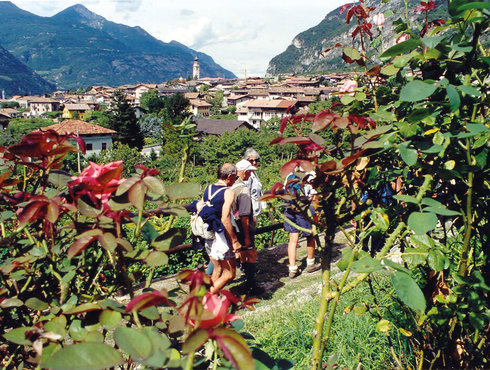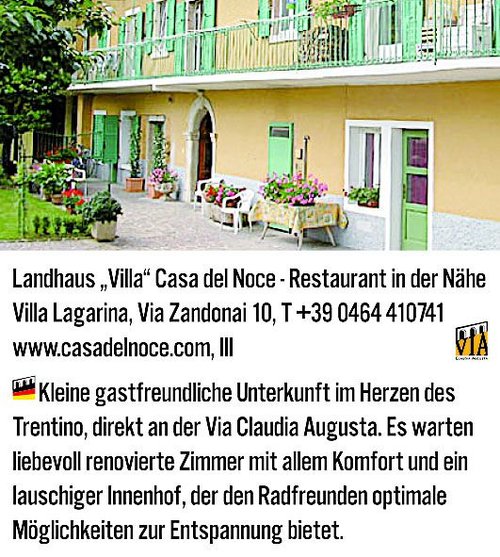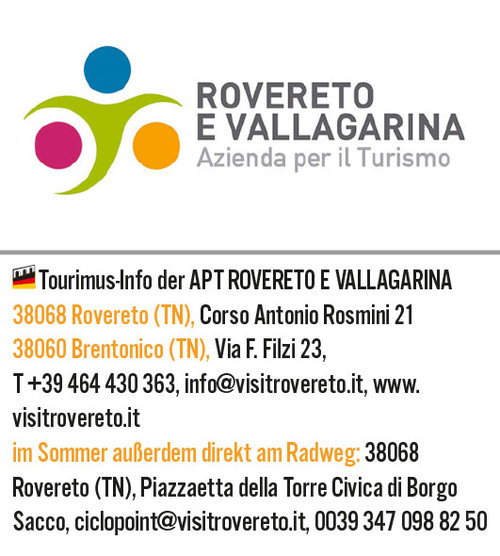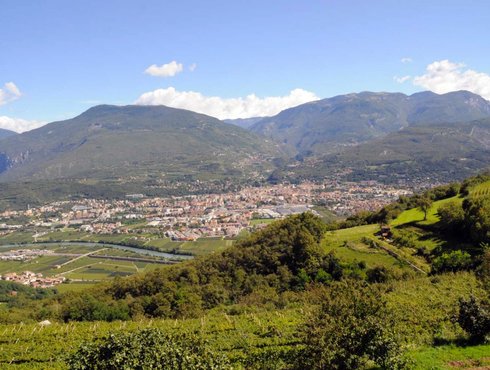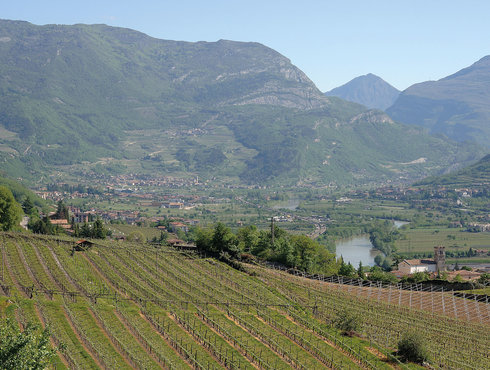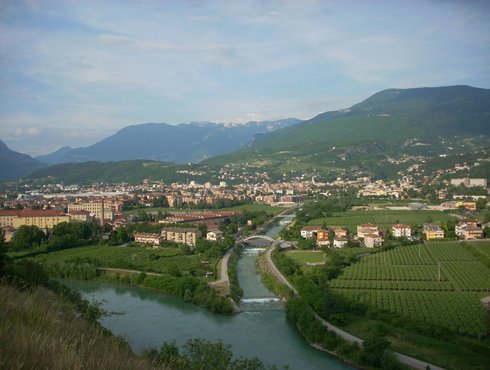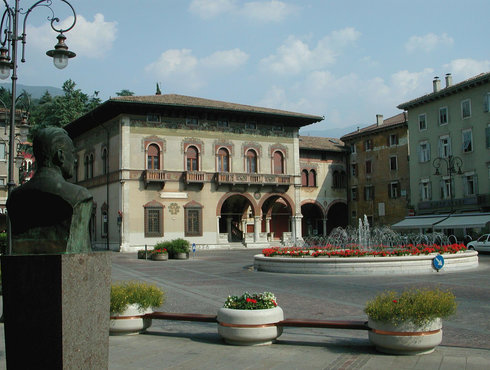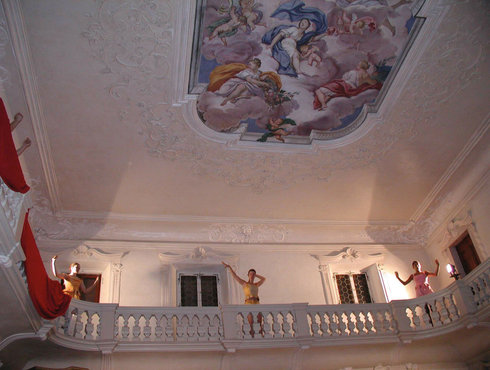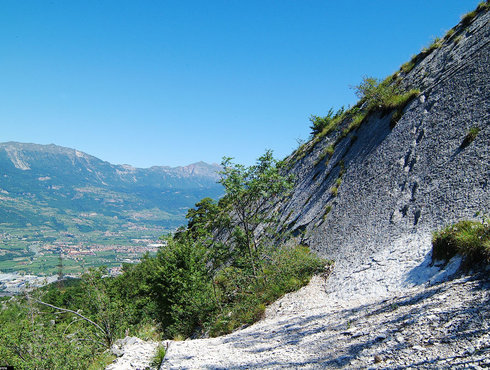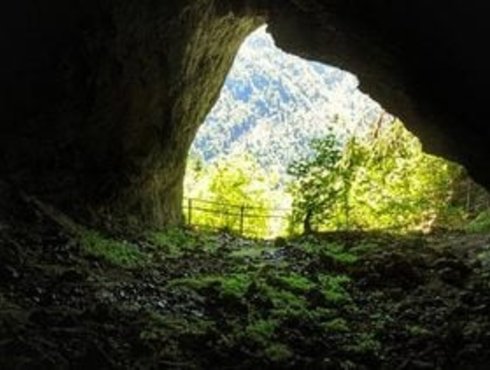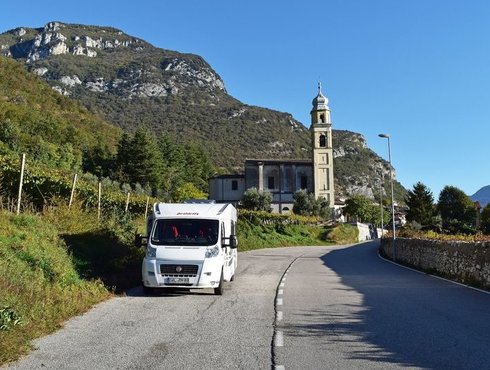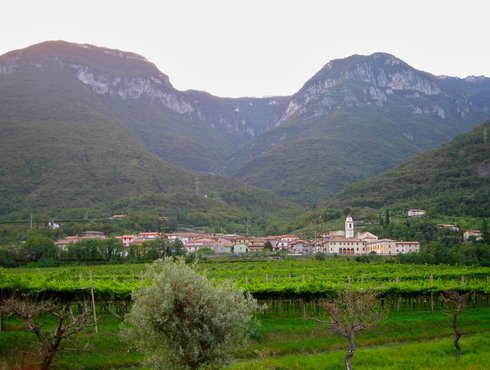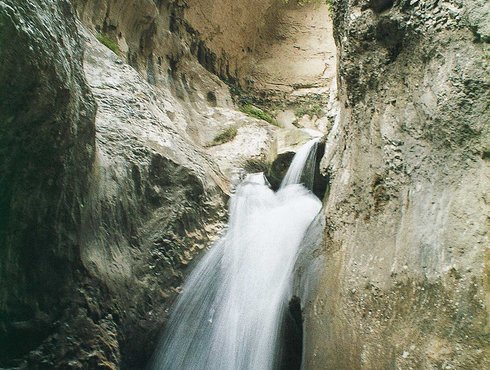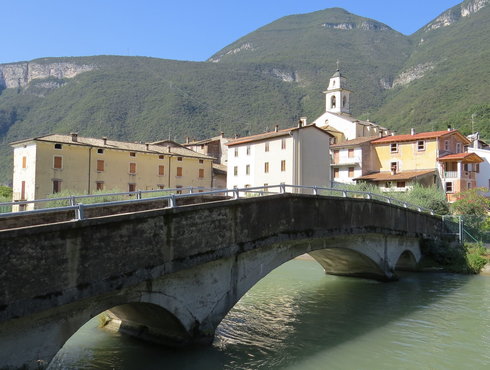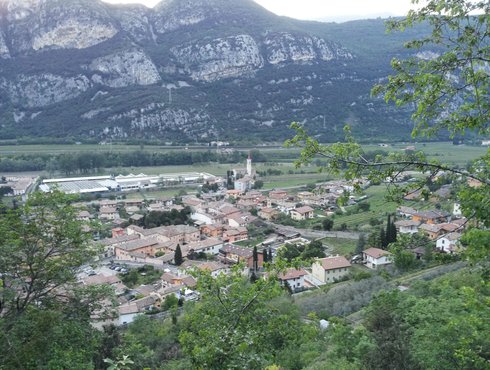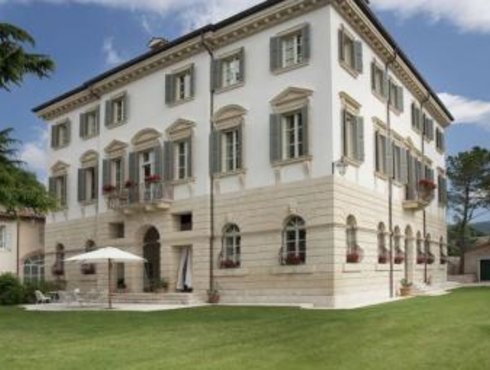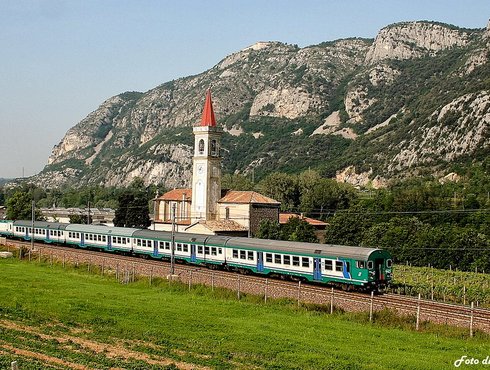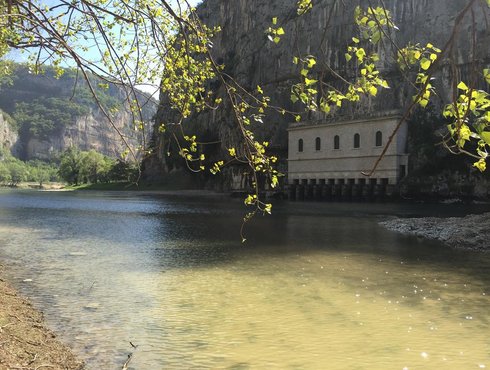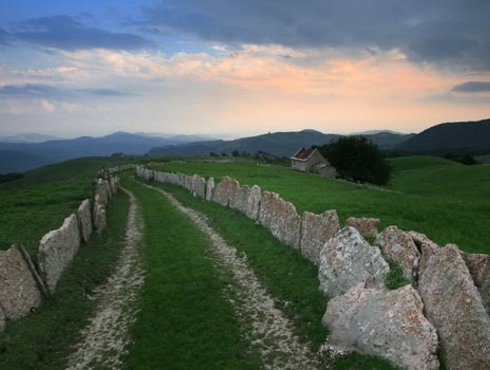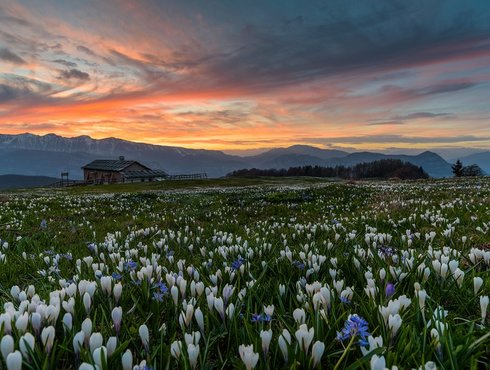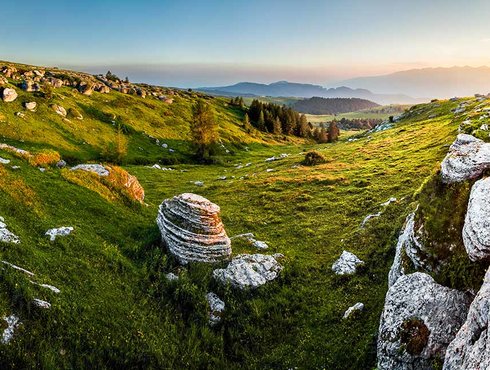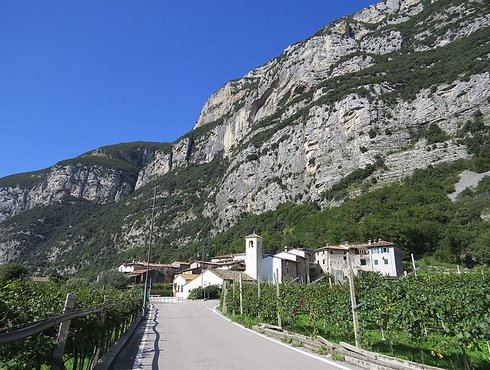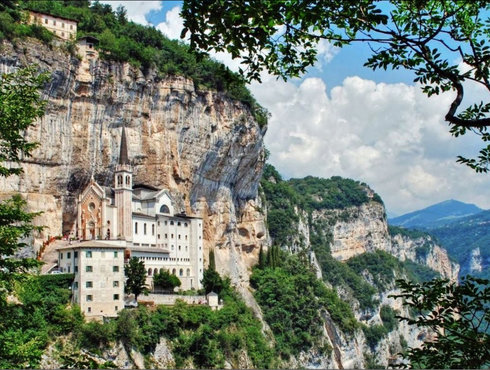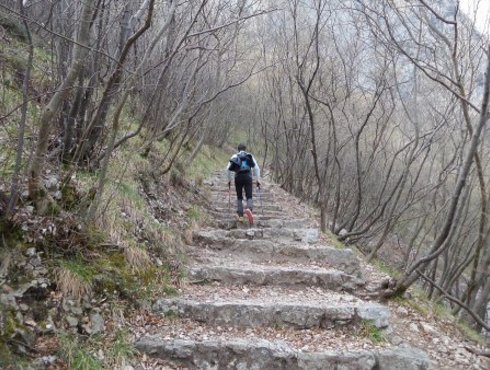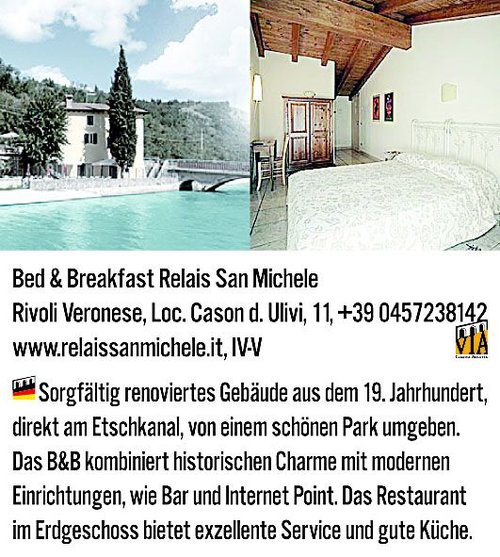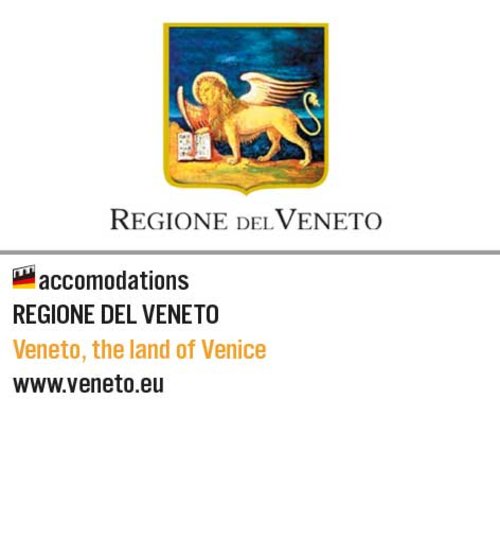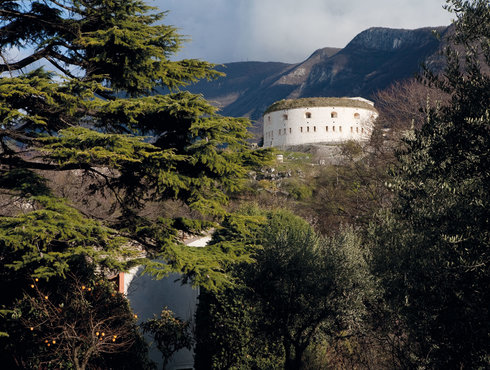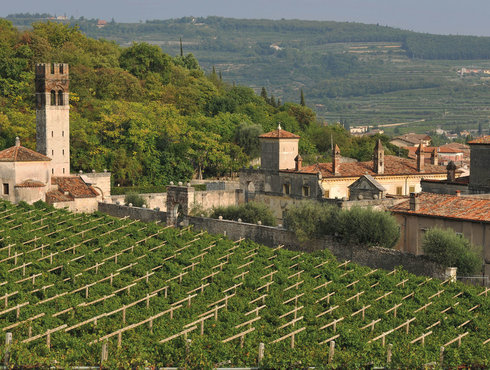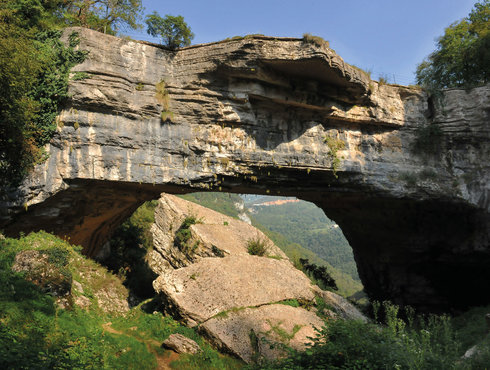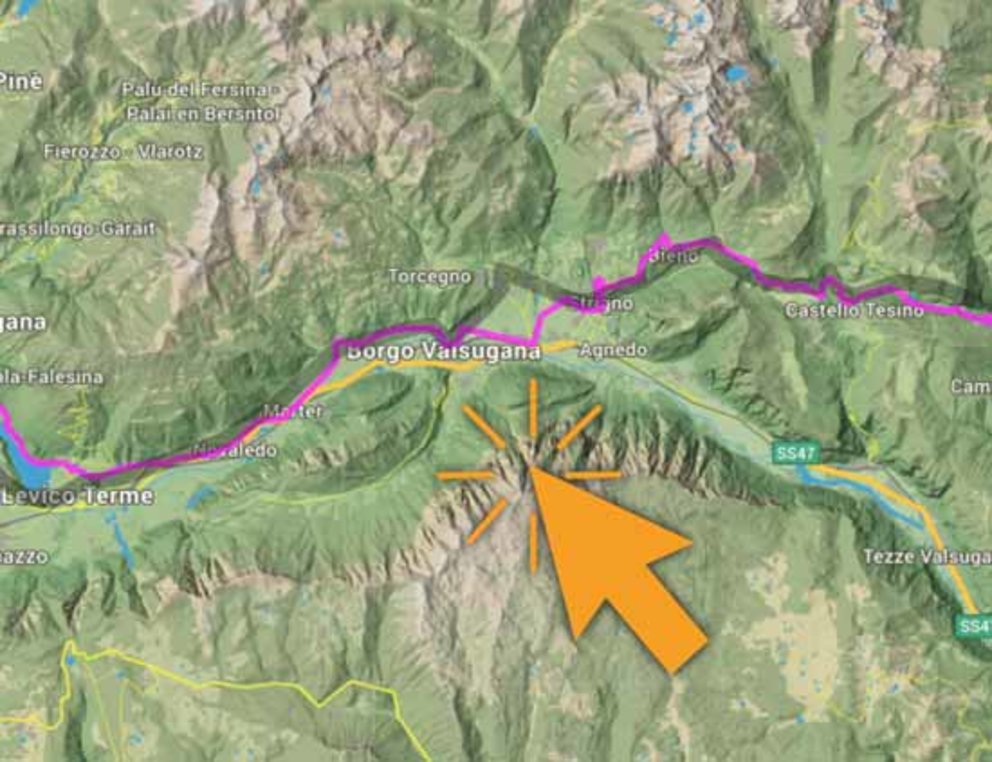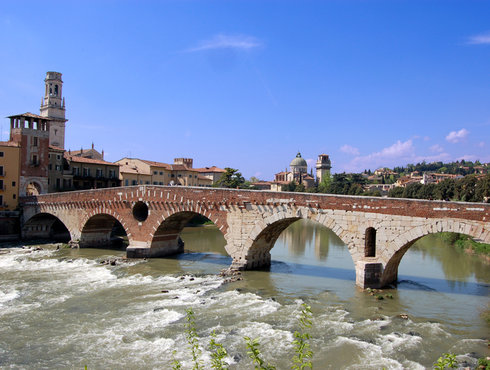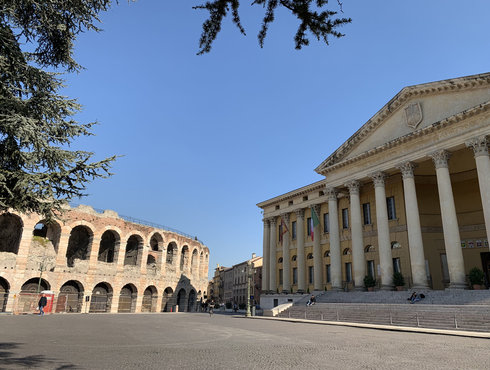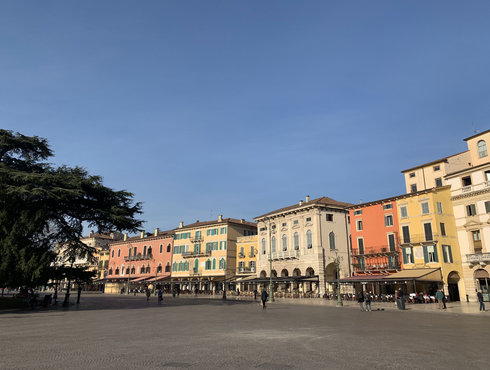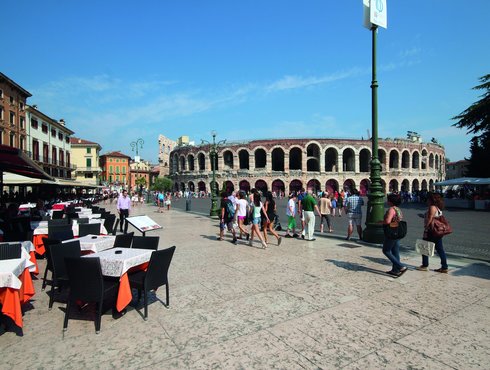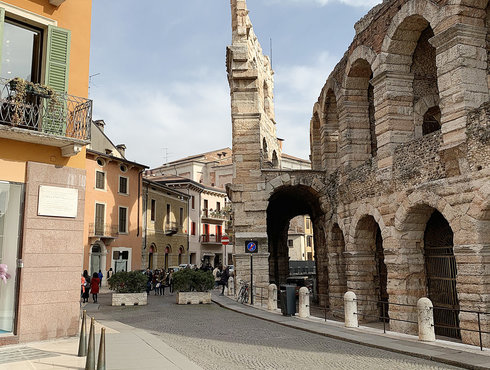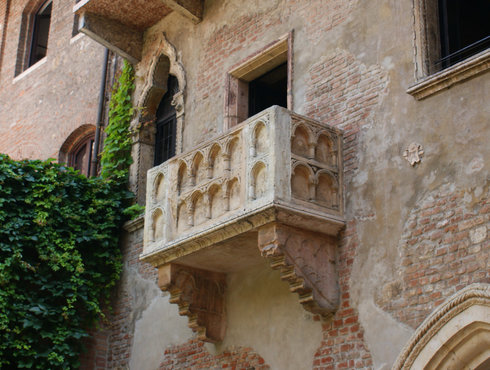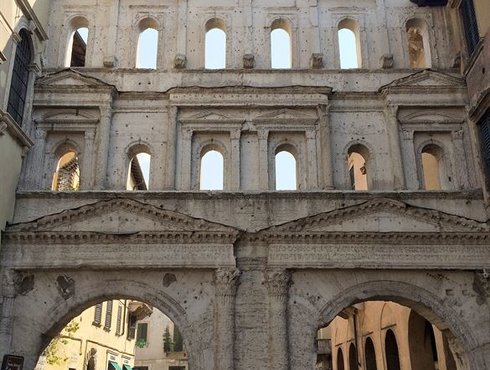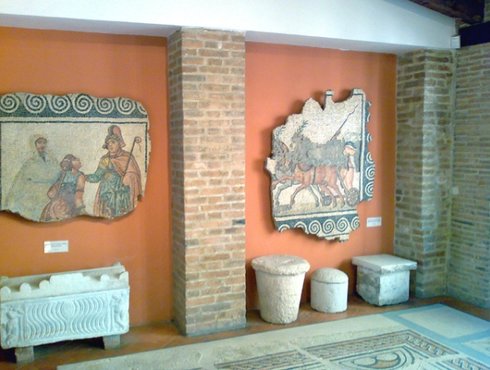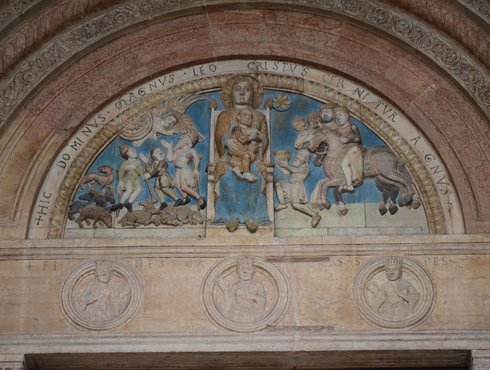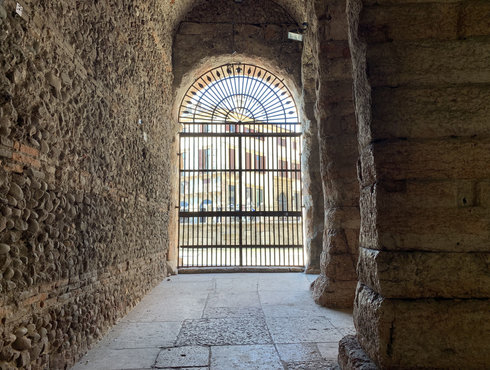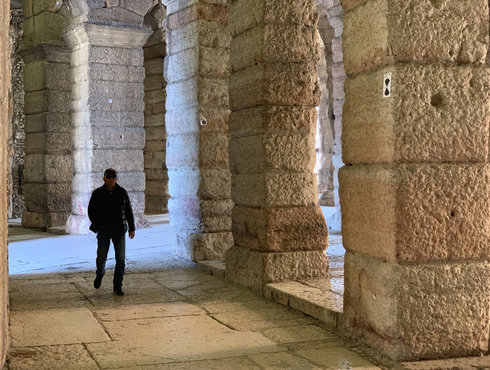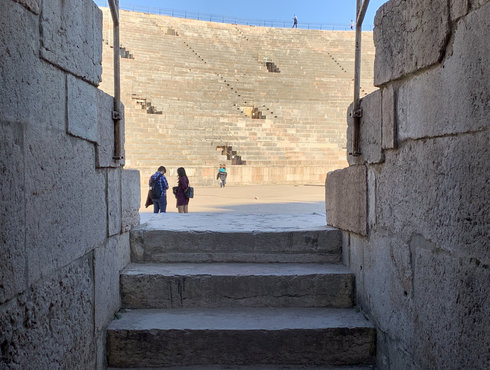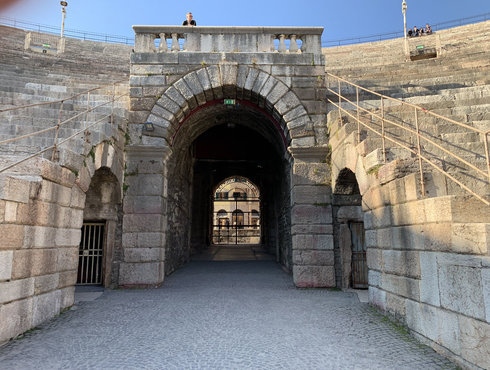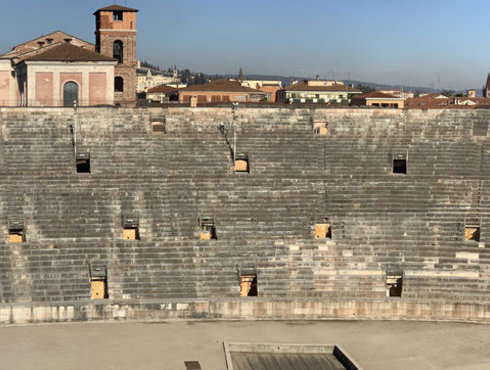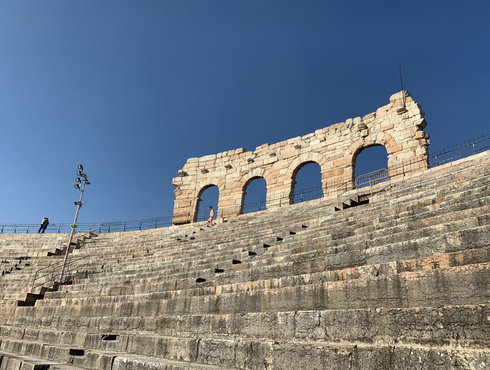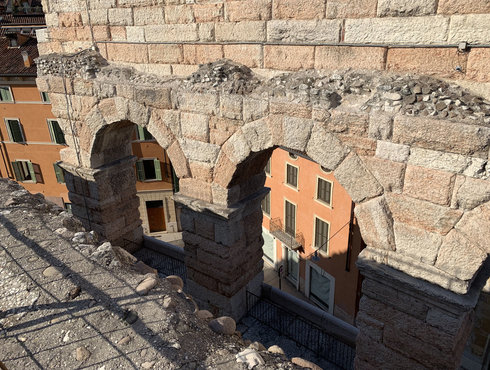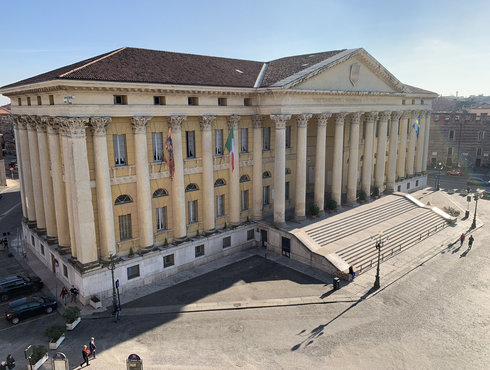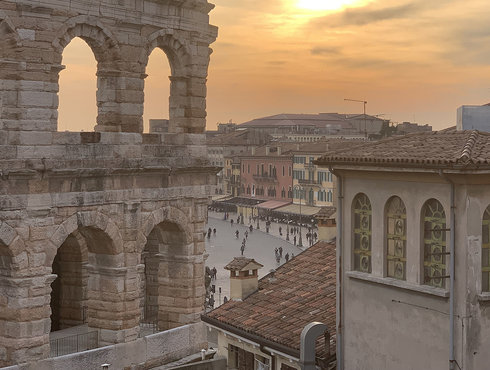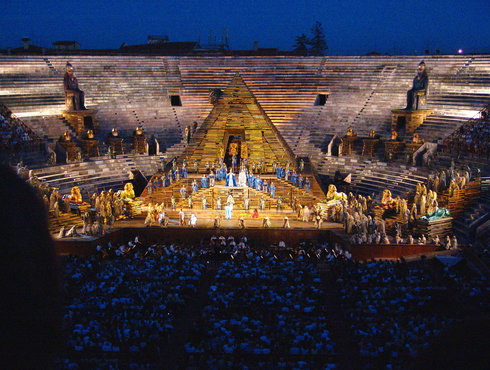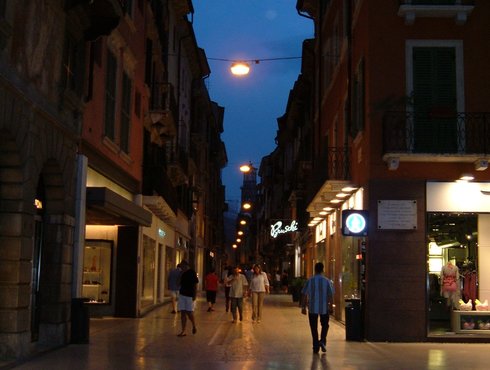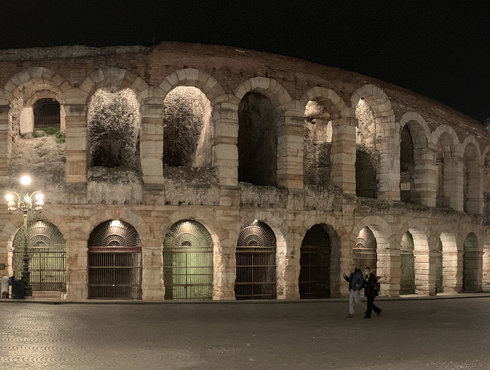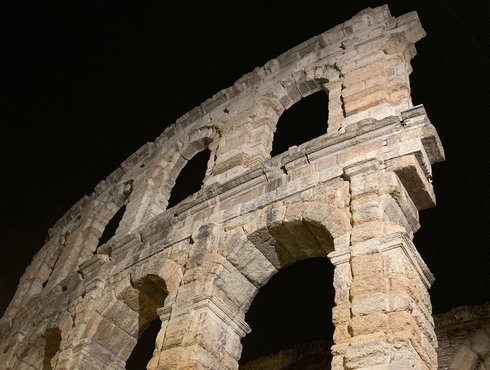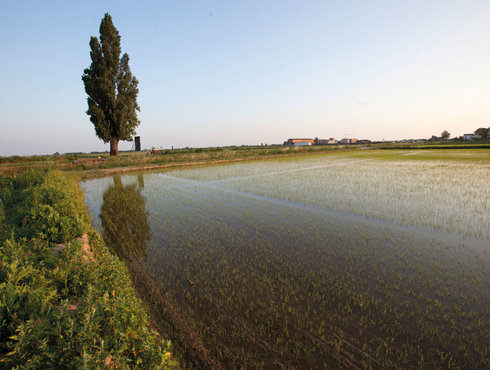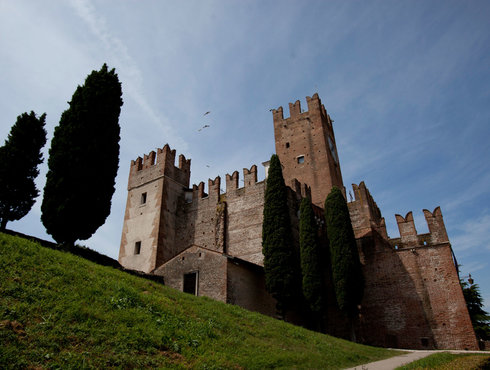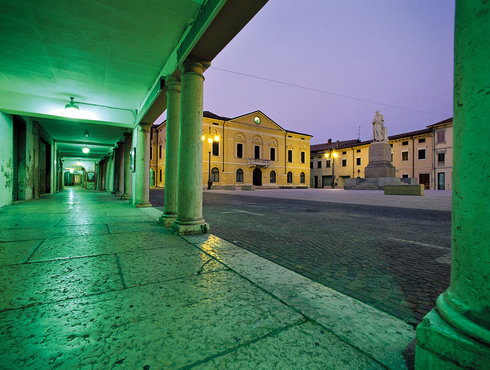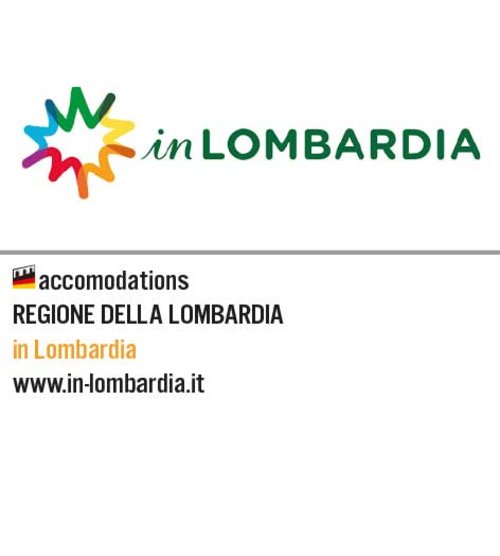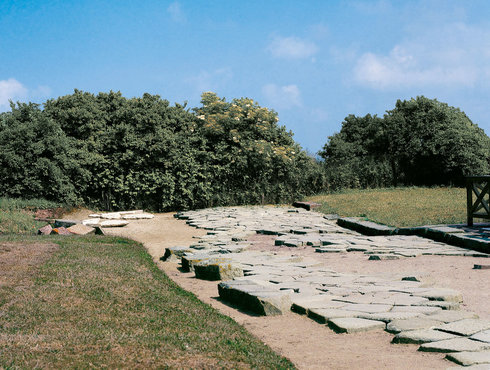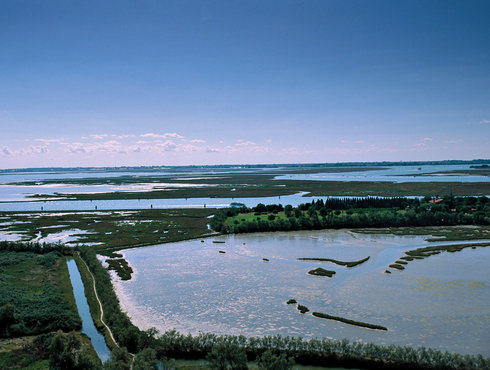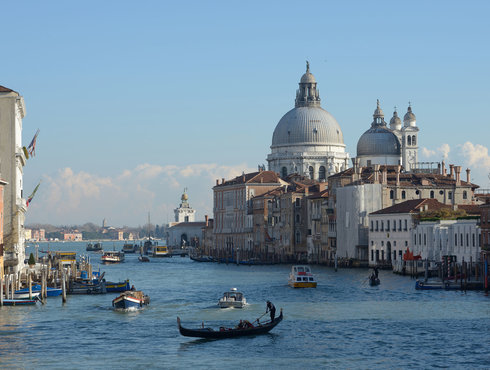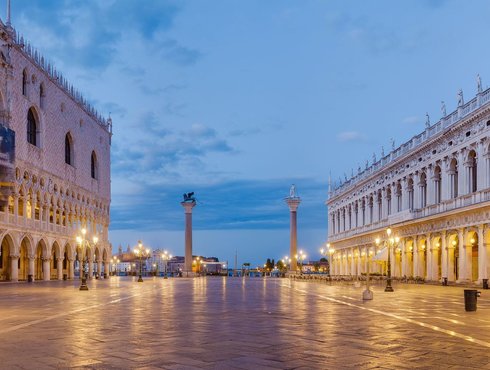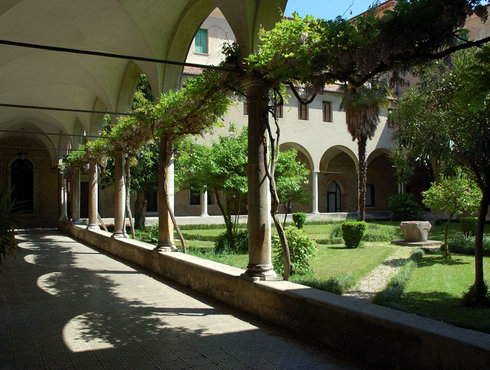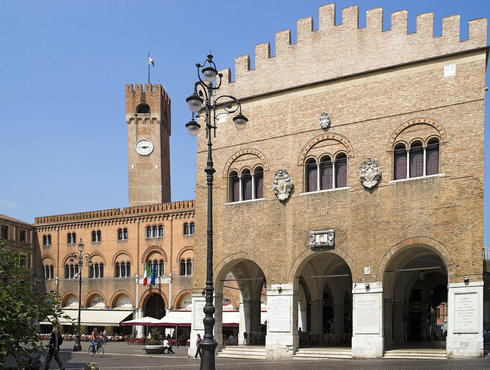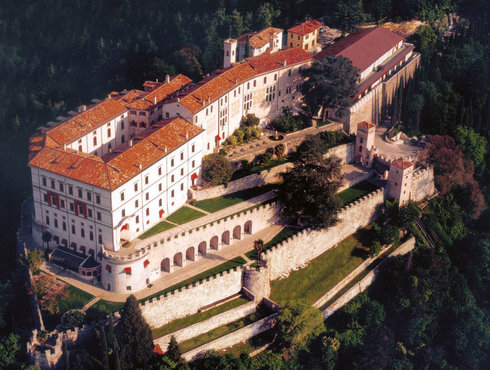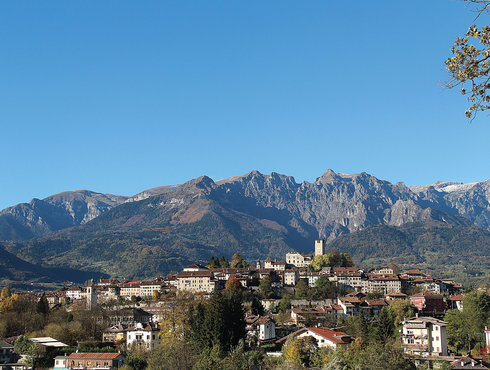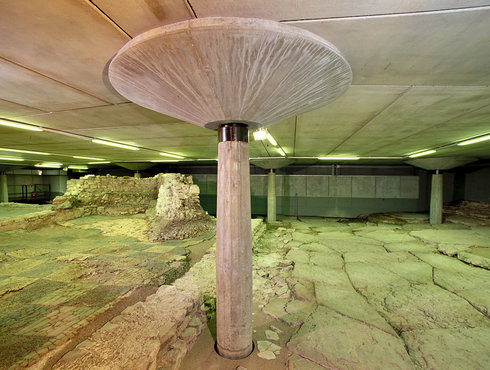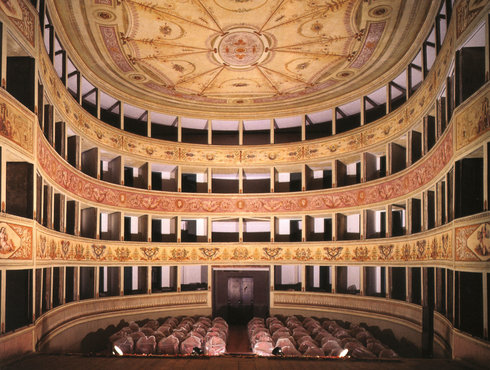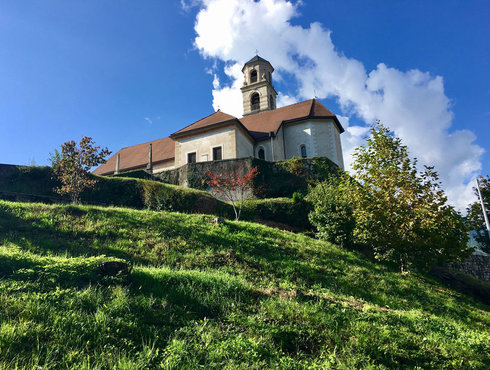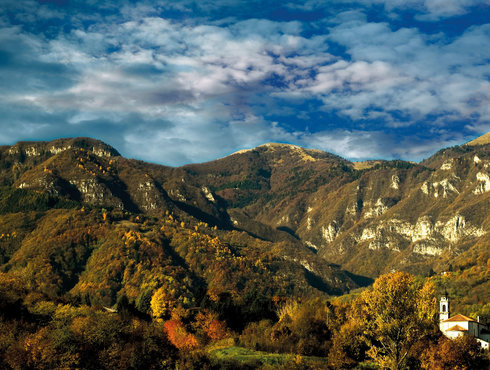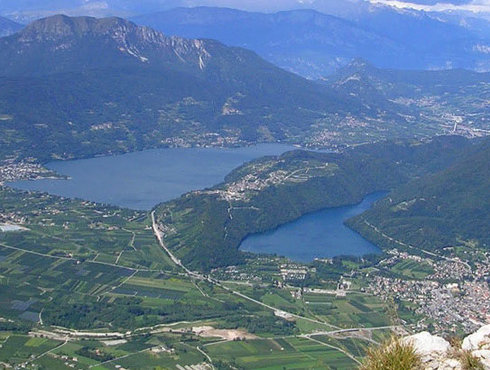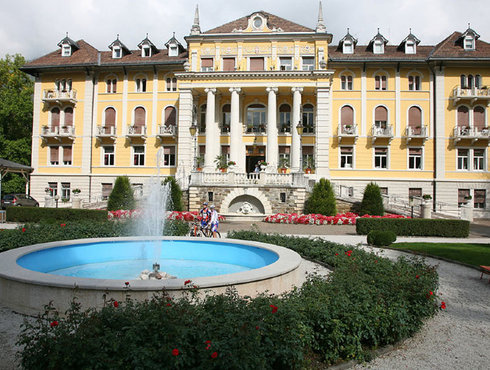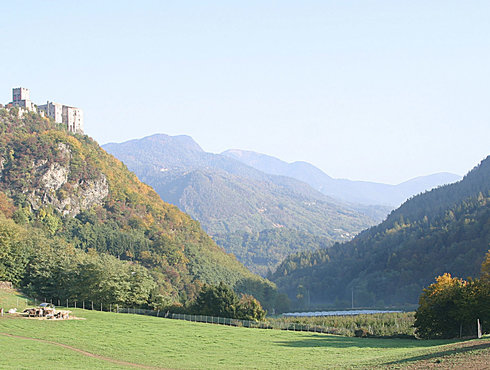The content menu at the start of the route description allows you to jump directly to the various sub-sections. You can also use the navigation elements at the end of each section to switch between the two variations of the road trip route, ‘ Altinate ’ and ‘ Padana ’ . You can use the detailed route description for reference during your long-distance hike alongside the maps available for download here . Alternatively, you can download offline navigation apps for your iPhone or Android or simply take a printed guidebook with you.
A road trip along the imperial road across the Alps (Padana version)
Jump to a specific section


The Via Claudia Augusta starts in the town of Donauwörth. This has two reasons: the Danube, which allowed the Romans to transport heavy goods, and the northern border of the Roman Empire, which was located here before and after the first retreat of the Roman Empire from the Germanic tribes. The northernmost part of the Roman road runs through the modern district of Donau-Ries, which nearly reaches the Limes in the north. Apart from the Danube, the area is characterized by the Ries crater. It has a diameter of 25 kilometers and was created by a meteorite 14.5 million years ago. The name ‘Ries’ is said to be derived from the Roman province of Rhaetia. Donauwörth, the town where the Roman road ends, did not exist during Roman times. Instead, the area was frequently flooded by five rivers whose confluence lies in the Donauwörth region: the Danube, Wörnitz, Zusam, Schmutter and Lech. The town began as a fishermen’s settlement on the island of Ried in the Wörnitz river. Today, most of the old town is located to the north of the river. It offers one of Germany’s most beautiful streets, the Reichsstraße.




In Roman times, there were already settlements in the estuary region of the rivers Wörnitz, Schmutter and Lech and in the part of the Lechtal valley bordering Augsburg. The inconspicuous little hill between Mertingen and Druisheim was the site of Submuntorium-Burghöfe, a Roman fortress complex. Another military site is said to have stood in Langweid am Lech. The towns up to Drusheim are still part of the district of Donau-Ries. Beyond Drusheim, the district of Augsburg begins. Its largest towns are Meitingen, which gained market privileges in 1989, and Gersthofen, which became a town in 1969. The Roman road follows the Lech towards Augsburg. In some parts, it is still a road. In others, it is a dam on the ground. Most of it is covered by the national road number 2 today. The Roman road runs past the floodplains of the Lech river, which separates the district of Augsburg from the Wittelsbacher Land.




After the Alpine Campaign in 15 B. C., Emperor Augustus’ adoptive sons, Drusus and Tiberius, established a military camp in Oberhausen, a northern district. The camp was the foundation of Augusta Vindelicum, the later capital of the province of Rhaetia. Augsburg is probably Germany’s second oldest city. It was most certainly one of the largest Roman towns north of the Alps. Spanning more than 25 ha, the settlement had up to 15,000 inhabitants in its heyday and offered them everything they would have expected from a Roman provincial capital: a temple, market hall, governor’s palace, theater, spas ... All townhouses had running water. The Via Claudia Augusta passed the town to the west. In the central area between the town hall and the Mercury fountain, it is identical to the historical main road through the old town. Augsburg rose to even greater significance in the late Middle Ages and the beginning of the modern era, when the rich Fugger family established their global business empire from here. Later, the prince-bishops of Augsburg reigned over a vast expanse of land that stretched all the way to Tyrol.


The Lechfeld is a strikingly flat gravel plain that gained tragic fame after the Battle of Lechfeld against Hungary in 955. There were already settlements here in Roman times. Historians believe that the Roman road station Ad Novas, marked on the ancient road map Tabula Peutingeriana, was located in Igling. Another fortress from the Late Roman Empire is believed to have stood in Untermeitingen. In the south, Augsburg borders the relatively new town of Königsbrunn, where you can visit a Temple of Mithras. Recent settlement of the area only occurred in the early 19th century. Like the towns up to Obermeitingen, Königsbrunn is part of the district of Augsburg. It borders the district of Landsberg am Lech to the south. From the Lechfeld, you can clearly see long sections of the Roman road, which runs steadily towards the Alps. The hiking route takes you through picturesque towns along the old country road. Graben is the home town of Hans Fugger.




The important salt road from Reichenhall to Munich crossed the Via Claudia Augusta here on its way to Switzerland. Duke Henry the Lion moved it a little way to the south from Kaufering in 1158. During that project, he had a bridge built and expanded the existing castle to protect it. The new complex was called the Castrum Landespurch. Nestled between the Lech and its high banks and overlooked by the castle, a settlement sprang up and grew rapidly. It would become the town of Landsberg in the 13th century. Today, the town to the west of the Lech is considerably larger, and its modern urban area dates back to the 19th century. The Via Claudia Augusta crossed some of the municipality westwards. Just like the river, it played an important role in the economic development of the town. The medieval old town is only accessible via the bridge over the Lech or its gates. It still retains some of its repeatedly expanded medieval walls. A recently redesigned main square is the town’s greatest attraction.




Between Landsberg and Schongau, the route leads crosses the Fuchstal valley to Epfach, the Roman Abodiacum before following the high banks of the Lech to Kinsau, Hohenfurch and Altenstadt, the mother parish of Schongau. Fuchstal is the valley of the Wiesbach river, a tributary of the Lech. It sits between the high banks of the Lech and a forested ridge to the west, next to the towns of Unterdießen, Asch, Leeder and Denklingen. ‘Fuchs’ is German for ‘fox’: the valley is said to be named for the brown color of its fields in fall. Just before Hohenfurch in the district of Weilheim-Schongau, you will climb the first hills since Donau-Ries. The villages in this section are particularly pretty and traditional. History enthusiasts will doubtlessly enjoy a visit to the site of the former Roman fortress of Abodiacum on the Lorenzberg, situated on a peninsula in the riverbend near Epfach.


During Roman times, another Roman road crossed the Alps via Garmisch and the Brennerpass. It was also called the Via Claudia, but it was not yet ‘Augusta’ (=imperial). In the Middle Ages, the roads that remained in use were dubbed the Upper Road and Lower Road. Their crossroads was an excellent spot to do business during Roman times and beyond. In Peiting to the east of the Lech, a Villa Rustica documents the outstanding domestic culture of the Romans. The town of Schongau, which was moved to the safer hill from its mother parish of Altenstadt in the 13th century, also flourished thanks to the nearby traffic hub. In 1331, the town was even granted the right to mint and issue its own coins. The old town has retained its entire town walls and can only be accessed through its gates. A large number of religious buildings also bear testimony to wealth of this region, which is called Pfaffenwinkel. Schongau and Peiting are considered its gateway. Wieskirche Pilgrimage Church is its best-known sacred building and a UNESCO World Heritage Site.


The Auerbergland: lands around a foothill that has seen settlements for millennia
- 08
The municipalities in the Alpine foothills around the Auerberg initiated the initiative to revive the entire length of the Via Claudia Augusta. In this region, the Auerbergland, there are particularly many visible sections of the old Roman road. Its inhabitants have come up with many interesting ways of drawing attention to this important part of their heritage. There are quite a few historical highlights here: the site of millennia-old settlements around the Auerberg, the rafters’ village of Lechbruck am See, the Bavarian Via Claudia Augusta info center, and the Forggensee boat tour that follows the Roman road are well worth your time. Verdant hills and forests punctuated by lakes and set against a spectacular Alpine backdrop make the region a nature lover’s paradise. Its pretty holiday destinations have retained their authentic village atmosphere. The Roman road mostly followed the Lech through the Auerbergland. Some parts crossed the river in the area where it was dammed to create the Forggensee lake.




The beautiful stretch of land where the Lech exits the Alps has been inhabited since Roman times. A Roman fortress used to stand on the Füssen’s castle hill. The Via Claudia Augusta passed beneath it. The Reichenstraße, the modern promenade in the old town, corresponds exactly to the route of the Roman road. At the valley station of the Tegelberg Cable Car, remnants of a private spa from a Villa Rustica grant us a glimpse into upper-class domestic life during the Roman Empire. The foundation of medieval Füssen and its long violin-making tradition date back to Saint Magnus of Füssen, who settled here as a religious hermit in the 8th century. In the 9th century, a Benedictine monastery was founded on the spot where his cell used to stand and named after him: St. Mang’s Abbey. Later, the people of Wittelsbach and Ludwig II of Bavaria discovered the spectacular natural landscape of the Alpine foothills, and the latter decided to build his fairytale castles here. You are standing in Schwangau, where guests of the Königliche Kristall-Therme spa get to unwind and let themselves be pampered just like the Romans used to do.








Text of the historical map of ...
100 AD
Gateway to the Alps
The Roman road entered the Alps as if through a gateway. As the Lech often occupied the entire valley, it already had to overcome two elevations up to the Reutte valley basin – between Stiglberg and Kratzer and at the Kniepass. The route of the Roman road remained in use until 1784 and the modern road still crosses the Kniepass today. Before climbing to Ehrenberg, the Via Claudia Augusta passed through the municipality of Breitenwang, where a road station (mansio) and the fifirst small settlement in the valley basin are thought to have been located. Reutte developed at a later stage – on the salt road. Breitenwang still remains the district’s ecclesiastic centre today.
1504
Reutte flourishes
With its extensive floodplains, the Lech also shaped the valley basin back in 1504 that depended significantly for its livelihood on the salt road between Hall in Tirol and the Lake Constance area. A bridge was built in 1464 between Lechaschau and Reutte that replaced the Lech ford near Höfen. With its salt depot and numerous roadside inns, Reutte grew into the centre of the Ausserfern district and in 1489 it was granted market rights by Sigesmund “the Rich”. Ehrenberg Castle throned above the valley. A wall blocked the gorge and all traffic had to pass through the customs station gate. There was an ironworks near Pflach. Vils, not yet part of Tyrol, was a town since 1327 and enclosed by a wall with two gates in the north and south.
1780
strongly fortified
Numerous fortifications in the border area between Bavaria and Tyrol shaped the area around 1780. In addition to the dam at Ehrenberg that had grown around two further fortresses, there were several outer fortresses. The market town of Reutte at their feet already had around 1,000 inhabitants and several new roads were completed. The road from Reutte via Vils to Kempten now passed by the walled city to the south, while that from Füssen to Pinswang went around the Stiglberg. The Ulrichs-brücke bridge was not constructed until 1914. Shortly after the turn of the century, the existing Bavarian local railway was also extended to join the Ausserfern railway that initially went to Reutte. The river was largely unregulated even around Reutte.


The first mountain ridges at the border between Germany and Austria form a gate, which the Via Claudia Augusta crossed into the Alps and the Reutte nature reserve region in Tyrol. This is where the only untouched section of the Lech in the northern Alps begins. The realm of the ‘last wild one’, as the nature park exhibition dubs the river, is dominated by extensive gravel banks and wetlands that cover the entire valley in some sections. Since time immemorial, the river has determined where settlements and roads could be built. Large parts of the valley have always been prone to flooding, so the Roman route of the Via Claudia Augusta crossed two plateaus between Füssen and the valley basin of Reutte: the mountain ridge between the Stiglberg and Kratzer and the Kniepass.


In the valley basin of Reutte, the Via Claudia Augusta led through Breitenwang towards Ehrenberg. It is believed that the town had a Roman road station just before the ascent. Around 1464, when the salt road from Hall in Tirol to the region around Lake Constance was relatively new, the Roman road was moved to Reutte, and the market town developed into a regional center. Many Roman buildings have survived to this day. Characteristic architectural artworks adorn the facades of the houses in Reutte; many of them were painted by the Zeiler family of artists. The fortress complex of Ehrenberg is located to the south of Reutte. Its four towering fortresses used to constitute a barrage against Bavaria. The complex even had outer baileys between Pflach and Pinswang/Musau, where the border used to be. Vils was a walled Bavarian town.






Text of the historical map of ...
400 AD
Masterful roads
The aim of the Roman road builders was to construct the quickest route from the Adriatic and the Po to the limes. Even in Tirol the Via Claudia Augusta therefore only has four hairpin bends. Nevertheless, the ffiirst trans-European road has a relatively constant incline even over the challenging sections across the passes. Another outstanding feat is the section on 1,000 tree trunks across the ‘Moos’ wetland habitat between Lermoos, Ehrwald and Biberwier, near to which two settlements were located – one in Ehrwald that already existed before the arrival of the Romans and continued to exist during the Roman era, and one founded by the Romans in the area surrounding the road station in Biberwier, immediately in front of the Fern Pass.
1599
Living from the road
While the Roman road was sustained by the fiffiirst European single market with no customs or tolls, the era of the salt road was shaped by the transport of goods. The local residents had the exclusive privilege of transporting certain goods such as salt from one place to the next. The population along the route benefiffiited from both of these systems. The population of Zwischentoren, the area between the Ehrenberg and Fernstein gates, is thought only to have become properly aware of this when the Arlberg Pass was made navigable again. As the traffiffiic shifted away, they became desperately poor. After meeting to say farewell at Austria’s only guild church in Bichlbach, many people from the Ausserfern district were forced to move as building workers to the neighbouring regions to the north. Children also moved away as ‘Swabian children’.
1926
Further development
A new wave of development started in the second half of the nineteenth century from Zwischentoren, the area between the two gates of Ehrenberg and Fernstein through which the Fern Pass road passed until 1856. It was then that today’s road was built. In 1913 the Ausserfern railway was extended that had previously terminated in Reutte. As an alternative to the completed route via Garmisch and on to Innsbruck, there was also talk of a line across the Gaistal, Leutasch and Seefeld. Furthermore, there were plans for a rail link to Imst with a summit tunnel through the Fern Pass of the sort currently being planned for cars. The Tyrolean Zugspitze Railway was one of the fiffiirst mountain railways and promot


From Heiterwang onwards, the landscape becomes more alpine. You can easily tell that it is covered in snow for longer stretches of the spring. This may be a blessing for holidaymakers, but it has always brought hard work and meager harvests to the farmers of the region. The area between the two gates of Ehrenberg and Fernstein is called ‘Zwischentoren’ (literally: between gates). Its people have depended on the road for a long time. Many operated small farms to grow their own food while also offering haulage and other services to passersby to make a living. The slopes of the mountains were mowed up to the peaks in order to feed the local animals and those of travelers. Between Heiterwang and Bichlbach , you can still see these slopes today. When the road over the Arlberg Pass and, later, the Arlberg railway were built, the road suddenly lost its status as an important thoroughfare, plunging the people of the road into bitter poverty. Many were forced to leave their home region to seek manual work elsewhere. The children who left the Alps for Swabia came to be known as ‘Swabian children’.




Once you enter Lermoos, you will know exactly why the region is called the Tyrolean Zugspitz Arena. The picturesque Moos wetland, which used to carry the Via Claudia Augusta on thousands of logs, is the ring of the arena. The quirky holiday destinations of Ehrwald, Lermoos and Biberwier sit on the box seats surrounding it. The spectacular mountains surrounding Lermoos are the stands. Among them towers the Zugspitze, Germany’s highest mountain. Since 1926, the Tyrolean Zugspitze Cable Car has transported passengers from Ehrwald to the summit. After the old road paled into insignificance, the construction of the cable car became a symbol of a new, brighter economic future for Zwischentoren in the tourism industry.






historical map of ...
100 AD
Old settlement area
There is documentary evidence of “Oppidum Humiste” dating back to 763. Oppidum was a fortifified pre-Roman settlement. Its mention after the Roman era points towards continuous settlement since pre-Roman times that will have been concentrated on the hill above Imst town centre. There are also indications of prehistoric settlement in Dormitz near Nassereith. The Romans established road stations in both places along the Via Claudia Augusta, around which settlements developed. In Imst, which was the most important settlement between Füssen and Merano, this was probably parallel to the pre-Roman settlement. There was also prehistoric and Roman settlement on the sunny slopes of the Tschirgant, in Karrösten and Karres.
1550
Mining stronghold
The area around the Via Claudia Augusta between Biberwier and the Inn Valley was an important mining centre in multiple respects. Signifificant historic mining districts were located in the Mieming mountain range in the east, the Lechtal Alps in the north and on the slopes of the Tschirgant in the south. Numerous tunnel entrances await discovery on close examination particularly in the Wannig rock face above Nassereith. Above all lead was mined as a grey ore for silver mining in Schwaz and Zink. Furthermore, Imst, alongside its importance as a market place and traffic hub, was the seat of the mining court covering an area that reached to the Ausserfern district and Vorarlberg.
1901
Long prevented town
Imst has for thousands of years been the most important settlement between Füssen and Merano and an important traffiffiific hub. It has had market rights since late medieval times and from the fifteenth to the seventeenth centuries it was the seat of a mining court covering an area that reached to the Ausserfern district and Vorarlberg. Had the infflluential lords of Starkenberg not opposed this because Imst would then have been directly subordinate to the territorial prince, the Gurgltal metropolis would have been a town with its own walls for 700 years. Following a ffiire in 1822 to which 206 out of 220 houses fell victim, Imst was rebuilt and ffiinally received town rights in 1898. Imst is also renowned for its bird breeders and dealers.


The Fernpass is the site of a landslide which blocked passage through the area about 4000 years ago. Nature arduously reclaimed the landscape over time. Even today, the topsoil is still thin, and the vegetation reflects that: despite the relatively low altitude of the pass (1216 meters today, 1260 in Roman times), you will spot high-alpine plants here. Paths and roads from the pre-Roman and Roman era, the early modern period, the 19th century and today criss-cross the fascinating landscape. Plans for a tunnel are being discussed. The Roman Via Claudia Augusta ran from Biberwier to the old top of the Fernpass in a straight line. Its route is mostly identical with that of the power line in this area. From the highest point of the pass, the road steadily descended down the slope to the Samerangersee lake. In the late Middle Ages, the Fernpass road was rerouted to cross the top of the Fernpass we know today.


The Gurgltal valley is an idyllic landscape that is popular with local and foreign leisure-seekers alike. Humans settled in the picturesque valley at a very early stage. Historians believe that the shrine in the village of Dollinger-Lager on the northern slopes between Nassereith and Tarrenz was in use between the Hallstatt period and the Roman age. From Fernstein, the Roman road ran to the parish church of Nassereith in a straight line before nestling into the southern side of the valley, avoiding the sunny side, which was prone to rockfall. It only crossed the valley between Strad and Tarrenz and continued towards Imst along the sunny slopes. Nassereith was already a traffic hub in prehistorical times and during the Roman Empire: this is where the roads through the Gurgltal valley and across the Mieminger Plateau met. Archaeologists have proven that a Roman settlement existed in Dormitz, a little way away from the Roman Via Claudia Augusta. Roman roadside guesthouse in the Strader Wald forest It is also believed that a Roman road station stood in the Dormitz area. The section between the Fernpass and Imst used to be one of Tyrol’s most important mining areas. Visit the Knappenwelt Gurgltal, an authentically reconstructed mining village in Tarrenz, to learn more about this aspect of the history of this region. The locals predominantly mined galena, which they used to produce silver from the ores found in Schwaz, and zinc. Imst, the district capital, was also the seat of the mining court, whose jurisdiction covered a large area stretching to the Ausserfern, Reschenpass and Vorarlberg. The Via Claudia Augusta was also used as a transportation route for the mining sector. And the three towns of the Gurgltal valley – Nassereith, Tarrenz and Imst – share another important tradition: the Carnival.




Records from the 7th century mention an ‘Oppidum Humiste’. This almost certainly refers to Imst, which also used to be a road station on the Via Claudia Augusta. The term ‘Oppidum’ even suggests a fortified settlement from pre-Roman times. It is likely that the district capital was inhabited permanently from Rhaetian times through the Roman Empire until the 7th century. The Laurentiuskirche church on the striking Bergl hill above the town center dates back to the 5th century A. D. and shows that the settlement was already quite large back then. It was probably the largest settlement between Füssen and Meran/Merano. Roman Imst is buried under the old town, however, and what little remains of its is difficult to study. Later, the current district capital of Imst became the seat of the central mining authority and the home of the bird trading profession, which inspired the popular operetta ‘The Bird Seller’. The people of Imst are particularly proud of their traditional Carnival, which takes place every four years. Have a look at the museum dedicated to it.






Text of the historical maps of ...
before the year 0
Early densely populated
Already in early history, the area around Landeck was relatively densely populated. Above Schönwies, in Stanz and Grins, in Perjen, in Fließ, at the entrance to the Kaunertal, in Fiss and Serfaus, ... - on every sunny slope and every high terrace settlements are proven or at least there are indications of settlement. The settlements were connected by cart paths. In addition to one in the Inn valley, there was also a shortcut from the Kaunertal valley over the Piller Sattel to Imst. Above Fliess was a burnt offering site where gods were invoked for centuries, until Roman times. In the archaeological museum of Fliess you can marvel at early historical finds from this time, which you can otherwise only find in such abundance and quality in large cities.
450
early Christian churches
In the Landeck area the Via Claudia Augusta largely ran along the slope – the section between the Inn bridge near Starkenbach and Landeck followed the striking and picturesque route over the “Platte” to Fließ, where ruts in the rock dating from different periods tell stories about the road. The Via Claudia Augusta only left the slope in the vicinity of Landeck Castle – presumably because there was a road station there and the road branched off over the Arlberg. The important transport connection not only brought economic development but also a lively cultural exchange that is reflected among other things in the area’s early Christianisation. The parish church in Landeck and St. Lawrence’s Church on the hill above Imst have their roots in the fififth century, while the ‘Maaßkirche’ church next to the archaeological museum in Fließ dates back to the sixth century.
1787
Landeck as a transport hub
Two long-distance roads already converged for the first time back in Roman times at the confluence of the Sanna and the Inn. In 1787 the road to Vorarlberg, that had for a long time no longer been navigable, was renewed and restored to new life and the valley basin finally became a transport hub. The rest was done by the construction of the Arlberg railway in 1884, during which 800 jobs were also created and the population grew rapidly. Around 1900, the municipalities of Perfuchs and Angedair were merged into Landeck, that gained market rights in 1904 and became a town in 1923. Landeck had already been a municipal centre since 1868 when there was not yet even a place called Landeck but only the castle. The loser of the shift of the east-west traffic corridor to the Arlberg route was incidentally Zwischentoren, between Fernstein and Reutte. Many of the bitterly poor people of Ausserfern consequently became migrant workers in the more prosperous neighbouring regions to the north.


The Inntal valley between Imst and Landeck offers pleasant villages, one of the few remaining floodplains of the Inn, and Kronburg castle throning high above the valley on a rock. You will also be treated to spectacular views of the surrounding mountains. Do not forget to look back at the Tschirgant between the Inntal and Gurgltal valleys. Around the halfway mark between Imst and Landeck lies Mils with the motorway service area and ‘adventure village’ of Trofana Tyrol. It offers all services which an old Roman road station would have offered to travelers along the Via Claudia Augusta – and then some.




The sunny slopes around Landeck have been the site of human settlement since pre-Roman and Roman times. Many archaeological finds have proven that: in Fließ, Stanz, Grins and near Kronburg castle. As was recently determined, the parish church of Landeck dates back to early Christianity, suggesting a sizable Roman settlement. Archaeologists already assumed that a Roman road station stood in today’s district capital, as the Roman road leads from the slopes into the valley here. Landeck is surrounded by multiple fortress complexes. Schloss Landeck castle, the former seat of the court, is the most significant and the best preserved of them. The Arlberg railway was a major catalyst for the development of the town. The sunny slopes of the valley are favorable for agriculture as well as human settlement. Do not miss your chance to sample the excellent produce of this culinary region.






Text of the historical maps of ...
100 AD
Road mostly at valley floor
Owing the narrowness of the valley, which was at risk of rockfall and often entirely flooded by the Inn, the Via Claudia Augusta ran along the slope between Landeck and Fließ, across the Fliesser Platte in which the carts left traces in the rock in the different periods. Back in the valley, the Roman road was then able to continue – with various river crossings – along the valley floor until Altfinstermünz, as nature narrowed the course of this section of the Inn. From Finstermünz the road climbed steadily at a gradient of 11% up through the gorge to Inutrium, the only road station for which there is written evidence, shortly before reaching its highest point, the Reschen Pass. There are thought to have been two more road stations between Prutz and Pfunds. Fließ and Inutrium were definitely inhabited.
1530
Road and mining
The Roman road largely remained in use in the Middle Ages and modern era. Fortresses such as Pidenegg, Pernegg, Laudegg, Siegmundsriedt, Finstermünz and Naudersberg lined the transport routes. Apart from the main roads, there were almost only mule tracks. As well as self-sufficient farming and earnings opportunities in connection with the road, income was also generated by mining – first in Kaunertal, then in Bergtal and later in Platzertal. Ore was also extracted in Serfaus and smelted in Fließ.
1910
New transport routes
For a long time there were discussions about how to modernise the Reschenstrasse. The modern road builders finally got their way and the road was constructed between 1852 and 1856 with hairpin bends and galleries many of which are still in use today. Roads were also built to the Engadine, to Samnaun and to the mines of Platzertal. The ore was also transported with a goods cable lift. As well as investments in the roads, there were also two different plans for a rail link across the Reschen Pass for which a large number of tunnels would have been necessary. The northernmost fortress of Austria-Hungary facing Italy bears witness to the strategically important location of the pass.


The Oberes Gericht (‘upper court’) is an area stretching from Landeck to Nauders. Its name is based on the seat of the court, which used to be at Schloss Laudegg castle above Prutz before moving to Schloss Siegmundsried castle in the 17th century. This is one of the Via Claudia Augusta’s best-preserved sections. It illustrates well how important the road was for the development of settlements. Many sections of the old country road, which has been replaced by the parallel B180 since, correspond to the Roman road. It passes picturesque towns and hamlets, castles and fortresses, manors and inns, farms and churches and a few old bridges. The most impressive bridge is that at Altfinstermünz, which used to be a customs station erected by the Romans where the Roman road crossed the Inn river.




In the olden days, the Alpine passes were extremely challenging. That is why the Romans liked to build rest stations before and after each pass. At an altitude of 1507, meters, the Reschenpass is the highest point of the Via Claudia Augusta. Its peak is in Italy. The Austrian municipality of Nauders, a little to the north, used to be the site of the only Roman road station documented in writing: Inutrium. Today, holidaymakers flock to the high valley. They enjoy the beautiful mountainscapes around Nauders, Reschen/Resia, Graun/Curon, and St. Valentin/San Valentino in summer and winter alike. These four towns are in two countries and tourism regions, but they are all part of the geographical region of the Vinschgau valley. Visitors also appreciate the reservoirs that were created on the pass. The steeple of the submerged Altgrauner church protruding from the water is one of the most popular photo motifs on the route.




This region is filled with historical town centers and buildings like few others along the Via Claudia Augusta. Due to its favorable climate, the Vinschgau valley has been a popular place of human settlement since long before the Romans arrived. Its name is derived from the Venostes, a Rhaetian tribe settled on the Tartscher Bichl and the Ganglegg above Schluderns/Sluderno among other sites. The historical route of the Via Claudia Augusta led across the Mals heath, where archaeologists have identified a former Roman road station, and followed the sunny side of the valley after Mals/Malles. In the 10th century, Romanic farmers populated the region more densely and made the ground arable. Marienberg monastery supported them from the 12th century onwards. Multiple castles, the medieval town of Glurns/Glorenza with its fully preserved walls, and the centers of the surrounding villages bear witness to those times. Building on its rich heritage, the Vinschgau valley presents itself as a historically significant cultural region of South Tyrol.




The heart of the fruitful Vinschgau valley lies on the foothills of the Sonnenberg mountain. The Roman road is likely to have passed this area, where the marble village of Laas/Lasa and the regional capital, the market town of Schlanders/Silandro, are located today. Nomadic herders and hunters were present here as early as the Neolithic, attracted by sunny weather and low rainfall due to the high mountain ranges in the north and south. Since Roman times or earlier, the locals have mined the famous marble of Laas/Lasa and Göflan/Covelano. The milestone of the Via Claudia Augusta found at Rabland/Rablà provides evidence of this. Schlanders/Silandro and Laas/Lasa are first mentioned in writing in records from the late 11th and early 12th century. In the 14th century, Schlanders/Silandro became the seat of the court.




There are about ten fortress complexes and stately homes dotted around the narrow pass in the middle of the geographical Vinschgau valley region, which stretches up all the way to the Töll/Tel valley step. They were built very close to each other and helped secure this strategically important location. The most important structures are Schloss Goldrain castle, the educational and cultural center of the Vinschgau valley, Kastelbell/Castelbello with its permanent exhibition on the Via Claudia Augusta, and Reinhold Messner’s summer residence of Juval, high up on the mountain. Blessed with a diverse microclimate offering plenty of sunshine, low precipitation and cool breezes at night, the region is home to a relatively recent tradition of growing a wide variety of quality wines. Kastelbell-Tschars/Castelbello-Ciardes is the largest wine-growing area in the valley, spanning an area of 25.5 hectares. Chardonnay, Pinot Blanc, Pinot Grigio, Gewürztraminer, Riesling, Vernatsch, Zweigelt and Pinot Noir ripen here.
The market town of Latsch/Laces consists of a main district, the two subdivisions of Goldrain/Coldrano and Morter in the valley, and Tartsch/Tarres on a debris flow cone. Make sure you visit the hospital church of Latsch/Laces to see its winged altar, designed by Jörg Lederer. The mountain chapel of St. Stefan near Obermontan and Untermontan in Morter is considered the ‘Sistine Chapel of South Tyrol’ thanks to its splendid murals. Schloss Goldrain castle, built gradually from 1475 onwards, is worth visiting for its enclosing wall, portals, free-standing staircases and recessed balconies. All important construction parts are made from white marble. Also have a look at the 5000-year-old menhir (standing stone) of Latsch/Laces. It can be viewed every Monday at the Bichlkirche near the entrance to the village, where it was originally found.
Its location at the narrowest part of the valley and the castle on the promontory by the road give the village a particularly striking appearance. 39020 Kastelbell, Staatsstraße 5, +39 0473 624 193, Guided tours available from 17 June to 14 September: Tue–Sun, 11 am, 2 pm, 3 pm and 4 pm. Minimum group size: 4 people, www.schloss-kastelbell.com. The canal path is worth a detour. Tschars/Ciardes, which was merged with Kastelbell/Castelbello in 1928, is located on a debris flow cone on the sunny side of the valley, which is a little wider again here. Reinhold Messner’s summer residence Juval, just above the entrance to the Schnalstal valley, houses the Tibetika collection at the Messner Mountain Museum. Kastelbell, Juval 3, +39 348 443 38 71, open between the fourth Sunday of March to 30 June and from 1 September to the first Sunday in November, 10 am–4 pm, closed on Wednesdays, www.messner-mountain-museum.it
For information, contact
Via Claudia Augusta Info
www.viaclaudia.org/en
info@viaclaudia.org
0043 664 27 63 555
For specific questions about the region, contact the
Vinschgau tourist information
www.vinschgau.net
info@vinschgaumarketing.net
0039 0473 620 480


The lower Vinschgau valley, Naturns/Naturno, Plaus, Rabland/Rablà and Partschins/Parcines
- 24
While the municipalities of Naturns/Naturno, Plaus and Partschins/Parcines are geographically part of the Vinschgau valley, they belong to the administrative district of Burggrafenamt and the tourism association of the Meran/Merano and environs. The earliest evidence of human settlement found on the southern mountain pass date back to the Mesolithic. The name ‘Naturns’ comes from the Celts and translates to ‘settlements on the meadow’. Human settlement of this region has continued uninterrupted. One of the two milestones of the Via Claudia Augusta was found in Rabland/Rablà. The Prokuluskirchlein, a little church in the eastern part of Naturns/Naturno, dates back to the 7th century. Its inner frescoes were probably painted in the 8th century, making them the oldest in the German-speaking cultural sphere. Visit the St. Prokulus museum to learn about the history of the region from its multimedial exhibition.




The old bridge over the Etsch river in Algund/Lagundo, Marling/Marlengo and Meran/Merano
- 25
The 200-meter terrace near Töll/Tel takes you from the Vinschgau valley into the Mediterranean garden village of Algund/Lagundo. Its lower altitude and sheltered location make this region one of Italy’s warmest: palm trees, cypresses and olive trees grow alongside birch trees and sycamores. There are many gardens with southern plants here. They give the village a feeling of existing simultaneously in the Alps and the Mediterranean. The Roman road had a bridge here. It crossed the Etsch river near Schloss Forst castle, then headed back up the hill and onwards to the panoramic village of Marling/Marlengo on the western slopes above Meran/Merano. To this day, there are bridges over the Etsch river between Algund/Lagundo and Marling/Marlengo. The Brückenkopf museum in Algund/Lagundo tells the story of the historical ones. Two of the most beautiful canal paths lead through the beautiful landscapes dotted with vineyards and apple orchards, the Algunder Waal and the Marlinger Waal. In and around Meran/Merano, you will also find the only wellness spa along the Via Claudia Augusta, the gardens of Schloss Trauttmansdorf castle, and Schloss Tirol castle. The area is a holistic region of well-being awash with mother nature’s ripest bounty.




Between Meran/Merano and Bolzano/Bozen, the Roman road crossed the Etschtal valley along its western slope. Prehistoric settlements existed on its many hills. In Nals/Nalles, archaeologists discovered a house with a underfloor heating system, bathing complex and apsis from late antiquity. The Aschbach river in Gargazon/Gargazzone marked the boundary between the Roman provinces of Rhaetia I and Rhaetia II. To this day, this region is a border region. From the 13th century onwards, countless fortresses sprang up, giving the area the highest density of castles in Europe. Some of the towns in the region are very old: St. George’s Church and St. Margaret’s Church in Lana both date back to the 9th century, for instance. The locals lived off the produce of their land and business which the road brought; some worked in mining. Important silver mines existed in Nals/Nalles and Terlan/Terlano. In the 15th century, as many as 1000 miners were digging for ores in more than 30 pits in Terlan/Terlano alone. From Andrian/Andriano onwards, the Etsch river was navigable, facilitating the transport of silver to the south.




Researchers believe that the Pons Drusi, a bridge on the Roman road that is mentioned in early records, was located at the spot where today’s Drusus Bridge crosses the Eisack river, a little way to the west of its confluence of the Talfer and the Eisack. Before, it crossed the Etsch and the valley basin at the foot of Siegmundskron castle. The valley basin is occupied entirely by the capital of the autonomous province today. Between 1170 and 1180, the town was built as a planned market settlement with a central street and a marketplace (the Kornplatz). It was expanded several times later.
In Frangart/Frangarto at the foot of Schloss Siegmundskron, where the Messner Mountain Museum Firmian explores the relationship between humans and the mountains, the historical route and our travel route turn towards the town center. They cross the Etsch river and the wide valley basin. The alley and the bridge that lead towards the old town are named after Drusus, who once led the Romans across the Alps and ordered the expansion of the existing paths to create a road. MMM Firmian, Bozen, Sigmundskronerstraße 53, +43 0471 631 264, open from the first Sunday in March until the third Sunday in November, 10 am–6 pm, closed on Thursdays, last entry at 5 pm, www.messner-mountain-museum.it.
Leave your car at the BZ Mitte P8 parking garage behind the railway station, the small parking garage at the Rittner Cable Car, or in the underground parking garage at Waltherplatz, where our walk begins. Waltherplatz square and the monument at its center are dedicated to the troubadour Walther von der Vogelweide. From here, you can take a shuttle up to Schloss Runkelstein castle in the north of the town, which has some of the most significant profane frescoes in the Alps. +39 0471 329 808, Tue–Sun, until 15 March: 10 am–5 pm (last entry at 4:30 pm), after 16 March: 10 am–6 pm (last entry at 5:30 pm), www.runkelstein.info. Kornplatz square used to host the grain market. The mercantile museum is located in the former chamber of commerce in the middle of the picturesque Laubengasse street, +39 0471 945 702, Mon–Sat 10 am–12:30 noon. Its exhibitions recount the economic history of South Tyrol. The town hall is at the eastern end of the street. Continue a little further and you will find the Nature Museum of South Tyrol +39 0471 412 964, open Tue–Sun, 10 am–6 pm, www.naturmuseum.it. For a lovely view of the town, walk a few minutes to the Rittner cable car and let it take you to the Ritten high plateau. Operates all year round. www.ritten.com. Franziskanerstraße leads to the Franciscan Church, the Franciscan Monastery and the western end of the Laubengasse. A little further to the west, you will find the South Tyrol Museum of Archaeology with the preserved body of Ötzi the Iceman, +39 0471 320 100, opening hours in July, August and December: every day 10 am–6 pm, closed on Mondays in all other months, last entry at 5:30 pm, www.iceman.it. There is also the Civic Museum, which houses one of the two original milestones that document the existence of the Via Claudia Augusta +39 0471 997 960, Tue–Sun, 10 am–6 pm. Cross the Talferbrücke bridge to see the Victory Monument, one of the last remaining monuments erected during fascism. Cross the Talfer river on the new cycle and pedestrian bridge and head to the Museion, a museum of modern and contemporary art. +39 0471 223 413, open Tues–Sun: 10 am–6 pm, last entry: 5:30 pm, Thu: 10 am–10 pm, free entry from 6–10 pm, free guided tour at 7 pm, last entry at 9:30 pm, www.museion.it. The town theater and concert hall are located in a building near the Eisack river. Finish your tour of the town at the Gothic cathedral Maria Himmelfahrt from the 12th century and admire its treasury. It used to stand outside of the town walls. +39 0471 978 676, Tue–Sat: 10 am–12 noon.
For information about the entire route, contact
Via Claudia Augusta Info
www.viaclaudia.org/en
info@viaclaudia.org
0043 664 27 63 555
For specific questions about the region, contact
www.suedtirol.info/en
info@suedtirol.info
0039 0471 999 999


Bridges used to be expensive and difficult to build and maintain. That is why they were few and far between, and a road had to be built into the slopes on both sides of the river. A Roman road probably ran along today’s South Tyrolean Wine Road, crossing the well-known wine-growing villages of St. Pauls/San Paolo, St. Michael/San Michele, Kaltern am See/Caldaro, Tramin/Termeno, Kurtatsch/Cortaccia, Margreid/Magrè, and Kurtinig/Cortina. The Via Claudia Augusta itself is likely to have clung to the eastern slope on its way to the south. It would have led from the foot of the striking Castelfeder hill in Auer/Ora, which has been a site of human settlement for millennia, to the proven Roman road station of Endidae in the modern village of Neumarkt/Egna and onwards to Salorno/Salurn, where the famous Salurner Klause used to be. From Bronzolo/Branzoll near South Tyrol’s southernmost and most recently built city, Laives/Leifers, the Etsch river was navigable by raft. Until the construction of the railway, it was the most important transportation route for the economy of South Tyrol and Trentino.




The drift washed up by the Noce river from the Nonstal valley dammed the Etsch river, creating a large lake that filled the entire valley. It formed a natural border between the municipalities in the south of South Tyrol, those of the Nonstal valley, and those to the north of Trento. This made it more difficult for the people of the various localities to interact with each other and contributed to the emergence of the language border between the German-speaking and Italian-speaking areas. Today, the inhabitants of the Piana Rotaliana all speak Italian. But the water also created a border across the region: Mezzocorona (Kronmetz), today’s agricultural center, is culturally more German, while the traditional mercantile centers of Mezzolombardo at the entrance to the Nonstal valley and Lavis at the entrance of the Avisio valley are culturally Italian with impressive palazzi. The lake no longer exists. The soil on the drift from the Noce river is particularly fertile. All of the Piana Rotaliana and its slopes are covered in vineyards, where the famous Teroldego grapes ripen – a regional specialty. The former Foundation of San Michele all’Adige contributed considerably to the flourishing of this region. To this day, its Istituto Agrario is the agricultural competence center of the entire Trentino, and its local-history museum documents the customs and traditions of the state. Of all the palaces and fortresses in the region, the San Gottardo grotto castle behind Mezzocorona is the best known.






As the name suggests, Trento has Rhaetian origins. It was already an important traffic hub during their time. The Via Claudia Augusta forked in Tridentum. The road leading to the Adriatic port town of Altinum near Venice was the Via Claudia Augusta Altinate; the road leading to the river port of Ostiglia on the Po river was the Via Claudia Augusta Padana. From there, another road led to Rome. The later historical significance of the city is primarily due to the Council of Trent (1545–1563). It initiated the Counter-Reformation and delineated its intellectual foundations. The map of today’s Old Town was shaped significantly during that period. Later, Baroque buildings were added to the Renaissance-style district. Until the invasion of the Napoleonic Troops, the prince-bishops of Trento rules over the city and the surrounding region from the their base in the majestic Buonconsiglio Castle.
The city of Trento begins at the bridge across the Avisio river in Lavis. In Roman times, the old road towards Altino near Venice led up the hill to the Valsugana. Our route largely follows the historical route into the town of Meano, where you can catch your first glimpse of the birthplace of the Council of Trent. Head back down into the valley and continue towards the old town with its Renaissance buildings.
You can leave your car in the car park at Via Torre Verde 40 on the edge of the old town while you go for a leisurely walk. As you enter the historical part of the city, the tourist information office and contemporary art gallery will be among the first buildings you see. Head towards the Piazza Cesare Battisti. The excavated ancient Roman city of Tridentum is located underneath it. Walk down Via Belenzani, lined with Renaissance palazzi, and pass the town hall inside the Palazzo Thun to reach the cathedral square. The parallel alleys of Via Cavour to the west and Via Oss Mazzurana to the east can easily compete with the splendor of their larger neighbor. The Tridentine Diocesan Museum and the Vigilio Cathedral are also on the cathedral square. Finish your walk at Buonconsiglio Castle, where you can visit the historical museum of Trento.
For information about the entire route, contact
Via Claudia Augusta Info
www.viaclaudia.org/en
info@viaclaudia.org
0043 664 27 63 555


To the south of Trento lies the southernmost part of the Etschtal valley: the Vallagarina. Its captivating landscape has remained wholly unspoilt despite its location between conurbations and along one of Europe’s most important thoroughfares. Historically grown villages nestle in picturesque valleys, mountains and hills lined with sprawling vineyards. Medieval castles punctuate the area.
The Vallagarina begins at the Murazzi gorge to the south of Mattarello. Humans have inhabited this area since Roman times or earlier. Pomarolo and Besenello are first mentioned in records from the 12th century. The valley is dotted with fortresses, showing the strategic significance of its location at the southern gateway to the Alps. Some of the fortresses were built by the Austro-Hungarian monarchy. The 12th-century Beseno castle above Besenello is the largest fortress between the Reschenpass and Verona. You can easily spot the impressive structure from afar. Its interior is decorated with many frescoes. The castle complex houses a branch of the museum at Buonconsiglio castle. It is well worth a visit, not least because of the spectacular views of the Vallagarina below.
38060 Besenello, Via al Castello 4, +39 0464 834600, opening hours from mid-March to mid-May: Tue–Sun 9:30 am–5 pm, from mid-May to the beginning of Nov: Tue–Sun 10 am–6 pm, from Nov–mid-March: Sat and Sun only, 9:30 am–5 pm, www.buonconsiglio.it
Castel Pietra, 38060 Calliano, Via Castelpietra 1, +39 335 588 28 91, contact the private owners of the castle to arrange a guided tour, www.castelpietra.info.
Castello di Castellano, 38060 Castellano, +39 0464 801 177, contact the private owners of the castle to arrange a guided tour.
Castel Noarna, 38060 Noarna di Nogaredo, Via Castelnuovo 19, guided tours with a wine tasting available daily for groups of 10 or more upon prior arrangement, www.castelnuoarna.com.
Tridentine Diocesan Museum, Palazzo Libera, 38060 Villa Lagarina, Via Garibaldi 10, +39 464 490 374, open Wed–Fri, 2–6 pm, Sat and Sun 10 am–12:30 pm and 2 pm–6 pm, www.museodiocesanotridentino.it
For information about the entire route, contact
Via Claudia Augusta Info
www.viaclaudia.org/en
info@viaclaudia.org
0043 664 27 63 555
For specific questions about the region, contact the
Tourist information from the APT Rovereto e Vallagarina
www.visitrovereto.it
38068 Rovereto, Corso Antonio Rosmini 21
38060 Brentonico (TN), Via F. Filzi 23
info@visitrovereto.it
0039 464 430 363




Trentino’s second city is the capital of the Vallagarina district. Its charming old town and the important MART gallery of contemporary art make it an important tourist attraction. Historians believe that there used to be an Iron Age settlement here. The Romans had a fort here. This important road and the raft factory on the Etsch river between the Alps and Veneto remained a significant economic factor. Rovereto experienced its heyday in the 18th century, when the silk industry, established by the Venetians, was at its height. The region was one of the most fiercely contested areas in the First World War. Countless forts in the mountains to the east of the city serve as war memorials today. They have given the city its image as a ‘city of peace’.
Rovereto is a lovely labyrinth of narrow alleyways and palaces, many of which have obvious Venetian and Austrian influences. We recommend that you park your car in the parking lot at the corner of Corso Rosmini and Via Poli during your walk. Visit Italy’s oldest urban museum for a perfect start to your trip. Borgo Santa Caterina 41, +39 0464 452 800, open Tue–Sun 9:00 am–noon and 3:00 pm–6:00 pm, from 1 July– 16 October also open on Fri and Sun from 8:00 pm to 10:00 pm, closed on Mondays (except public holidays), www.museocivico.rovereto.tn.it. Head a little further and you will find the birthplace of the famous philosopher Anton Rosmini. Via Stoppani 3, +39 0464 420 788, by appointment only. At the Palazzo Todeschi-Micheli at Via Mercerie 14, Mozart played his first successful concert in Italy. The Ponte Forbato over the Leno river was destroyed in a flood in 1797 and rebuilt in 1840. On the opposite shore of the river stands the Casa dei Turchi (Turkish House). The towering Castello Rovereto from the 14th century houses Italy’s largest war museum. Borgo Santa Caterina 7, +39 0464 438 100, open Tue–Sun 9:00 am–noon and 3:00 pm–6:00 pm, from 1 July– 16 October also open on Fri and Sun from 8:00 pm to 10:00 pm, closed on Mondays (except public holidays), www.museodellaguerra.it. The elegant Palazzo Pretorio houses the municipal administration. It was built in 1417 in the Venetian style. The Palazzo del Ben (also: dei Conti D‘Arco) on the Piazza Rosmini is a gem of Renaissance architecture made available to the public for cultural activities by the Sparkasse Trento and Rovereto bank. A little further, you will find the MART art museum. The Palazzo dell‘Annona, which houses a library, is a part of it. MART, Rovereto, Corso Bettini 43, +39 0464 438 887, open Tue–Sun 10:00 am–6:00 pm, Fri 10:00 am–9:00 pm, closed on Mondays (except public holidays), www.mart.trento.it. Opposite the Giorgio Perlasca Park stands Trentino’s very first theater: the Theater Zandonai. There is also the Neoclassical Piamarta Palace, better known as the Palazzo della Pubblica Istruzione (‘palace of public teaching’).
For information, contact
Via Claudia Augusta Info
www.viaclaudia.org/en
info@viaclaudia.org
0043 664 27 63 555
For specific questions about the region, contact the
Tourist information from the APT Rovereto e Vallagarina
www.visitrovereto.it
38068 Rovereto, Corso Antonio Rosmini 21
38060 Brentonico (TN), Via F. Filzi 23
info@visitrovereto.it
0039 464 430 363


The border between Trentino and Veneto runs south of the Vallagarina. Here, the Etschtal valley turns into the plain of the Pianura Padana. This region used to be heavily contested. Until 1919, it was a part of the Austro-Hungarian Empire. The German names of the local towns and villages date back to that time, and the influence of the German cultural sphere is omnipresent. All over the southern Vallagarina, you will find lovely landscapes and picture-perfect villages.
There is a bell in the south of Rovereto that tolls a hundred times every evening to commemorate the war dead. The military memorial of Castel Dante contains the mortal remains of 20,000 Italian, Austrian, Czech and Hungarian soldiers. 38068 Rovereto, Via Castel Dante, +39 0464 432 480 or +39 348 7700 541, open Tue–Sat 9 am–12 noon and 2–4 pm. Closed on public holidays. The Manufattura Tabacchi from the mid-19th century recounts the early industrial and social history of the region. Rovereto, Piazza della Manifattura 1, +39 0464 443 313, open to groups, www.progettomanifattura.it. In Isera, the postcard museum showcases 35,000 pictures of Trentino and South Tyrol. Via Galvagni 10, +39 0464 420 840, open Mon–Sat 9 am–12 noon and 2:30–5 pm, www.museodellacartolina.it. The 10th-century Corno castle overlooks the town Località Lenzima, +39 0464 433 792, open 5 Apr–end of September Sat and Sun, 10 am–7 pm
The town of Mori has a population of nearly 10,000. It borders Torbole on Lake Garda and Brentonico on Monte Baldo, a 30-kilometer mountain ridge that separates Italy’s largest lake from the Etschtal valley. Its sheltered eastern slope protruded from the ice throughout the entire Ice Age. Today, it is home to unique plants found nowhere else in Europe. Visit the Palazzo Eccheli Baisi for its exhibition of regional plants and fossils. 38060 Brentonico, Via Mantova 4, +39 0464 39 50 59, open from May to Jun: Tue–Sun, 10 am to 12 noon and 4–6 pm, Jul–Sep: Tue–Sun, 10 am–12 noon and 4–6:30 pm.
The actual border town is Avio – to be precise, its Borghetto district. Ala is another town close to the border. It used to function as a frontier station between Austria and Italy. Both have been shaped by a long history of varying influences. Walk the narrow alleyways of their historical centers to discover numerous palazzi. The Palazzi de' Pizzini in Ala houses the Antique Piano Museum, which is all about the wonders of classical music. 38061 Ala, Via Santa Caterina 1, +39 0464 674 068, open to groups of 15–20 visitors. Avio is overlooked by the ruins of its eponymous castle from the 11th and 13th century.
For information, contact
Via Claudia Augusta Info
www.viaclaudia.org/en
info@viaclaudia.org
0043 664 27 63 555
For specific questions about the region, contact the
Tourist information from the APT Rovereto e Vallagarina
www.visitrovereto.it
38068 Rovereto, Corso Antonio Rosmini 21
38060 Brentonico (TN), Via F. Filzi 23
info@visitrovereto.it
0039 464 430 363


As you leave Borghetto, you enter Veneto – or, to be precise, the Venetian province of Verona. Geographically, the area stretching to the gorge of Rivoli Veronese still belongs to the Vallagarina. It has always been a transit region, and its first settlers arrived here early. The first traces of human activity found here back to the Stone Age. Even the oldest traces of human settlement of the region date to pre-Roman times. At the time of the Via Claudia Augusta, there was a road station in this area. Today, the Veronese Vallagarina is more sparsely populated than the section of the valley that lies in Trentino. The area between Monte Baldo and the Lessinia National Park is a significant wine-growing region and the home of Enantio Wine.
At the border between Trentino and the province of Verona, which belongs to Beneto, the Etschtal valley narrows. Our route through the Veronese section of the Vallagarina takes you to the picturesque towns of Belluno Veronese and Rivalta, the main district of the municipality of Brentino Belluno. If you wish to take a detour to Dolcè with its lovely, historical center and three stately palazzi, cross the river at Rivalta, then head back the same way. To this day, there are only very few bridges over the Etsch river in this part of the valley. Continue to the narrowest part of the southern Etschtal valley, the Ceraino close, overlooked by the Austro-Hungarian Wohlgemuth fortress.




The Ceraino gorge marks the end of the Etschtal valley. On various occasions when the river ran high, it flooded completely and became impassable. That is why the Via Claudia Augusta, much like the modern highway, ran from the Vallagarina up to the plateau on which Rivoli Veronese is situated today. From Rivoli, you have access to the Venetian part of Lake Garda and its famous resort towns, such as Bardolino and Lazise, as well as Verona and the Po Plain. Due to its central location, Rivoli has always been a significant town. Its plateau was the site of a major battle between Napoleon’s army and the troops of the Habsburg Monarchy. Later, the House of Habsburg established the Forte Wohlgemuth, which still thrones above the valley to this day.
The Chiusa di Ceraino is the narrowest part of the southern Etschtal valley. In Roman times, it was at least occasionally impassable, which led to the Via Claudia Augusta being built across the hill. Today, Rivoli Veronese is located on the same hill. The Chiusa di Ceraino and its steep rock faces have been fiercely contested in the past. You can see evidence of this in the Austro-Hungarian fortresses dotting both sides of the valley. They used to form a complete barrage in the bast. The Wohlgemuth fortress on the Castello mountain near Rivoli gives you a good impression of a fortress from that period; it also houses a military museum with exhibits from the Second World War. Wohlgemuth Fortress, +39 045 728 11 66, open from March to January by prior arrangement, open to the general public on Sun, 2–7 pm. Closed in February and August.
Rivoli is a great base for a trip to the famous towns of Bardolino and Lazise on the Veronese shores of Lake Garda. The road there leads you through picturesque vineyards and olive groves. Olive oil from Lake Garda is considered to be among the best in the world. Bardolino is a former fishing village that has grown into one of the largest towns in the region. It is also a famous wine-growing region that produces its own distinctive wine, the Bardolino. Do enjoy an extensive meander through the alleys of the large town center with its many shops and restaurants. The boulevard at the boat port is a popular photo motif. Apart from several beautiful churches, Bardolino has a Camaldolese monastery and a wine museum. Its southern district of Cisano offers an oil museum and an ornithological museum. Lazise attracts huge numbers of overnight visitors – more than most other Italian destinations. It has plenty to offer its guests, including Scaliger Castle and the Church of San Nicolo near the port. In the district of Colà, there is a 13-hectare park with a thermal lake measuring 5000 square meters.




Mention Valpolicella and you will inevitably think of the Recioto and Amarone, the only surviving wines from antiquity. They have been around for two millennia. Valleys and mountain ridges unfold through the area like the fingers of a hand. These ancient wine-growing landscapes and the traditions associated with it will captivate you at any point of the warm season: from the delicate, fresh shades of green that cover the region in spring to the purples and reds of the grapes that color the area in autumn. The landscape is punctuated by several natural and architectural monuments.
On your way back to the Etsch river, the route passes a canal that was built for irrigation purposes during the Mussolini era. It runs towards Verona a little above the river. Just after the bridge over the Etsch river in the district of Sega of Cavaion Veronese, take a detour to the Ceraino gorge and admire the lovely Villa del Bene, a 15th-century villa built on its southern slope. Municipality of Dolcè, +39 045 729 00 22.
The Valpolicella on the southern edge of the Alps has been a wine-growing region for millennia. It boasts numerous natural and historical sights: the world’s largest natural bridge and the waterfalls of Mollina, a 34,000-year-old shaman grotto and some very attractive villages and architectural monuments, including around 100 Ville Venete. Visit the prehistorical and paleontological museum of Sant’Anna for its five-meter shark fossil. Piazza Dalla Bona, 37020 Sant‘Anna, +39 349 53 46 074, open from the beginning of July to the beginning of September: Wed, Fri, Sat, Sun 10 am–12 noon and 4–6 pm.


THE RHAETIAN CITY OF VERONA – HISTORICAL CENTER SET AGAINST THE BACKDROP OF THE ALPS
- 38p
Verona is the second largest city on the Via Claudia Augusta leading to Augsburg. It was originally founded by the Rhaetians and the Euganei. Around 550 B. C., the Gaulish tribe of the Cenomani conquered the settlement, and in 89 B. C., it became a Roman colony. It was no coincidence that its Roman conqueror was the very same emperor who initiated the construction of the transalpine road and the establishment of an important city at the gateway to the Alps: Augustus. The arena, in which the famous opera festival takes place every year nowadays, was built a little later. It predates the Colosseum in Rome. After the Romans left, an eventful period began. Verona only gained independence in the early 12th century. Its much-visited old town was declared a UNESCO World Heritage Site in 2000.
The route through Verona gives you a first impression and some lovely views of the city. You get to see the Basilica di San Zeno Maggiore, Ponte Scaligero, Castel San Pietro, the archaeological museum, the remains of the old city wall, the monumental cemetery, and the Arena. If you want to get a slightly more detailed idea of Verona, however, we recommend that you take a walk through the city. You can leave your car at the Arena parking garage. The suggested route leads you past the arena to the Ponte Scaligero and the museum inside the Castelvecchio, where countless paintings and sculptures are exhibited. Afterwards, you meander through picturesque alleyways, taking in several fascinating sacred buildings before reaching the Chiesa San Giovanni in Fonte. The Casa di Giulietta (Juliet’s House), Palazzo della Ragione and Torre dei Lamberti are all located in relatively close proximity to each other. Finally, the tour leads you across the Etsch river to the remains of the Roman city walls and the impressive monumental cemetery. After visiting the Tomba di Giulietta (Juliet’s Grave), you head back towards the nearby Arena. Museo Castelvecchio, Corso Castelvecchio 2, +39 045 806 26 11, open Mon 1:30 pm–7:30 pm and Tue–Sun 8:30 am–7:30 pm, last entry at 6:45 pm. Archaeological Museum at the Roman Theater, Regaste Redentore 2, +39 045 8000 360, Mon 1:30 pm–7:30 pm and Tue–Sun 8:30 am–7:30 pm. Last entry at 6:45 pm. Casa di Giulietta, Via Cappello 23, +39 045 803 4303, open Mon 1:30 pm–7:30 pm and Tue–Sun 8:30 am–7:30 pm, last entry at 6:45 pm. Torre dei Lamberti, Via della Costa 2, +39 045 927 30 27, open Mon–Sun, 9:30 am–7:30 pm. Tomba di Giulietta, Via Luigi da Porto 5, +39 045 8000 361, open Mon 1:30 pm–7:30 pm and Tue–Sun 8:30 am–7:30 pm, last entry at 6:45 pm. Arena, Piazza Bra, +39 045 800 3204, open Mon 1:30 pm–7:30 pm and Tue–Sun 8:30 am–7:30 pm, last entry at 6:30 pm.


The wide plain stretching towards the horizon on both sides of the Po river is one of Italy’s most fertile and, in turn, most densely populated areas. Due to the relatively cold winters, tropical fruit have never been grown here on a large scale. Today, sugar beets, sweetcorn, wheat, and wine make up most of the crops cultivated along Italy’s largest river. The agricultural fields surrounding Verona bear a wider variety of produce, as they have always supplied the city itself. Historically and culturally, the towns are closely connected to the city, too. There are especially many connections to the Scaligeri, the ruling family of Verona in the late Middle Ages. The historical route of the Via Claudia Augusta is said to correspond to today’s railway track from Verona to Ostiglia. That is why our travel route takes you through the towns along that railway line – after a quick detour through the wine-growing region surrounding Custoza and the ‘fruit and vegetable garden’ of the city.
The rice route passes the airport of Verona to the north on its way to Sommacampagna, where a little church from the fifth century stands witness to early human settlement. Grapes grow all around Custoza, waiting to be made into 100,000 hl of DOC white wine. A tower-shaped ossuary marks the Battle of Custoza. Villafranca was founded as a Roman camp along the Via Postumia. Today, it is the second-largest town in the Province. The well-preserved Scaligero fortress dates back to the refoundation of the town as a colony of Verona in the 12th century. It is likely that humans have inhabited the region along the Via Claudia Augusta since prehistoric times. The names of Castel d‘Azzano and Vigasio come from Latin. They imply that there used to be a pre-Roman settlement built by the Attic people, which belonged to the Veneti. The name of Castel d‘Azzano also refers to the Villa Violini Nogarola or ‘Il Castello’. Isola refers to the extensive swamps surrounding the Tartaro river, which only had a few inhabitable islands. In the municipality of Nogara, evidence of pile dwellings from the Bronze Age has been found. Vigasio is mentioned in records from 1014, which describe it as a rest station between Mantua and Verona. Later, Benedictines settled in the area and began to make it arable.
Every year, a rice convention is held at the center of this rice-growing region. While rice no longer has the same significance as it used to, Italy remains the leading European producer. Padania specializes in growing varieties that are used for the traditional risotto dishes, which are an integral part of the regional culture. Many folk festivals are unimaginable without a large risotto pan, and the local restaurants also keep the culinary tradition very much alive. Locals of Padania buy their rice from their trusted farmer.
Excavated tombs show that the border area between Veneto and Lombardy has been inhabited for at least 5,000 years. The Roman tower from the fourth century and the churches of Santa Maria Maggiore and Ceson di San Pietro in Valle (from the 10th and 11th century, respectively) are evidence that humans continued to lived here throughout Roman times and in the early Middle Ages. The archaeological museum of the municipality documents that history. Gazzo and Ostiglia, which is already a part of Lombardy, have extensive swamps (paludi) that are home to fascinating plants and animals. Visitor center of the Oasi del Busatello nature reserve, +39 0422 550 219. Archaeological museum, 37060 Gazzo Veronese, Via Piazza Gazzo 14, +39 347 43 20 270.


In Roman times, Ostiglia was called Hostilia. It was an important river port on the Po. According to the milestone of Rabland/Rablà, it is the starting point of the Via Claudia Augusta. From here, goods were transported downriver and across the river, from where the Via Claudia Augusta continued to the south. Today, Ostiglia is still a traffic hub, where the state road 482 ‘Alto Polesine’, coming from Mantua, crosses with the state road 12 dell‘Abetone e del Brennero , coming from Verona. In the 17th century, the people of this region began to grow rice, which the Italians use to make their beloved risotto.
After the Romans left, an eventful period began. The Goths, the Byzantine Empire, the Langobards and the Francs all laid claim to the region at one point or another. In the Late Middle Ages, there was a fortress on the Po river. Only its tower remains today. It houses a little museum that is well worth a visit. Under Austrian rule, Ostiglia lost its strategic significance. Charles IV ordered its demolition in order to use the construction materials to fortify Mantua. Ostiglia is an impressive town in an impressive location right at the dam of the Po. To its southeast lies the river island of Boschina with a lovely nature reserve and a villa. They all exude the Italian dolce vita, but each town has its very own character. If you want to experience life on Italy’s longest liver and at the heart of the Po Plain, Ostiglia is where you want to be – the island of Boschina and the little river port of the Club Nautico are among its most attractive destinations. Riso di Ostiglia is an inseparable part of the Ostigliese lifestyle.
While you are near the Po, do not miss the chance to experience the area along the river. As you head upstream, visit the Abbey of San Benedetto in Polirone. It used to be one of Italy’s richest monasteries and houses a museum today. The historical town of Mantova is the center of the eponymous province and a very attractive destination.

And now ... back to the north on the Altinate route? (Venice, Treviso, Feltre, Dolomiti Bellunesi, ...)
If you have a little time on your hands, there is no point in backtracking on the same route to get back to the north. Why not head from Ostiglia to Altino near Venice to take the Via Claudia Augusta Altinate to Trento?

















